CHAPTER THREE
PROCESS ILLUSTRATED: THE COLLECTION
To try and understand the creative process in advertising is to try and capture the ephemeral. Every writer's, every art director's, every creative director's process is intensely personal and (as we learned) quite challenging to explain to someone else, particularly when it isn't anything one ever expected to try to do. People who make advertising are prepared to bring their ideas to the table and to have others love, hate, poke at, change, buy, steal or reject them. They've learned to handle criticism, to constantly revise and remake, and to win or lose a client's business. But when asked to share their understanding of how they think and where their ideas come from, even the most seasoned pros seem surprised, maybe even a little intimidated, by the question.
Exceptionally talented creative people in this industry can be found everywhere. Some are working in advertising agencies, others are running their own shops, and a growing number are freelancing. Some work with multimillion-dollar clients and others cater to small businesses. Regardless of their salaries, their agency's annual billings or whether or not they've ever created a Super Bowl spot, the people doing the best work in advertising have a way of getting noticed. They win local, then regional, then national ADDY Awards. Their work shows up in Communication Arts or Lürzer's Archive. A New York agency steals them from a shop in Minneapolis (or the other way around). Next year, they'll be on a Clio shortlist. These are the people who build myth and shape culture with their work. They are the reason your mom loves that commercial or your little sister can't stop singing it. They are the people who've decided that advertising is a profession nobler than its reputation suggests, and they work hard every day to prove it.
They are great thinkers. We should all know more about them.
We believed that by saying, “show me” to these idea makers, people for whom bravery and the love of a challenge are critical to their expertise, we could get some amazing answers. And we did.
This unique collection, this archive of advertising's creative brain trust, runs the gamut with respect to age, background, agency history, clients, awards and life experience. A few of the people you'll read about are living legends. Some are on that trajectory. Others are just getting started in their careers but are already turning heads.
Learn about their backgrounds by reading their professional bios. See samples of their work (there's a lot that you will recognize). Let the people with whom they've worked — their partners — tell you what it's like. Most importantly, take this opportunity to see some of advertising's brightest creative minds laid out on each process canvas presented here. (We offer a few of our own insights about those, too.)
Whether you're a student of the craft, at work in the agency world, or just a great fan of advertising and curious about how creative people in this business do their jobs, you will be inspired.
CHRIS ADAMS
GROUP CREATIVE DIRECTOR, TBWA\CHIAT\DAY (LOS ANGELES, CALIFORNIA)
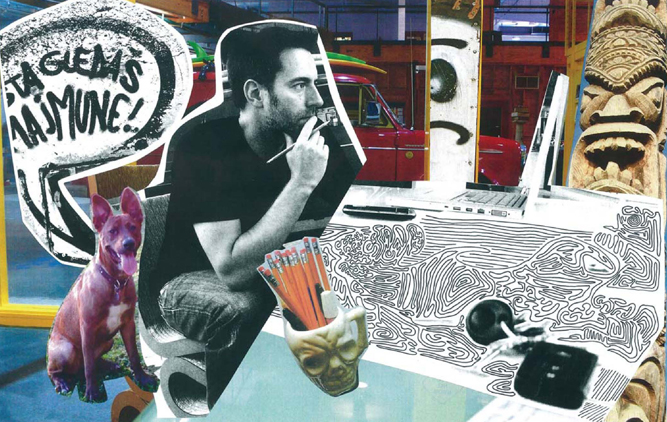

If you've gotten choked up watching a dog food ad in the last couple of years, it's probably thanks to Chris Adams. His words and creative vision transformed Pedigree into the dog food company that loves dogs, building a cult following (just survey dog lovers' blogs) and a place in advertising history.
Looking back, maybe he failed accounting at the University of Maryland for a reason. Maybe those vintage white pearl Ludwig drums he got for Christmas in the fourth grade were his inspiration to do something different. Whatever it was that drove him to find classes where he could get in his own head and explore, Adams thought it would be fun to give the advertising program a try. In 1994, he started an internship at Chiat/ Day (mostly because he needed it to graduate).
In fact, Adams claims a distinction that few creative directors can: He's risen through the ranks at the same agency since he graduated, working in the Jacksonville, Florida, and Washington, DC, Chiat offices before making his way to Los Angeles in 2000. He's created work for Nissan and Infiniti, helped Steve Jobs introduce iMacs and iPods and, most recently, charmed the world with the “Dogs Rule” campaign for Pedigree.
Over the years, his work has remained compelling and authentic, never formulaic. “I find myself breaking the rules a lot,” Adams explains. “I think a lot of creative people do.” He's been recognized by the Cannes Lions International Advertising Festival, Communication Arts, D&AD and The One Show. And he's won best of show at the OBIE Awards and the $100,000 Grand Prize MPA Kelly Award (the money was donated to the Pedigree Dog Adoption Drive). In 2008, he judged The One Show.
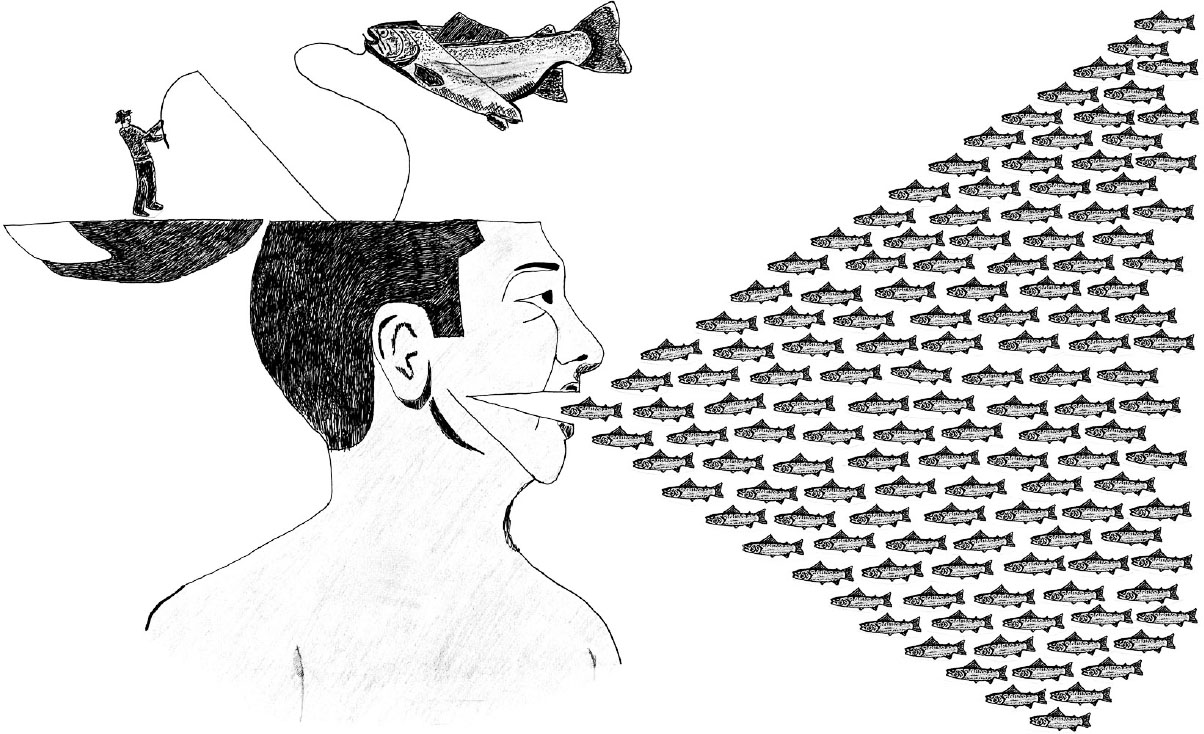

“TAP PROJECT” SAFE DRINKING WATER WEBSITE
Agency: TBWA\Chiat\Day, Los Angeles Chief Creative Officer Worldwide: Lee Clow Chief Creative Officer: Rob Schwartz Group Creative Directors: Chris Adams, Margaret Keene Associate Creative Director: Scott McFarlin Art Director: Paulo Cruz Writer: Ted Kapusta Client: UNICEF United States Fund
When he's not at the office, you can find him on a wave, on the soccer pitch, on his third glass of red wine with his beautiful wife, or on the couch napping with his dog and two cats.
Process
“For me, the process begins with just filling my head with stuff. Devouring media, soaking up the world around me — words and images and music and life. Not because I have a particular assignment that I need them for, but just because I enjoy it. Then, when I sit down to think about ideas for a client, I've got all this stuff bubbling around in my head. There's all this stimuli in there for my thoughts to bounce around on. Sometimes the big idea literally just jumps right out. Other times I have to be more patient, little ideas have to eat up other little ideas and merge with other notions until they're big and strong and can make it on their own. Often, I can't find the ideas myself, and my partner is the one who discovers the ideas locked up in my own head.”
— Chris Adams
Partner
“Chris keeps a regular-sized black journal, and during a meeting when we're getting briefed on an assignment, he'll sometimes scribble little illegible parts and pieces there. This little thought incubates in his mind for a while. Sometimes, I'll find it and sprinkle a little fairy dust on it. Then he'll open his computer, pull up a Word file, and, as he puts it, ‘it pretty much writes itself.’ That's it. Not sure if the end result has anything to do with the original scribble, but what it turns out to be is a fully-formed, strategically sound, beautifully articulated reason to believe in whatever it is we're trying to sell.
“Many creatives are petulant egomaniacs, willing to forego real insights and truths in order to further their own creative agendas. Chris couldn't do that if he tried. If the project is worthy (and even when it's not), he's compelled to find something special about it and turn it into an engaging piece of communication. He's the best kind of partner, always giving ideas freely and embracing them eagerly, then tweaking them perfectly.”
— Margaret Keene, Group Creative Director, TBWA\Chiat\Day
INSIGHTS FROM THE PROCESS CANVAS
You've got to stock the pond to keep the fishing good. Feed your head and it will work harder for you.
A fly fisherman is an artist with tools, carefully landing the best of the lot. The metaphor implies the importance of craftsmanship and precision.
Funneling is a necessary practice. Great volumes of information must be distilled or condensed as solutions get closer.

“DOGS RULE” BILLBOARD
Agency: TBWA\Chiat\Day, Los Angeles Chief Creative Officer Worldwide: Lee Clow Creative Directors: Duncan Milner, Eric Grunbaum Associate Creative Director/ Art Director: Margaret Keene Writer: Chris Adams Client: Mars Petcare US, Inc.

“ADOPTION DRIVE” MAGAZINE AD
Agency: TBWA\Chiat\Day, Los Angeles Chief Creative Officer Worldwide: Lee Clow Creative Directors: Margaret Keene, Chris Adams Art Directors: Jera Mehrdad, Jeremy Boland Writers: Marcin Markiewicz, Eric Terchila Client: Mars Petcare US, Inc.
PEDIGREE® and DOGS RULE® are registered trademarks of Mars, Incorporated and its affiliates. The copyright in the PEDIGREE® advertisements displayed herein is owned by Mars, Incorporated. These trademarks and the PEDIGREE® advertisements are used with permission. Mars, Incorporated is not associated with the publisher.
ADRIAN ALEXANDER
WRITER, THIRD CULTURE KIDZ (AUSTIN, TEXAS)
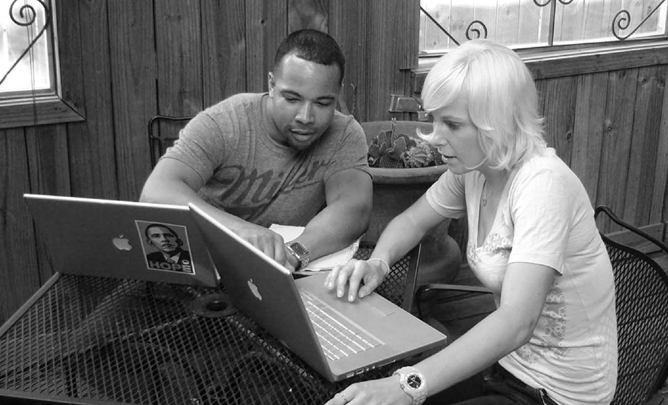
Writer Adrian Alexander and art director Rochelle Raiss consider the business of freelance.
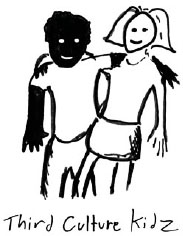
Adrian Alexander lives in a good place. It's that crossroad where opportunity meets talent, a place where work is play and play just happens to build your career. After all, he's a writer.
“I could've taken such a different path,” he says. His German mother gave him a penchant for cooking and languages. His African-American father instilled a love of art and writing. Still, he thought he'd be a scientist when he was growing up. Then, in college, he found advertising. At his senior year portfolio critique, Alexander was offered a job at a small boutique agency in Houston. He accepted, but he soon found that Houston wasn't for him. What should a writer do?
He moved to Europe. By the time he returned a year later after traveling the continent, he had a job offer from Crispin Porter + Bogusky in Miami. A few months later, he moved again, this time to Boulder, Colorado, where the agency opened a new office. Alexander admits that his time at Crispin was the most influential period of his young career, and led him to view problem solving in media-neutral ways and to make messages that are surprisingly compelling.
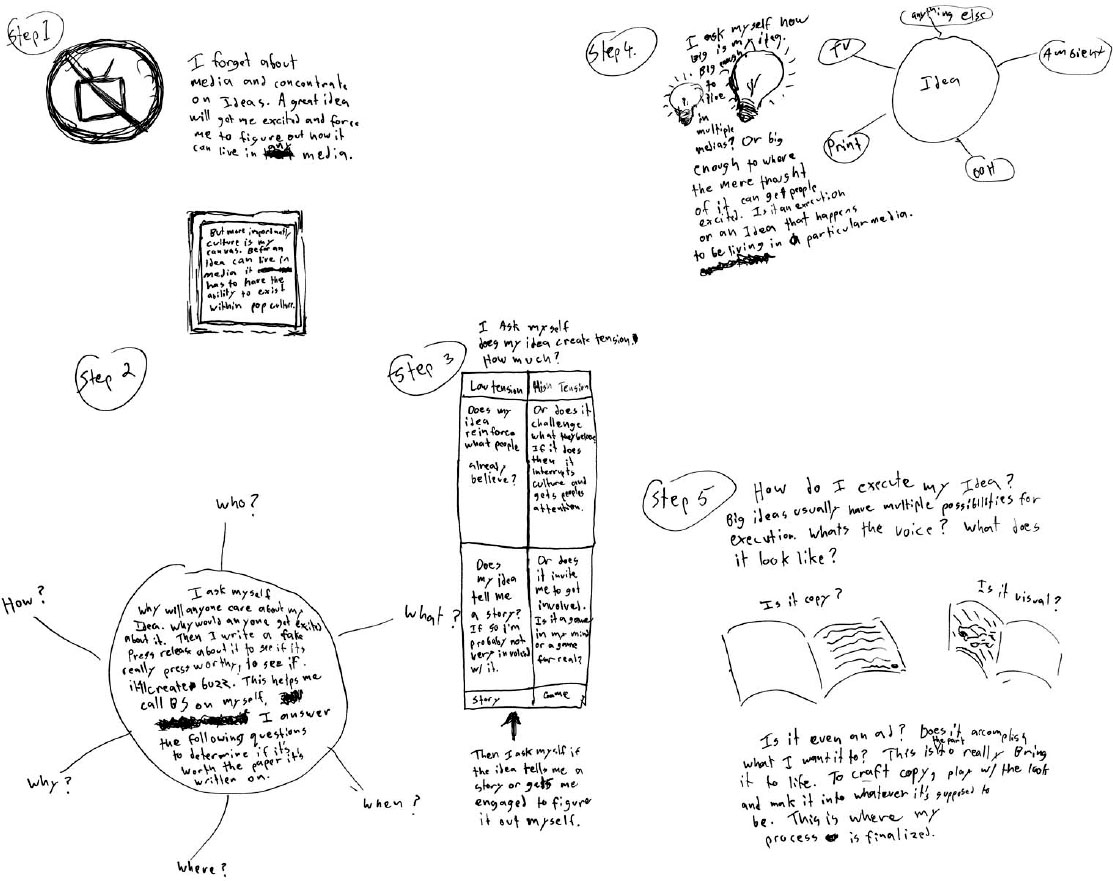
Those in the business of making ads will always be limited by the size of their budgets, but those in the business of creating ideas will be limited only by the scope of their imaginations.
Two years later — with work for Coca-Cola Zero and Giro helmets under his belt — Alexander and his art director partner, Rochelle Raiss, moved to Austin. The name of their shop, Third Culture Kidz, is an homage to the post-postmodern freelance lifestyle.
Process
“At some point I asked myself, ‘Am I in the business of making ads, or am I in the business of creating ideas?’ And yes, there is a difference. Making ads forces one to think inside conventional media boxes. Ideas, on the other hand, aren't bound by the rules of advertising. They can transcend the conventional constraints, and if they're big enough, even infiltrate hearts, minds and culture as a whole. Those in the business of making ads will always be limited by the size of their budgets, but those in the business of creating ideas will be limited only by the scope of their imaginations. Because great ideas don't need mass communication to be heard; their mere existence is enough to get people talking. As a result, they diffuse through culture organically. In other words, when you're in the business of creating great ideas, people become your ‘media.’ So, with this in mind, maybe you should ask yourself, ‘Which business are you in?’ I, for one, am going with the latter.”
— Adrian Alexander
Partner
“Every now and then life throws us one of those rare coincidences. Mine happened when Adrian and I started our new job on the same day. We quickly realized that we both had a similar upbringing — we share a German heritage, and we both speak the language. Also, we both worked at CP+B, and we share a common desire to not settle for mediocrity. As a result, we're constantly challenging one another. But more than anything else, no matter what this business throws at us, we always find a way to make each other laugh. It's how every great partnership should work.”
— Rochelle Raiss, Art Director, Third Culture Kidz
INSIGHTS FROM THE PROCESS CANVAS
Organizing and visualizing data is important in determining a path; that is, working out your strategy in pictures and words.
Many questions lead to many answers and, sometimes, to even more questions.
Advertising is never created in a vacuum. The phrase “culture is my canvas” emphasizes the importance of context.
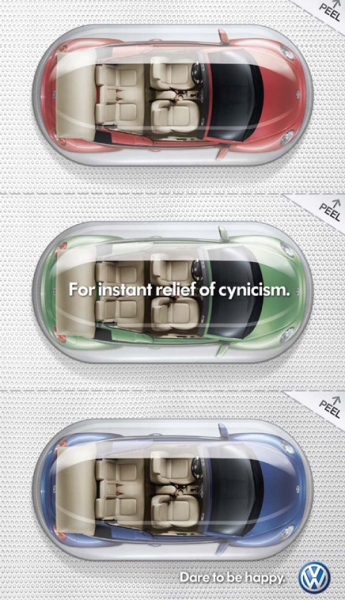
“DARE TO BE HAPPY” MULTIMEDIA CONCEPT
Agency: Crispin Porter + Bogusky Art Director: Laura Hausman Writer: Adrian Alexander Client: Volkswagen®
The Volkswagen® trademark is used with permission of Volkswagen Group of America, Inc.
ANDY AZULA
SENIOR VICE PRESIDENT/CREATIVE DIRECTOR, THE MARTIN AGENCY (RICHMOND, VIRGINIA)
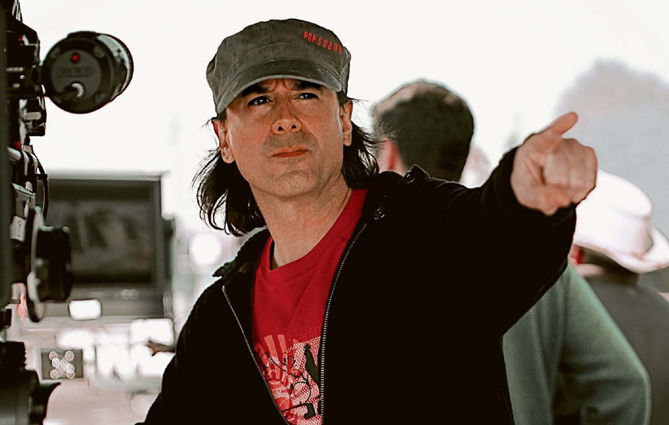

Yes, you've seen that guy somewhere before. Andy Azula is the creative-director-turned-UPS-spokes-character who's become famous starring in his own work. Oddly enough, he never auditioned for the gig. After several casting calls, UPS executives and focus groups decided they liked Azula's delivery (pardon the pun) better than any of the actors', and a star was born.
Even though Azula gets recognized on the street more often these days, his name was already well known in the advertising business. Prior to becoming the senior vice president and creative director of The Martin Agency, Azula worked at Goodby, Silverstein & Partners and McCann Erickson in San Francisco; Fallon Worldwide in Minneapolis; and Loeffler Ketchum Mountjoy (LKM) in Charlotte, North Carolina. He has been involved in developing campaigns for Microsoft, BMW, Lee Jeans, Nikon, Budweiser and the Wall Street Journal, to name a few. His work has been recognized by Communication Arts, The One Show, Cannes Lions International Advertising Festival, the National ADDY Awards, the Clios, the MPA Kelly Awards, and the magazines Archive, Graphis and Print. He also sits on the board of The One Club for Art & Copy.
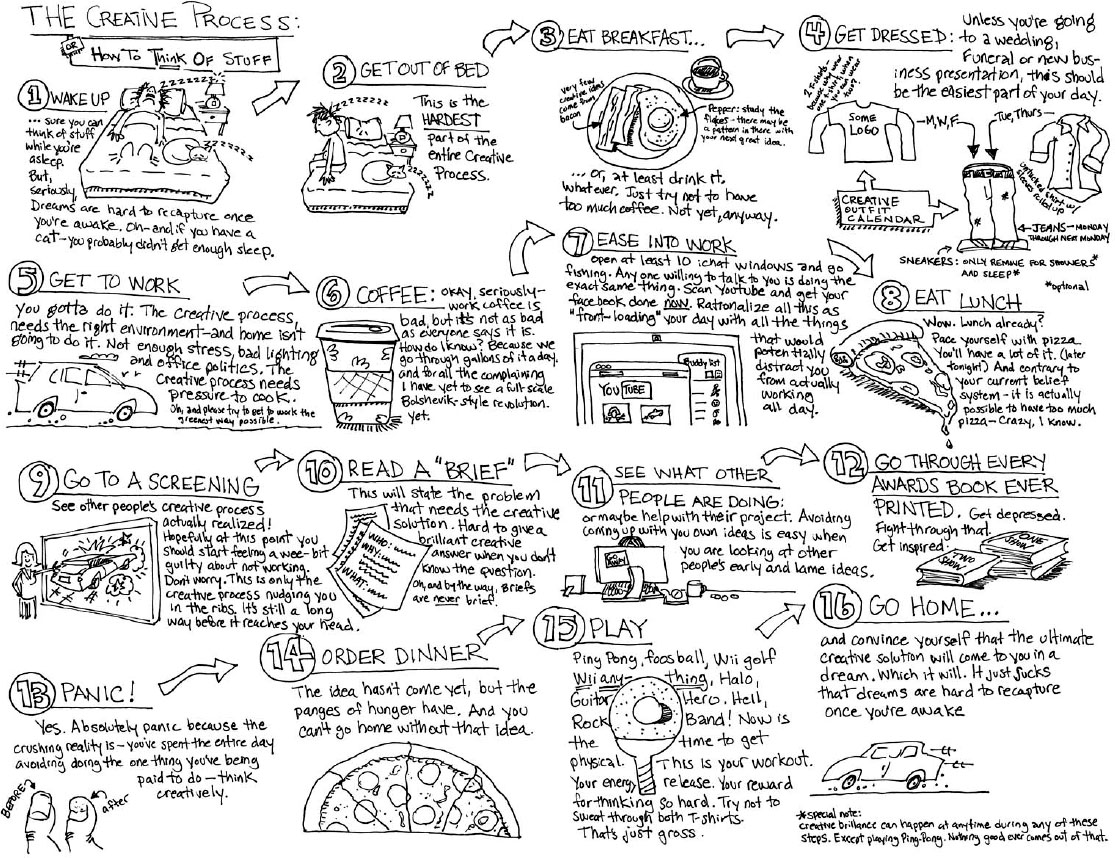
Spend some time, no matter how counterintuitive it seems to your gut and to the deadline, and figure out what the problem really is.
Process
“Remember the dreaded blank piece of paper? It's become the blank Word doc, the blank InDesign page and the blank Photo-shop canvas.
“But the beauty of these things is that they are just that: blank slates. Chances for originality. Chances to create movements. Opportunities to make a difference. Opportunities to fail.
“For me, the process of creativity is messy, chaotic and disorganized. There is only a certain amount of science to it. So, I think it's important to start there. Use that little bit of ‘science’ to build the wings before you jump off the cliff of thinking. And the easiest way to do that is to resist the urge to jump in the first place. That's right. Spend some time, no matter how counterintuitive it seems to your gut and to the deadline, and figure out what the problem really is. Because the better you understand the actual problem, the easier it is to deliver a solid, memorable and creative answer. Or, to even deliver a whole new opportunity. Shocking, I know. But you'd be surprised how many wrong answers are out there. The right answers are those that we remember, make us laugh, make us love, and that move us.
“And remember that dreaded blank page? Well, look… it's filled. Now that wasn't so bad, was it?”
— Andy Azula
Partner
“Andy came to The Martin Agency with a very impressive résumé in tow, so the expectations were pretty high when we first started working together on UPS … and he did not disappoint. And I'm not just referring to the work itself, because that goes without saying. What impressed me the most was how he immersed himself into UPS's business; to really understand their business problems at the core and how their diverse products and services needed to be communicated in order to solve those problems. That's a daunting task considering UPS's global size and scope, but Andy took on that personal challenge and emerged with a better understanding of what UPS does than all of the people who had worked on the business for the past three years. He then takes that knowledge and blends it with his unique creativity, which results in business-improving work for the client.
“I've had the pleasure of actually working alongside him during the creation of some of our whiteboard spots, and I'm truly amazed each time. It's fascinating to watch his mind work. Whether it's his own idea or improving someone else's, Andy continually reverts back to the business and campaign objectives to make the work better. The clients can see and appreciate the thought that goes into each Azula-inspired TV spot or print ad, which builds the trust and confidence that Andy is a steward of their brand and is genuinely looking out for their best interests. It's not about creative awards; it's about the results. And that's what makes Andy such a rare talent in today's world of self-promotion and ‘me-first’ attitudes.
“I'm proud to call him my colleague and friend.”
— Tedd Aurelius, Vice President and Account Director, The Martin Agency
INSIGHTS FROM THE PROCESS CANVAS
Life and work inevitably intersect, particularly when you work sixty-hour weeks, give or take twenty hours. It can become difficult to separate the two.
Guess what? Senior-level creatives still panic. Years of experience build confidence and craft, but even seasoned pros feel the pressure to find that next great idea.
So you want to make advertising? Here's hoping you like pizza and coffee — the breakfast, lunch and dinner of creative champions.
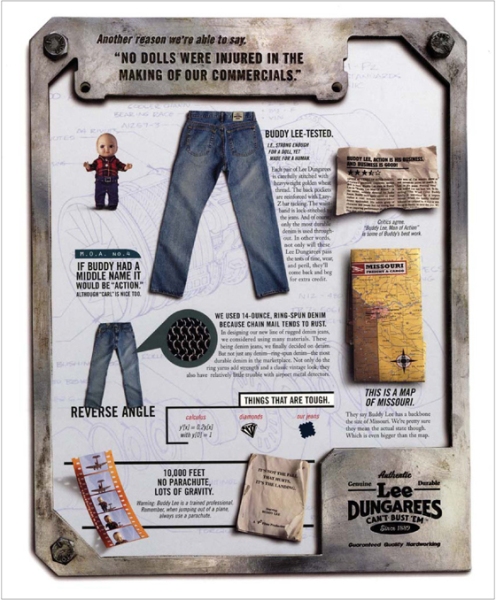
“BUDDY LEE” MAGAZINEAD
Headline: Another reason we're able to say, “NO DOLLS WERE INJURED IN THE MAKING OF OUR COMMERCIALS.” Agency: Fallon World-wide, Minneapolis Creative Director: Harvey Marco Art Director: Andy Azula Writer: Greg Hahn Client: Lee Jeans
© 1990 Lee Jeans, a division of VF Jeanswear Limited Partnership
DAVID BALDWIN
LEAD GUITAR, BALDWIN& (DURHAM, NORTH CAROLINA)
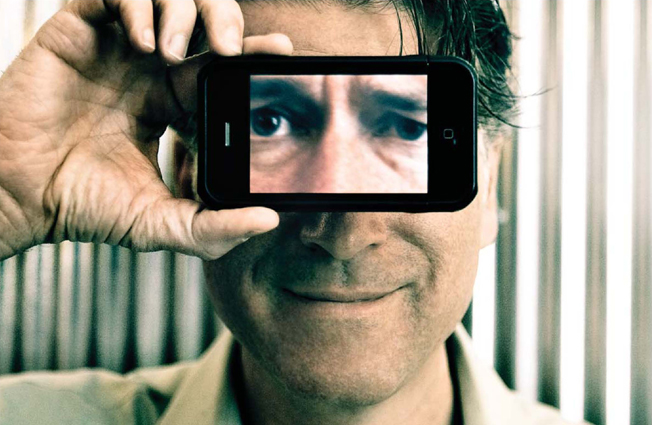

How does it feel to be at the top of your game? David Baldwin, one of the most awarded writers and creative directors in the advertising and branding business today, recently formed Baldwin&, a project-oriented creative shop in Durham, North Carolina. Baldwin is there, at the top, inventing and wondering how to do the next big thing. That's how he works. His entrepreneurial agency model is a natural result of his noteworthy work around the country, where over the last couple of decades he crafted smart advertising at Deutsch in New York, Hal Riney in San Francisco, Cole & Weber United in Portland, Oregon, and Leonard/ Monahan in Providence, Rhode Island.
At McKinney (also in Durham), his creative leadership resulted in global visibility for the agency and a stretch of award show honors that make other agencies envious. Baldwin also served as the chairman of The One Club for Art & Copy, the force behind The One Show, for five years. In that role, he was a champion for the best in advertising and the profession, urging creatives to new levels of innovation, responsibility and leadership in the advertising world. That's how fame pays it forward.
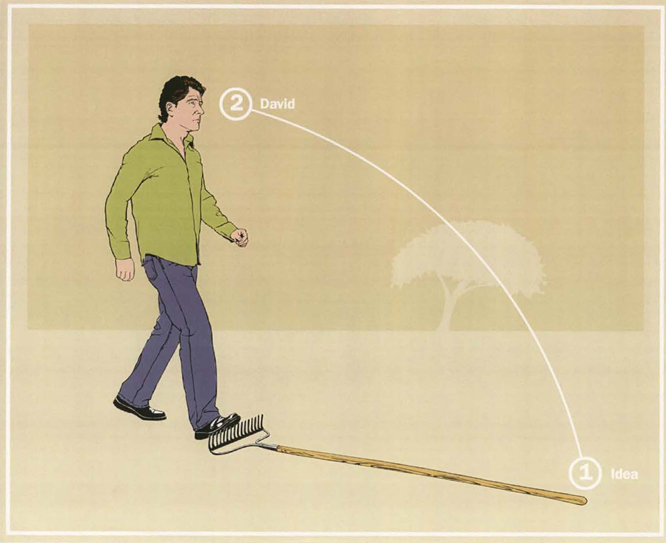
I just spew and spew thoughts, write them down, and then the trick is figuring out which ones are any good.
Baldwin's creative life extends beyond advertising. He's an executive producer on the film Art & Copy, which premiered at the 2009 Sundance Film Festival. And, there's always his music gig to fall back on. He's a guitarist and songwriter for the band Pants, whose album, Twice the Snake You Need, was released recently.
Process
“I'd love to say that it's hard work and discipline that lead to great ideas, but it's a much wispier process than that. Ideas just kind of happen for me. I look at it like this: Great ideas are already out there, you just have to find them. So I just spew and spew thoughts, write them down, and then the trick is figuring out which ones are any good. I have noticed that I think differently when I'm talking versus sitting, writing by myself. I'm able to make more interesting leaps and connections. I call it working by conversation. It's always worked for me.”
— David Baldwin
Partner
“When David approves your idea, it really means you're only at the beginning of the process.
“This is because he loves to poke things. At no point in the process is he done poking, and, therefore, neither are you. Poke, poke. And when you're both done poking things, it's only because it's time for the piece to run. Often, the only similarity between the original idea and the final product is the client's name. (If it's something you filmed, then some of the locations might vaguely make the cut.)
“And you know what? It's usually better than what you presented.
“An example (a non-advertising one): The idea was to get together and play instruments after work. Pretty solid.
“Poke. Poke, poke.
“Cut to a year later. I'm crouched onstage at the Rock and Roll Hall of Fame, wearing tight leather pants and mascara, shrieking in David Lee Rothian falsetto in front of a packed house as David plays a blistering guitar solo with one hand and eats a sandwich with the other as a TV camera swoops by on a crane.
“See? Better.”
— Mitch Bennett, Associate Creative Director and Writer, GSD&M, Austin, Texas; Guitarist, Pants
INSIGHTS FROM THE PROCESS CANVAS
Breaking the rules is sometimes part of the process. Ask a pro for a doodle, get a polished illustration in return.
Some of the most talented creatives in the business make it look easy. But don't be fooled.
The best ideas are sometimes the ones you never saw coming.
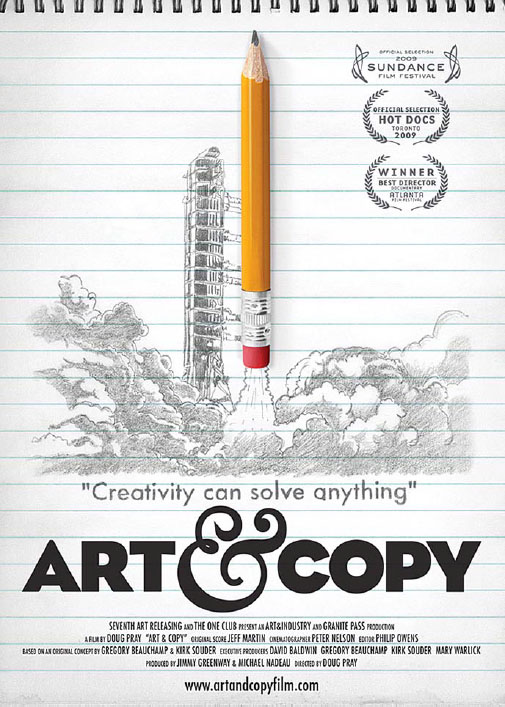
“ART & COPY” DOCUMENTARY
Executive Producers: David Baldwin, Gregory Beauchamp, Kirk Souder, Mary Warlick (based on an original concept by Gregory Beauchamp and Kirk Souder) Director: Doug Pray Cinematographer: Peter Nelson Editor: Philip Owens Original Score: Jeff Martin Producers: Jimmy Greenway, Michael Nadeau
An Art & Industry and Granite Pass Production. © 2009 The One Club.
Poster Design: Mike Hughes of Butler, Shine, Stern & Partners (Sausalito, California)
DUSTIN BALLARD
WRITER, THE RICHARDS GROUP (DALLAS, TEXAS)

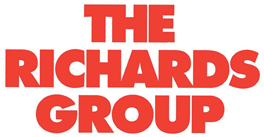
In 2004, Adweek called Dustin Ballard one of the “best creatives you've never heard of.” Since then, Ballard has been working hard to buck that title. Since he graduated from the University of Texas at Austin in 2003, his writing has been recognized by The One Show, the Cannes Lions International Advertising Festival, the ANDY Awards, the London International Awards and Communication Arts. In 2007, Ballard was one of twelve art directors and writers under thirty years old selected by the Clio Future Gold | Young Creatives Program to elevate and inspire young talent in the industry. That's what you call a running start.
Ballard began his career at Crispin Porter + Bogusky, where he worked on Mini Cooper, Virgin Atlantic, Burger King and the American Legacy Foundation's “Truth” anti-smoking campaign. He sold his first television script to a client to which he wasn't assigned. Sixteen spots and two years later, that initiative paid off. In 2006, the Texas native joined The Richards Group in Dallas, where he works on the Chick-fil-A, Orkin and Amstel Light accounts, as well as new business pitches.
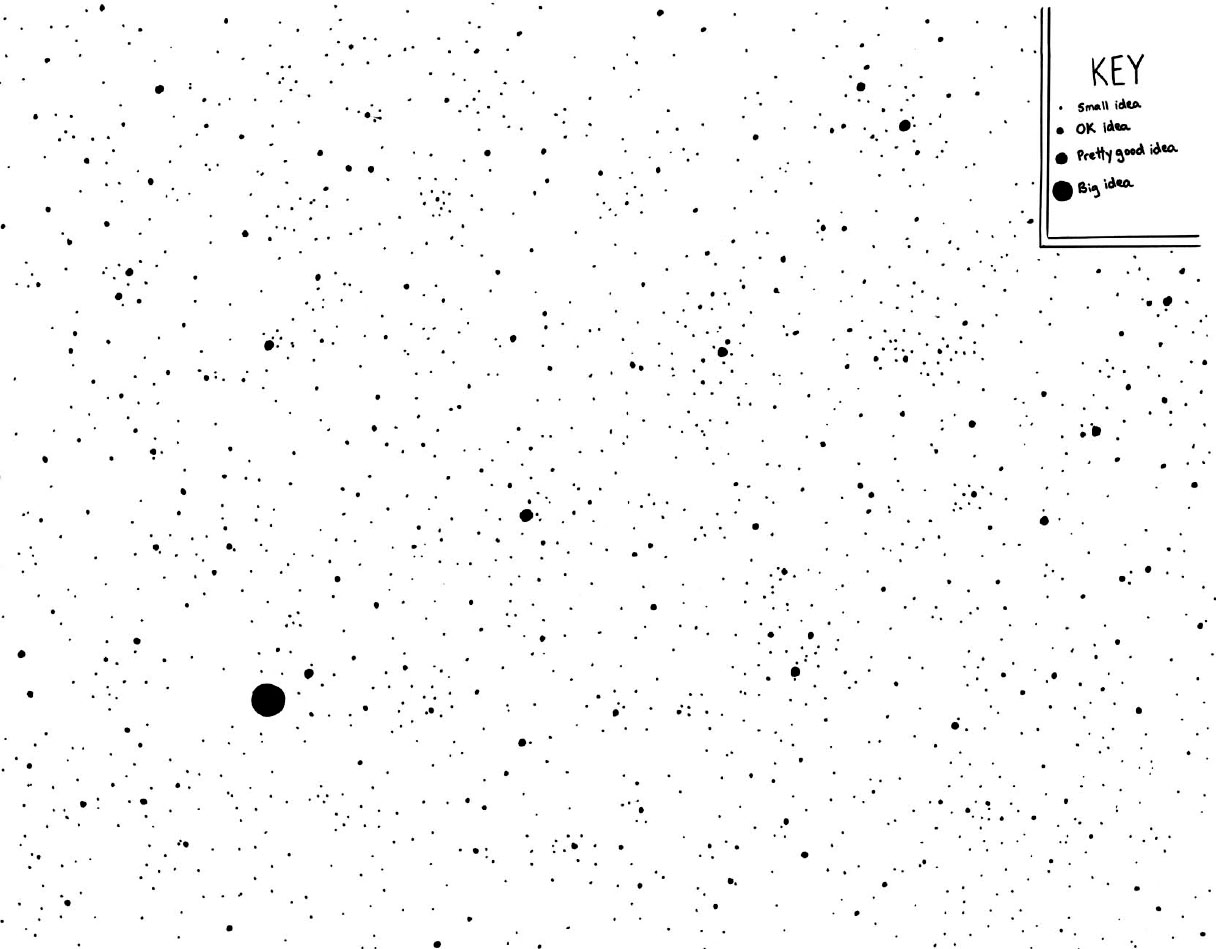
An accomplished fiddle player, Ballard also won first place at the Battle of the Ad Bands in New York. In this business, it's smart to have a second career already mapped out.
Process
“My brain hates creativity. Like most cerebrums, mine spends 99 percent of its day following pre-worn thought paths and shortcuts. I don't re-invent the way I brush my teeth every morning. My brain would disown me.
“For me, advertising is a battle against my brain. A battle against process itself. It's not about accumulating a toolbox of ‘tricks’ to reach a solution; it's about finding the truth behind what you're saying and throwing everything else out. With that said, there are a few rules I do like to follow:
“Drift off course. For me, getting off topic is a defense mechanism. La La Land is where my mind resets itself so I can pounce on an idea with fresh eyes. It's not about losing focus; it's about avoiding the frustration and close-mindedness that comes from chaining yourself to a brief for three hours.
“Don't settle. The way I figure, if an idea doesn't excite me, it won't excite a stranger whose TV show I just interrupted. Don't stop at the first workable idea you have. It's not the best.
“Learn to ‘love 'em and leave 'em.’ Many of my favorite ideas have died for awfully silly reasons. It's just a universal fact of advertising. Some creatives spend their time sulking. Others strike back with even better ideas.
“Finally, don't live in a bubble. Those who are cultural sponges are the most interesting people. And interesting people have interesting ideas. Explore. Learn. Listen. Let the world improve your advertising; don't make advertising your world.”
— Dustin Ballard
Partner
“Dustin is the best writer I know. His creative process is something I can count on even though it differs with each new challenge. I can count on him to stay calm. His ability to avoid becoming distracted by his emotions (being frazzled, whiny or moody… unlike many other brilliant creatives) keeps his focus on the real question at hand: How do we make this great?
“Dustin is a brilliant fiddle player. I believe he also uses that part of his brain to fuel his creative process. When writing, he keeps in mind that the best songs (and ads) are ones that surprise. They must grab you and make you remember something, make you feel something.
“He doesn't stop until all of the pieces fit. Until they sing.
“When we work together, there is a rhythm. He doesn't stop with one thought. He leads it to the next, and the next. Never a naysayer, he suggests, ‘Let's try it,’ or ‘Let's build on it.’ At bumps in the road, we take time to walk away from the idea, and go run around outside, act goofy and let our inner kid take over. Sometimes, that's the secret to finding the best stuff: Leave it be.
“Dustin knows that developing great work is the (relatively) easy (well, sorta) part of the job. Selling it is the hard part. One of the things I appreciate about Dustin is his flair for presentation. Sometimes, creative teams feel the need to offer clients an over-the-top song and dance when trying to sell them on an idea. Dustin wants the work to sell itself — with a little nudge, if necessary.
“I call Dustin ‘The Silent Killer.’ He's the soul of calm, modesty and focus while doing great work that everyone wants to emulate.”
— Jill Efrussy, Art Director, The Richards Group
INSIGHTS FROM THE PROCESS CANVAS
Ideas come in different sizes. Those big ideas are good ones because they hold the greatest potential to solve big problems.
Notice the “key.” Writers want to be sure you understand. That's a big part of their job.
The search for the best idea among myriad possibilities is a journey creatives must be willing to make.
MATTHEW BARBER
WRITER, BARKER/DZP (NEW YORK, NEW YORK)
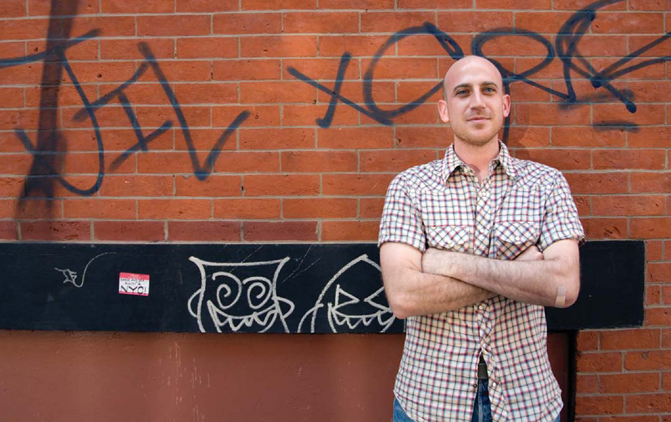

While growing up, Matt Barber was sent to church five times a week. He wasn't particularly evil or anything, his parents just seemed to think that much churching was about right. All that time spent in the pews gave Barber ample time to daydream and exercise his creativity — building a rich fantasy life for himself that may have startled his pastor.
Today, Barber is a writer at Barker/DZP, a creative boutique in SoHo that lists the History Channel, Major League Soccer and the G4 network among its clients. He previously worked at StrawberryFrog (also in New York City) and worked on Micro-soft, Heineken, Volvo and Manwich accounts.
When Matt Barber is not wordsmithing ads, he's writing short stories and scripts and telling well-crafted jokes at parties.
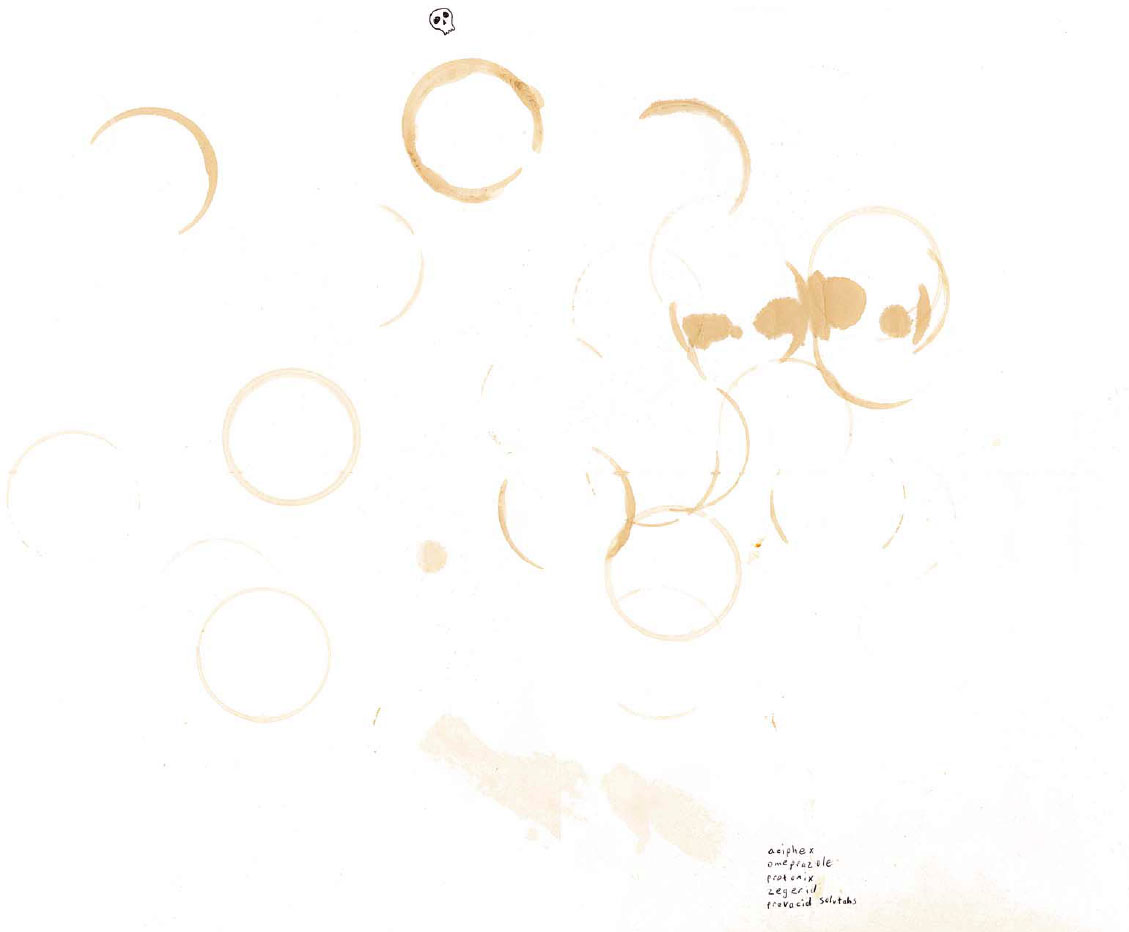
I'm not sure whose bright idea it was to start tearing down agency walls, but I hate him.
Process
“Process? That's funny. I work in a large room with about twenty other people, and distractions abound. Between meetings at the big table in front of me, meetings at the art director's desk to the left of me, meetings at the art director's desk behind me, impromptu water-cooler-type conversations to the right of me, loud bellowing over beers in the kitchen, the editor cutting something with the volume on eleven, somebody doing something smelly in the bathroom a few feet from my desk, and some pissed off co-worker just walking around and mumbling under his breath, it's amazing I get anything done. I'm not sure whose bright idea it was to start tearing down agency walls, but I hate him. I mean, most writers describe putting words on the page as a solitary endeavor, so how did we get to a place where copywriters are sitting in a room full of people? I'd do anything for an office: just a place to shut out the noise and have a little quiet so I can hear the writer in my head.
“That being said, I think one of the most important keys to being creative is just to be available. Inspiration can be a slippery thing; even the ancient Greeks knew the Muses were bitches. So when it comes, I try to seize it. To have the pen and paper ready. To catch whatever's coming before it turns foul. It may mean long hours, a lot of coffee, more acetaminophen and even more prescription strength antacids, but when something comes together that you can really be proud of, it's all worth it.”
— Matt Barber
Partner
“Matt and I were hired together as a junior team at StrawberryFrog right out of school. If you asked me then about his creative process, I'd have probably shrugged my shoulders a bit. But now that I've worked with a couple of other writers, I can look back and recognize the unique ways Matt thinks.
“I would describe Matt as a purveyor of culture. Matt watches more movies than anyone I know. He reads more books. And he's a copywriter who loves art, which was always fun for me. He's always seeking out new things. He once asked me to teach him some things in Photoshop. Then he Photoshopped mustaches on pictures of me for the next twenty minutes.
“Matt liked introducing new things to me. He would check out books for me at the library near his apartment in Brooklyn. On Fridays in the summer, Matt would be the first to say, ‘Hey, let's go to a museum.’ I remember Matt and I went to the Museum of Modern Art one afternoon and everything we saw reminded us of a vagina or a penis. (If you know Matt, you know he has a very fun, twisted sense of humor.) Overall, it was Matt's constant consumption of culture that really brought a lot to the way we worked. If we were ever stuck during a brainstorm, we always had a ton of things to talk about until the ideas starting kicking in again.”
— Laura LeBel, Art Director, Mendelsohn Zien, Los Angeles
INSIGHTS FROM THE PROCESS CANVAS
Being creative for a living can amount to a Faustian bargain. You're hired to be brilliant and to deliver what's new and fresh every day, all day long. You figure out how to keep going and try not to self-destruct somewhere along the way.
There's something about caffeine and creativity. Art directors and writers consume enough energy drinks, sodas and espressos to keep those product categories profitable.
Here's a writer with an artistic eye. There are more of them out there than most art directors might want to admit.

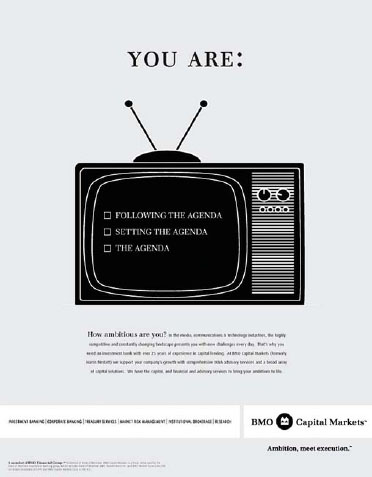
BMO CAPITAL MARKETS MAGAZINE ADS
Tagline: Ambition, meet execution. Agency: StrawberryFrog, New York Chief Creative Officer: Scott Goodson Executive Creative Director: Kevin McKeon Creative Director: Brian Platt Creative Director/Art Director: Tricia Ting Writer: Matthew Barber Client: Bank of Montreal
ROSS CHOWLES
CO-FOUNDER/EXECUTIVE CREATIVE DIRECTOR, THE JUPITER DRAWING ROOM (CAPE TOWN, SOUTH AFRICA)
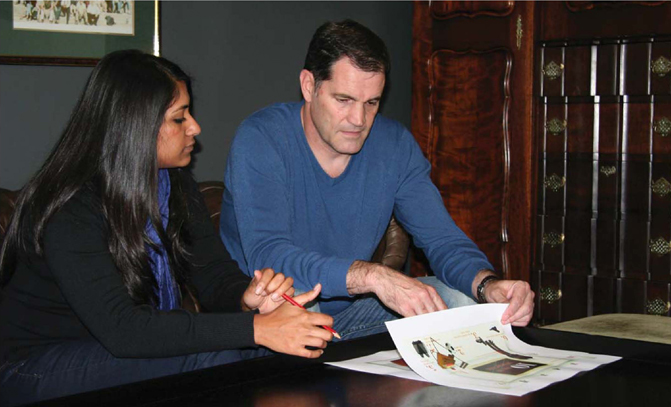
Ross Chowles leads young creative Samita Brinjal through a critique in TJDR offices.
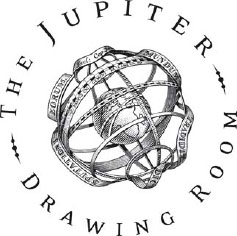
Young creatives of the world, take note: There is a world outside New York City. Across the globe, at a beautiful shop in Cape Town, South Africa, you'll find a terrific advocate for good work: Ross Chowles.
Chowles based much of his professional career on creating smart design and building new agency models and, in the process, became an expert manager of creative talent. He shares his passion for advertising easily. He fantasizes about being a teacher (someone should tell him he's been teaching for a while now). Witness “The Ripple Effect,” an educational initiative for young students he launched in 2004, as well as the successful juniors he has coached through his three-decade career. Or consider his annual trek to The One Show Workshops in Beijing and Shanghai where he enlightens hundreds of Chinese students about the business. Chowles loves the way students and newly minted professionals think, and he loves the creative spirit of people still eager to learn.

Chowles has judged shows in France (Cannes Lions), New York (The One Show, the Art Directors Club of New York, the Clios), Canada and even Namibia. He has also won his fair share of awards around the globe. As executive creative director and co-founder of The Jupiter Drawing Room, he is the force behind the most awarded independent agency in Africa. “South Africa is the collision of cultures, the tension between the past and the future,” he wrote on a recent African design blog. “This creates an environment of energy, the perfect energy for creative thinking.”
Even with his heralded career and international influence, what his colleagues and friends often comment about first is Chowles's giving nature. “Ross is a talented painter,” says Kevin Swanepoel, president of The One Club for Art & Copy in New York. “He paints beautiful portraits of people who have touched his life.”
Process
“The part I love in the process is when you crack the idea and suddenly all of the possibilities come flooding forward, unfolding, growing. It's like a mental orgasm mixed with a sense of relief.”
— Ross Chowles
Partner
“There are two defining features of Ross Chowles's creative process that his drawing accurately reflects.
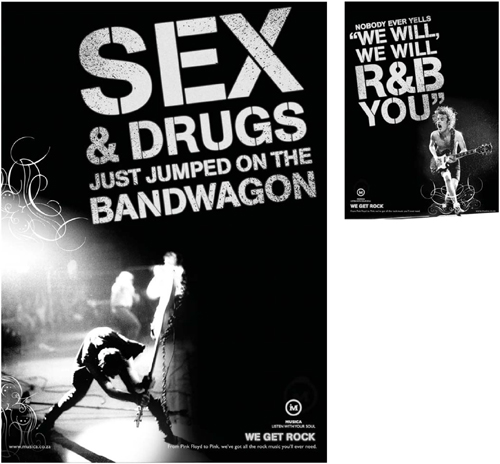
“WE GET ROCK” POSTERS
Agency: The Jupiter Drawing Room, Cape Town, South Africa Executive Creative Director: Ross Chowles Creative Director: Darren McKay Art Director: Ashraf Majiet Writer: Sanjiv Mistry Client: Musica
“The first is that Ross's process is dead simple; just about as uncomplicated as he is. That means no fancy modeling or complex intellectualizations. And the implication is that ideas can come from anyone. Everybody is welcome to join in and everybody does. No hierarchy, no exclusivity, no over-the-top creative egos.
“The second is that his process borrows on the most human of activities; like listening and wallowing and vomiting. And this is relevant because it is everyday life in all of its messiness which Ross draws on as his inspiration. It means that each of his ideas carries a little piece of Ross hidden at its heart. But more importantly, because ideas that are based on real life make for work that speaks to the human in all of us, Ross creates work that touches hearts.
“What this representation fails to show is the laughter that fills all the space in between. More than anything, working with Ross is fun: laughing as much at each other as we do at ourselves!”
— Claire Cobbledick, Deputy Managing Director, The Jupiter Drawing Room
INSIGHTS FROM THE PROCESS CANVAS
The belief that a good idea will come can sustain you. Try to enjoy the wait.
Do more listening than talking and you'll get smarter, faster. Just listen.
Tenacity is a continuous thread here. This guy has perseverance and confidence.

“KINGS OF THE COURT” POSTER
Agency: The Jupiter Drawing Room, Cape Town, South Africa Executive Creative Director: Ross Chowles Art Director: PJ Kensley Writer: Ahmed Tilly Client: Mentos
TOM CHRISTMANN
CREATIVE DIRECTOR, JWT (NEW YORK, NEW YORK)


Tom Christmann's passion for social media combined with his ability to find the big idea and tell a brand story have led him to work at some of the best agencies in New York, most recently as a creative director on Microsoft at JWT. He also once rode an elevator alone with David Ogilvy. Yes, that David Ogilvy.
Prior to working at JWT, Tom was executive creative director at Cliff Freeman & Partners, where he helped to bring Cliff Freeman's unique brand of impactful storytelling into the twenty-first century on brands like Quiznos and Baskin-Robbins. And he helped create a snazzy new website for an agency that wasn't known for its digital chops.
Christmann also worked at Taxi in New York. As creative director there, he helped build entirely new integrated campaigns for Amp'd Mobile, Blue Shield of California, Molson Canadian beer and the Versus television network.
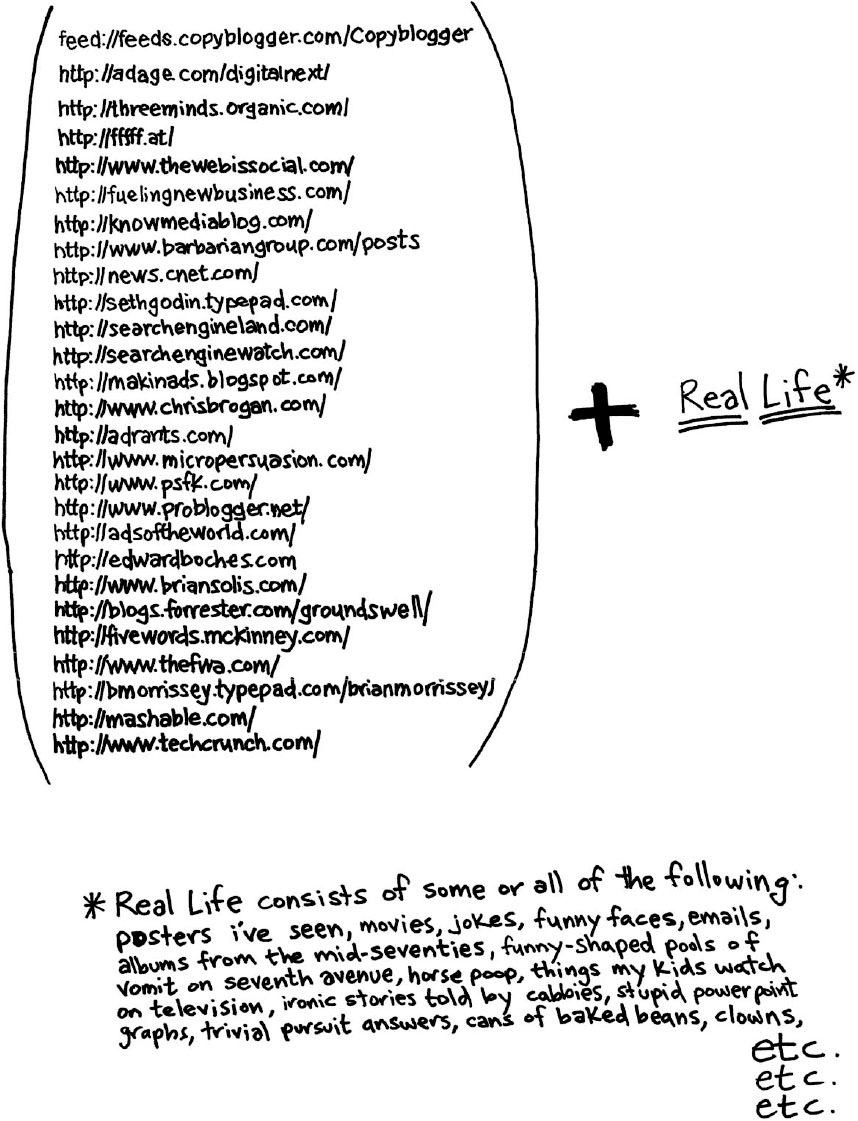
Ideas do not come out of thin air. Ideas only come out of combining other ideas. So the secret to coming up with ideas is to learn about lots of stuff.
As a creative director at BBDO in New York, Christmann was lucky enough to work directly with some of advertising's biggest names, including David Lubars and Eric Silver, and on some of the world's biggest brands — FedEx, eBay, Guinness, Red Stripe and AOL, to name a few. Christmann credits his six years at Kirshenbaum Bond & Partners in New York — as well as his first job at Ogilvy & Mather Direct — with giving him an appreciation for proven results and new technologies.
Christmann's work has been awarded Cannes Lions, One Show Pencils, ANDYs, ADDYs, Effies, Clios and an FWA (Favourite Website Award). He's also training to become a Lexulous champion on Facebook.
Process
“I submit that there is no such thing as imagination. At least not the way that most people think of it: the ability to come up with ideas and stories out of thin air, making stuff up. But I think that the human brain cannot make up something it's never seen or experienced or learned about. Ideas do not come out of thin air. Ideas only come out of combining other ideas. So the secret to coming up with ideas is to learn about lots of stuff. The more you know, the more you can combine and juxtapose. And people will think you have an amazing imagination. But you'll know better.”
— Tom Christmann
Partner
“Tom and I began working together at Taxi, New York, several years ago. At the time, we met on our mutual first days on the job. We quickly became a solid team and worked on everything from Amp'd Mobile to Blue Shield to the Versus TV network to numerous successful new business pitches including Molson Canadian. We're both comfortable developing traditional and nontraditional ideas — whatever feels right for the brand and strategy — and we produced a bunch of work I'm proud of. He's a true writer in that you can sit in a room with him blurting out ideas back and forth, take off for a bit and come back, and not only is everything funnier than you thought it could be, it also sounds smarter and makes a hell of a lot more sense. Ideas only get better in Tom's hands.
“One thing that makes Tom such a great partner is that he's an old school idea guy. Tom never just comes up with one good idea and then calls it a day. He generates and generates and generates great concepts. Tom truly believes that ideas are not precious. And unlike some writers, Tom is a true craftsman. He really gets how an awkward pause here and there or an observational feeling wide shot instead of some cool camera angle can allow a funny idea to become even funnier as well as how his choice of words can convey the right emotion. It was a lot of fun to work together, not only on having an idea but on figuring out the best way to tell it. In this incredibly demanding business, it's easy to become stressed, but we'd grab a beer, relax and keep at it.”
— Scott Bassen, Creative Director/ Art Director, JWT
INSIGHTS FROM THE PROCESS CANVAS
A list of websites constitutes a reservoir of cultural capital used for inspiration and (let's be honest) much-needed distraction.
The word “advertising” doesn't appear in the “real life” list. An abiding love for the business doesn't mean there can't be some space for horse poop.
IAN COHEN
CO-FOUNDER/CREATIVE DIRECTOR, WEXLEY SCHOOL FOR GIRLS (SEATTLE, WASHINGTON)
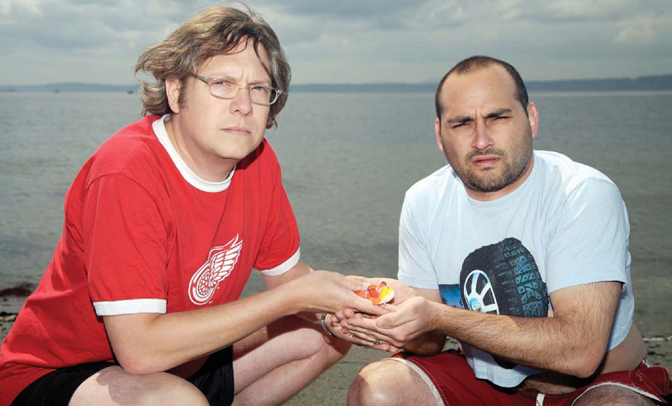
Wexley School for Girls co-owners/creative directors Cal McAllister and Ian Cohen on the shore of Puget Sound.
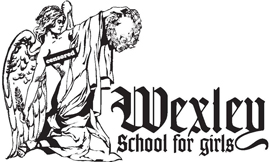
What are we to think about the irreverence of these Wexley characters? First, after dynamite stints at Hammerquist & Saffel in Seattle and Wieden+Kennedy in Portland, Oregon, working on brands like Nike and K2, Ian Cohen (with creative partner Cal McAllister) had the nerve to start an agency that really doesn't sound like an agency. Then, he billed the place as an agency that is media neutral, singing their pitches to clients and using fart jokes like hammers, doing advertising that nobody thought of as advertising (362-degree introverted bipolar branding?). As it turned out, that's how a new little agency got featured in Inc. magazine.
It's obvious Ian Cohen likes this game. He went to school in North Carolina, loves his family and basketball, wears crazy T-shirts in the office and holds office meetings at picnic tables. In his spare time, he judges international award shows and speaks to advertising students around the country.
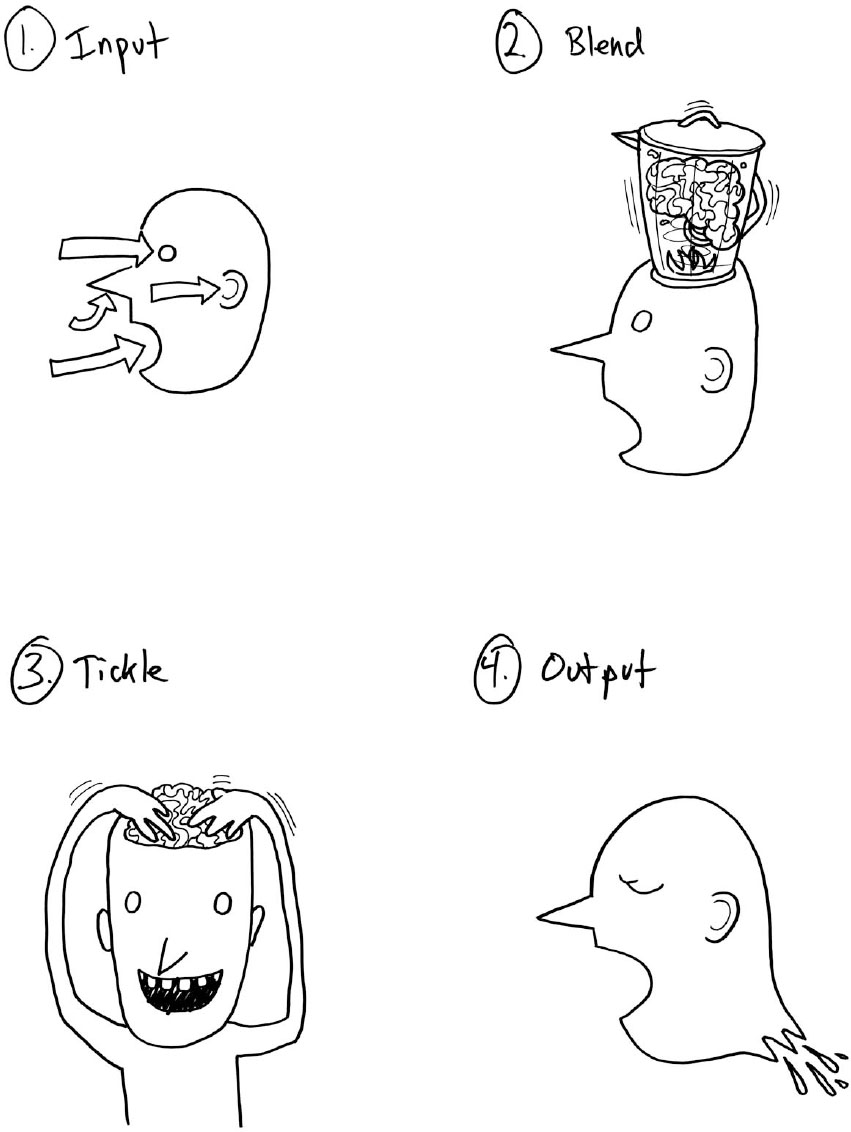
I like to pretend that I'm not at work so that any thinking doesn't seem work-related.
Cohen and McAllister lead a merry band working for Microsoft, Copper Mountain Ski Resort, Hyper-V Server, Brooks Sports and Pepsi, among other clients. They carve out smart little projects, take viral marketing where it should go and solve serious business problems in comedic and unexpected ways. As one Wexley team member explains: “You have to be really smart to have this kind of fun and make it work. That's Ian.”
Process
“As far as thinking goes, I usually don't have to clear my head too much because it's already fairly empty. I just have to move the Duke basketball thoughts over to the side a little. There are several ways I think. I like to pretend that I'm not at work so that any thinking doesn't seem work-related. Additionally, I like to do my thinking in stimulating places, not my office. I like having motion, distractions and things to look at to spur on thought fragments.
“When I'm concepting for advertising, I need to know my target inside and out; then, my thinking turns into more of a conversation. Depending on the subject, I like to know what other work has been done in that arena, so I can mentally start in a totally different place. Maybe I have ADD, but I like to get a paper pad, a really cheap pad, that I can rifle through and write down anything that comes to mind in a free-flow stream of consciousness. I like to doodle, draw out thoughts and write out half sentences. And, the perfect pen is a must. I am always surprised at the end of one of my ‘thought storms’ how poorly I draw. Seriously, I can't even doodle an animal that resembles any real animal. After I know all I can know about a subject and I've free-flowed for a while, I'll come back to my favorite ideas and start to round them out and see if they are really good ideas or just farticles that I thought were good at the time.”
— Ian Cohen

“SCARF SEATTLE” CAMPAIGN
Agency: Wexley School for Girls, Seattle Creative Directors: Ian Cohen, Cal McAllister Writers: Kyle Cavanaugh, Ian Cohen Art Director: Kristen Curtis Client: Seattle Sounders Football Club
Seattle Sounders FC ©2009
Partner
“Ian and I always end up in a similar place but take different paths to get there. He's a tactical heavyweight fighter. He kind of studies something, toys with it a bit, starts talking about a really good eighth-grade basketball player who might commit to Duke and then BLAM out of nowhere an uppercut of hilarity or of creativity that you didn't see coming. He never surprises me by getting there, because he always gets there. Then he sits back, laughs a little bit, and BLAM another shot just so you don't think the first one was a lucky punch.”
— Cal McAllister, Co-Founder/Creative Director, Wexley School for Girls
INSIGHTS FROM THE PROCESS CANVAS
Joy, play and the fun of collaboration. Can you tickle yourself? Sure you can.
There's something dynamic, active — even violent — in the imagery here. Wrestling with your own thoughts can feel traumatic, leading to great catharsis when it's over.
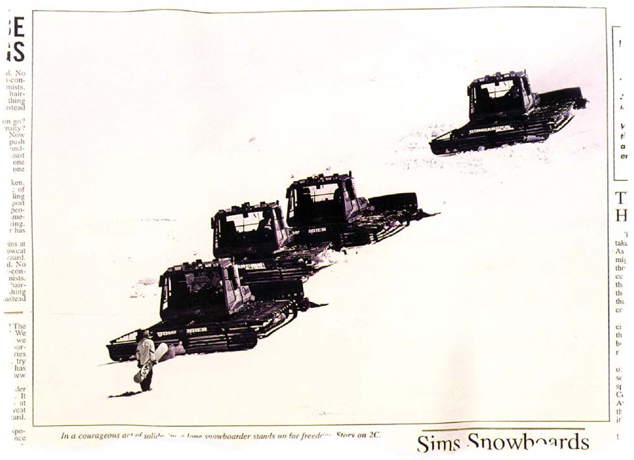
“TIANANMEN” MAGAZINE AD
Copy: In a courageous act of solidarity, a lone snowboarder stands up for freedom. – Story on 2C. Agency: Hammerquist & Saffel, Seattle Creative Director: Fred Hammerquist Art Directors: Matt Peterson, Mike Proctor Writer: Ian Cohen Client: Sims Snowboards
GLENN COLE
CO-FOUNDER/CREATIVE DIRECTOR, 72ANDSUNNY (SANTA MONICA, CALIFORNIA)

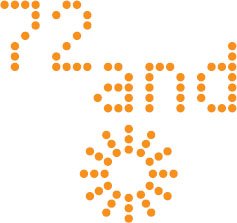
Glenn Cole began at the top. He graduated from the Honors College and the School of Journalism and Communication at the University of Oregon in the early 1990s, and promptly landed an internship at Wieden+Kennedy in Portland, Oregon, an agency where advertising is done right, with enduring craftsmanship and a flair for the iconic.
Cole got his start working on Nike, ESPN and the Oregon Tourism Board. Over a seven-year span at W+K's Amsterdam office, he served as creative director for Nike's European business unit. Along the way, he helped Nike grow from the fifth-largest global soccer brand in 1995 to number one in 2002.
Then he and art director partner John Boiler made a big jump of their own. Their agency, 72andSunny, is that independent, feisty shop that behaves like one of the big boys, doing work for international brands while keeping everything nimble and smart.
Cole is a member of The One Club board of directors and was named the inaugural Eric Allen Award recipient at the University of Oregon for alumni under forty years old who have made it big.
Process
“They say that great interviews are the result of great questions. But when it comes to my creative process, it's more like an interrogation. I question the brief, I question my own solutions, I question our presentation, I question proposed channels, I question production methods, I question schedules, I question feedback, I question how we could do it better next time, I question all of it.

I question how we could do it better next time, I question all of it.
“Frankly, it is exhausting. And more than one of my partners has complained about it. Rightfully so. But in my experience, if you assume to know what's under every stone, you stop turning them over and you reduce the chance of being surprised. Plus, being a craftsman requires an intimate understanding of how things are made, whether it's an ad, an app, an experience or a brand.
“So, rather than focus on ‘being creative,’ I focus on challenging assumptions and asking the right questions. Creative solutions usually present themselves. Which is probably why the first, and arguably most important, question on any creative brief at 72andSunny is: ‘What is the real problem we're trying to solve here?’”
— Glenn Cole
Partner
“Pablo Picasso said, ‘Every act of creation is first an act of destruction.’
“And the Hindus say that life in this world is a manifestation of the three principles of creation, sustenance and destruction. And that apparent destruction is only an essential forerunner to creation.
“And to that, Glenn Cole might say: ‘Really? You sure about that?’
“That's his thing. Before there can be creation, before there can be destruction, it all seems to start with a question for Glenn. A mental poke. ‘How solid is your philosophical footing there, Picasso?’ ‘Is there any substance under your theology, Mr. Hindu?’ Glenn isn't afraid to wonder and ask out loud. Get to the root of the idea and see if it's based on some fundamental truth. Or at least on some really entertaining bullshit. That counts too.
“So, it's been my pleasure to work, question and destroy alongside Glenn for the past sixteen years. And it has been a very fulfilling and destructive time. I remember one creative director at Wieden+Kennedy, where Glenn had begun work as an intern, likening Glenn's creative process to a chainsaw. I think it was Larry Frey. He always had a way with metaphor. Anyhow, if you're from the Northwest, you know that some amazing and unlikely things can be made with chainsaws. Ten-foot-tall Douglas fir grizzly bear/Sasquatch/gnome totems for one. Patchwork quilt forest landscapes you can see from space for another. Powerful tool, the chainsaw. Fierce, gnawing and relentless. Like good questions.
“But it takes more than critical scrutiny to make anything good. And Glenn brings the rest by staying tapped into culture. Staying curious. And of course, by creating the connections between things, people and ideas that other people just don't see yet.
“Maybe that's the process. Violent deconstruction of things. Followed by unlikely re-assembly. All in a cloud of woodchips and oily blue smoke.”
— John Boiler, Co-Founder/Creative Director, 72andSunny
INSIGHTS FROM THE PROCESS CANVAS
There's no BS, no trappings, no gilding the lily here. This minimalist statement is signaling what's most important in his process.
This couple of words against a wall of white space transmits intensity and conviction.
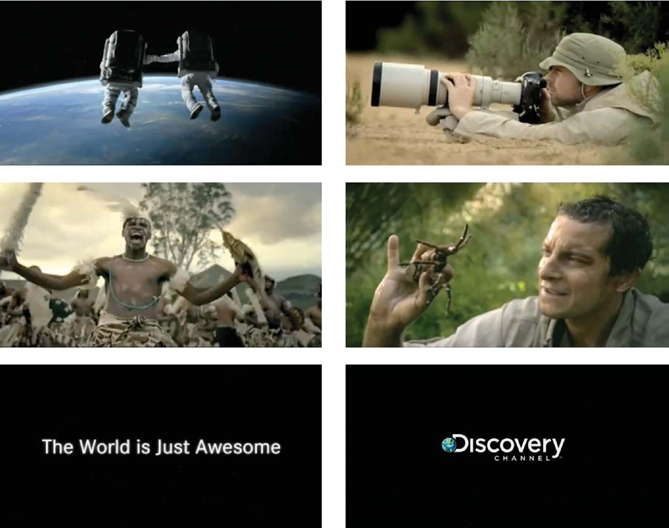
“I LOVE THE WORLD” TV SPOT
Agency: 72andSunny, Los Angeles Creative Director/Art Director: John Boiler Creative Director/Writer: Glenn Cole Client: Discovery Channel
©2009 Discovery Communications, LLC
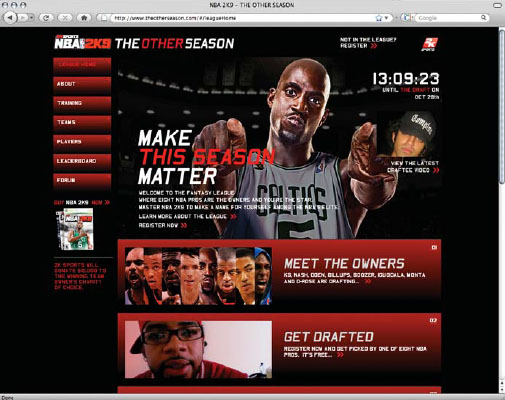
NBA 2K9 “THE OTHER SEASON” WEBSITE
Agency: 72andSunny, Los Angeles Creative Director/Art Director: John Boiler Creative Director/Writer: Glenn Cole Client: 2K Sports
SILVER CUELLAR
SENIOR ART DIRECTOR, FIREHOUSE (DALLAS, TEXAS)
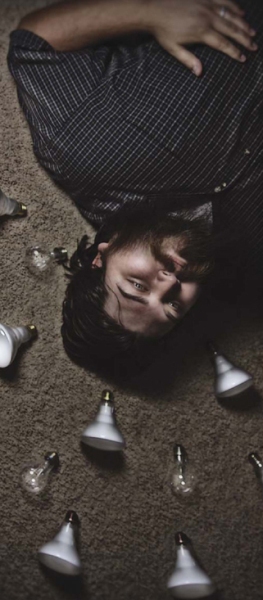
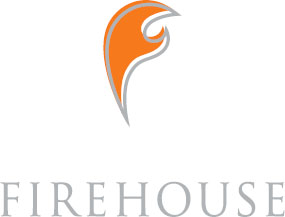
Silver Cuellar's list of creative awards and honors is almost as long as his facial hair. This self-described “native Texan and full-blooded Mexican” began his career in Austin at McGarrah Jessee in 2003, where his work helped the agency win three new business pitches and doubled its size. While there, he worked on the Whataburger, Shiner Beer, Central Market and Frost Bank accounts and became the first creative in the shop's history to win a Clio.
Boston-based Mullen hired Cuellar in 2005, where he worked on XM Satellite Radio, the Grain Foods Foundation and Four Seasons accounts, among others. Lürzer's Archive magazine featured his work and he won numerous Hatch Awards from the Ad Club of Boston. Despite his success, Cuellar missed Texas and — more specifically — the brisket.
In 2006, Cuellar moved to Dallas, where he joined the Richards Group as senior art director. One of the first campaigns he developed there, for Henk's European Deli & Black Forest Bakery, was featured in the Communication Arts 2007 Advertising Annual. His clients also included Chick-fil-A and Fruit of the Loom. In 2007, he joined TM Advertising and led teams working on the Nationwide Insurance and American Airlines business. A short film he created while at TM was selected by The One Show's One Screen Film Festival. Cuellar joined Dallas-based Firehouse in 2009.

Oh, and his prized collection of He-Man action figures? You can't play with them.
Process
“Approach each assignment like you have only one chance to show how you think. No matter the budget. No matter the key points of communication. No matter the mandatories, price offers or small legal copy. Don't compromise until you've got something that satisfies you. Sell something later.
“Do it for yourself first. It will directly reflect your ability as an ideator, your craft as an art director and your strategic thinking. It will keep all of those much-needed instruments in your head sharpened.
“Achieving this doesn't necessarily equate to one-hundred-hour workweeks. Staying until eleven P.M., going through hundreds of ideas, turning things around every time on seemingly impossible deadlines. That isn't hard to do. That can be done. But in the end, your work, your product, your output, will ultimately reflect that. That's foolish. People and agencies who demand that from you are more the fools for demanding it, let alone expecting it. Be smart enough not to compromise your balance between life and office.
“Know that each time an AE [account executive] rounds the corner of your cube, you have the chance to add to your portfolio. By doing that, you can stand by every piece in your book and know it's a piece that not only can get you hired, but can also show off your brain. Careers can live and die on that.
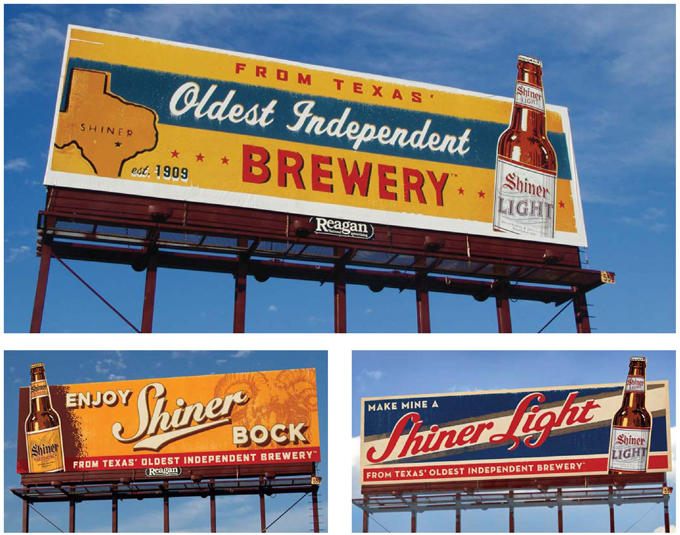
SHINER BEER BILLBOARDS
Agency: McGarrah Jessee, Austin, Texas Art Directors/Writers: Silver Cuellar, Craig Crutchfield, Derrit DeRouen Client: Shiner Beers
“I heard the other day that there is too much filler in student books. There shouldn't be any filler in any portfolio, professional or student. If you create work knowing the end result may be your only shot at showing how you think, you won't need stronger work to save your weaker work. It will all be strong.
“Your process will make this happen. It will force it to happen. This standard makes your work, your book, and the process rewarding each time. It is the absolute reflection of your mind on a page.
“That's your greatest commodity. That's your brand.”
— Silver Cuellar
Partner
“I think Silver is just fearless. He's one of those guys who is smart enough to stay on strategy but also wise enough to know that if you stay totally on strategy your ad will suck. Plus it's nice to work with people who will show a creative director or client work they truly believe is the best, regardless of the brief or budget.
“He also has mad illustrating skills. I know that's not totally key to the process, but most art directors only know how to draw a circle, maybe a square or some stick figures. When you can draw like Silver, it makes the process faster, your comps look better, and your work will communicate better and have a better chance of selling through.
“Silver also keeps the ideas going. If you've ever concepted with someone, you know there is a point where the talking stops and you just sit silently and stare at each other for a few minutes. Maybe ten minutes. You start staring off into space and it's hard to pull yourself back into a good thinking session. But some people know how to get it going again. Silver is one of them.
“Oh, one more thing — a huge thing: Silver is forever a student of the game. Ask him about any ad Carmichael Lynch did for Porsche in the last ten years. He'll know.”
— Brooks Jackson, Writer, Goodby, Silverstein & Partners, San Francisco
INSIGHTS FROM THE PROCESS CANVAS
It makes sense that we strongly, personally identify with everything we create. It's part of who we are. That's why criticism is sometimes hard to take.
The best art directors revel in detail. They notice everything and can see flaws invisible to most. They find (and can show us) beauty in unexpected places.

“FROM HOLLAND/FROM HELL” MAGAZINE AD
Headline: Family recipes from Holland. Accordion solos from Hell. Tagline: A little bit of Amsterdam in Dallas. Agency: The Richards Group, Dallas Art Director: Silver Cuellar Writer: Brian Dunaway Client: Henk's European Deli & Black Forest Bakery
Henk's European Deli, Inc. ©2009
HAL CURTIS
CREATIVE DIRECTOR, WIEDEN+KENNEDY (PORTLAND, OREGON)
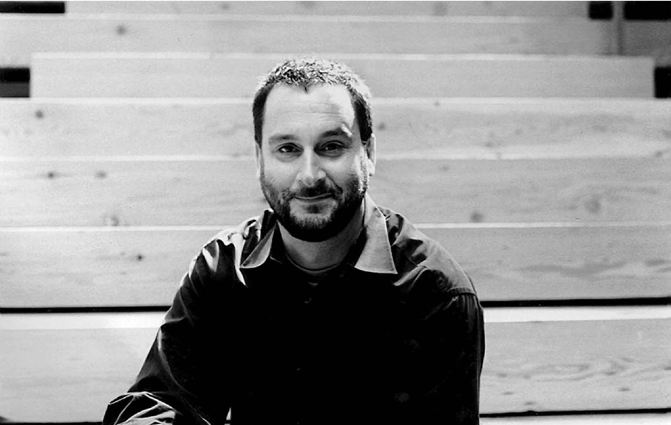
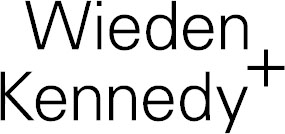
Hal Curtis is an award-winning creative director for some of the biggest brands in the world. (Maybe you've heard of Coca-Cola and Nike?) He's won awards from D&AD, the Art Directors Club, The One Show and Cannes Lions. The Museum of Modern Art, Communication Arts and Graphis have featured his work. He's also a two-time Emmy winner. But in 2008, he did something no one has ever done before: He made Charlie Brown a winner.
Curtis's Super Bowl spot for Coca-Cola, titled “It's Mine,” is set at Macy's Thanksgiving Day Parade and features giant balloons in the likenesses of Underdog, Stewie Griffin from Family Guy and everyone's favorite loser, Charlie Brown. The three characters break free from their handlers and chase a giant Coca-Cola balloon across the New York City skyline. In a surprise twist, the hapless Charlie Brown outsmarts the competition and captures the prize. The spot was a favorite of critics and viewers alike and is considered one of the best commercials in Super Bowl history.
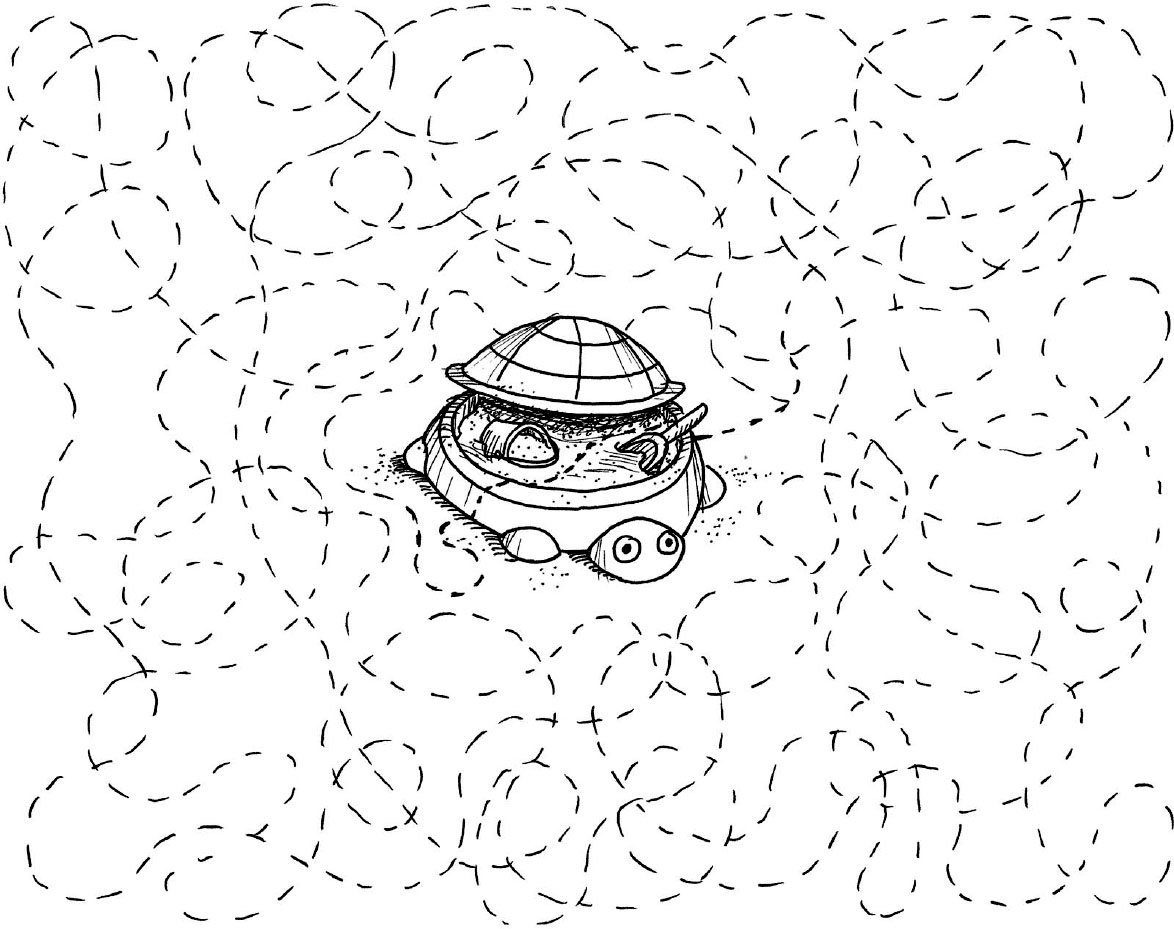
In every assignment, there is a small space where you, the agency, the client and the consumer can be happy.
A native Texan, Curtis started at Wieden+Kennedy in 1994. In 2006, Advertising Age named him one of the fifty most influential creative leaders of the last twenty years.
Process
“In every assignment, there is a small space where you, the agency, the client and the consumer can be happy. I call it a sandbox. Find it — it takes good judgment, patience and intuition. And once you do, create excellence within it.”
— Hal Curtis
Partner
“Hal Curtis is quiet.
“Working with Hal Curtis is quiet.
“Hal is quiet, quiet, quiet, quiet, quiet, quiet, quiet, quiet, quiet, quiet, quiet, quiet, quiet, quiet, quiet, quiet, quiet, quiet, quiet, quiet, quiet, quiet, quiet, quiet, quiet, quiet, quiet, quiet, quiet, quiet, quiet, quiet, quiet, quiet, quiet, quiet, quiet, quiet, quiet, quiet, quiet, quiet, quiet, quiet, quiet, quiet, quiet, quiet, quiet, quiet and quiet until he says, ‘What if we did this?’
“Then we do his ‘this.’
“And it works.
“Then Hal goes back to being quiet until the next time he says, ‘What if we did this?’”
— Jim Riswold, Artist and former Creative Director, Wieden+Kennedy
INSIGHTS FROM THE PROCESS CANVAS
Insight: The sandbox communicates play. And they are always more fun with playmates.
Insight: Ideas are a little like sandcastles. They can be beautiful, but they're fragile. It isn't wise to get too attached.
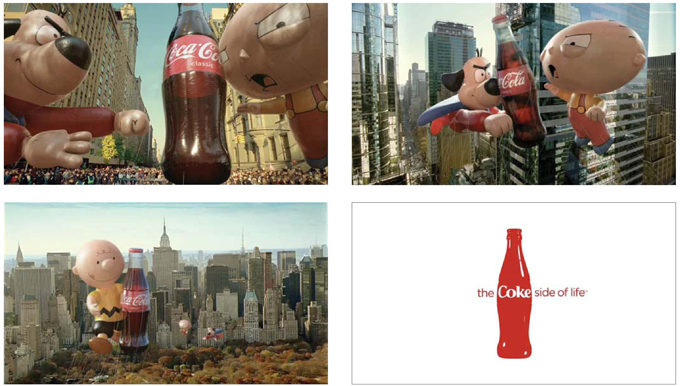
“IT'S MINE” TV SPOT
Agency: Wieden+Kennedy, Portland, Oregon Creative Directors: Hal Curtis, Sheena Brady Art Director: Hal Curtis Writer: Sheena Brady Client: Coca-Cola
PEANUTS © United Feature Syndicate, Inc.
Family Guy™ ©2009 Twentieth Century Fox Film Corporation. All rights reserved.
The Underdog character is owned by Classic Media, Inc. and used with permission.
GREG EIDEN
FREELANCE WRITER/CREATIVE DIRECTOR (PORTLAND, OREGON)

Living the Portland, Oregon, life means that you will necessarily become expert in a few appropriate areas:outdoor adventure, good beer and the environment. Greg Eiden — author of books and award-winning advertising — is a Portlander through and through.
Eiden fled the Minneapolis Metropolitan Mosquito Control District in the 1980s to join Borders, Perrin & Norrander in Portland. After ten years of fun work for Columbia Sportswear and Portland General Electric — including One Show Pencils, features in Communication Arts and other honors — he left to co-found Sasquatch Advertising. At Sasquatch, the client roster included Leatherman tools, CamelBak and Widmer Brothers Brewing, among other lucky Northwestern brands. The spirited lyrical work he and his creative team produced is legendary in the region.
He's a freelance writer now, as well as the author (along with graphic artist Kurt D. Hollomon) of the books Northwest Basic Training: Essential Skills for Visitors, Newcomers & Native Northwesterners, and In Gear: A Bike Journal. He's taught at the School of Journalism and Communication at the University of Oregon, inspiring a young crop of writers to explore their adventurous side. Eiden continues to find the spirit of the Northwest an essential part of his writer's life.
Process
“The creative product, the conception of an idea, is very much about the creative struggle.
“An ongoing, relentless, exhausting and exhilarating process, I find it is often as much about what you do away from the computer as what you do on it. Step out to visit a museum. Walk the dog. Take a nap. Or, perhaps best of all, take in a baseball game. Those moments often give birth to the best ideas.”
— Greg Eiden
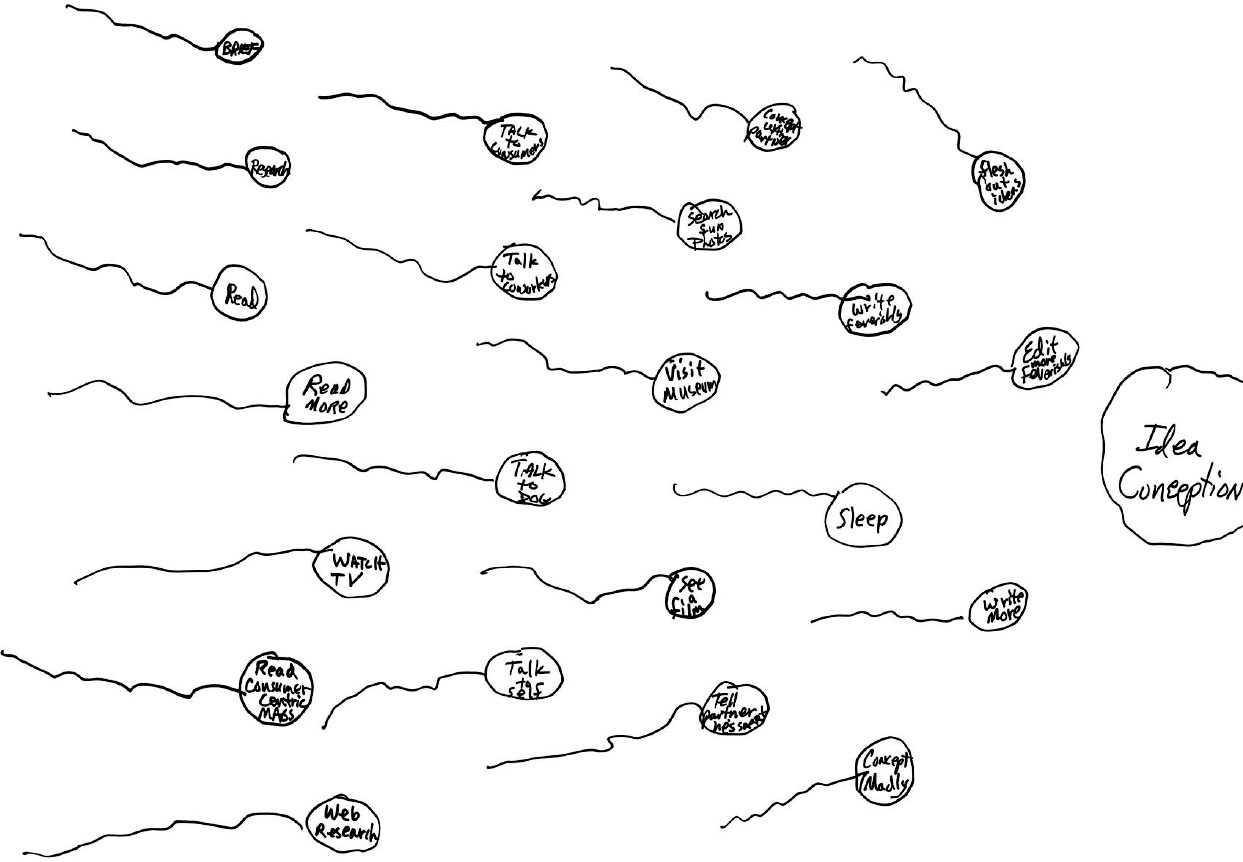
The creative product, the conception of an idea, is very much about the creative struggle.
Partner
“Greg and I have been creative partners for almost twenty years. Over that span, together we've come up with thousands of concepts. Some good, some not so good.
“Greg's brain and thought process, like many others, is heavily influenced by pop culture, news of the day, current events and art, to name a few. It's rare when you don't find him in a book-store. The guy reads everything.
“Greg's typical problem-solving approach goes something like this:
Reads creative brief, sets it aside.
Meets art director at a bookstore.
Talks/concepts while thumbing through stacks of magazines totally unrelated to the assignment, all the while taking notes.
Divorces self from thinking directly about the project for a bit. (In reality, the guy never stops thinking.)
Meets art director again at bookstore (or this time maybe a bar) to share ideas.
Rolls eyes at art director's dumb ideas.
Reassures and calms panicky art director.
Goes away and writes.
Meets art director for lunch. This time armed with what were once-random thoughts, senseless drivel, seedless germs of ideas and, yes, art director's dumb ideas, neatly organized in a ten-to-fifteen-page document that now makes sense. Adjourn to bookstore.
More concepting/whittling down ideas.
“After several sessions like this, we have magic.”
— Tim Parker, Art Director, Portland, Oregon
INSIGHTS FROM THE PROCESS CANVAS
Among many sources of fertilization, which will take hold in the brain? Which will yield the new idea?
The creative process is organic and quite miraculous at its core.
Yes, sometimes sleep can be as nourishing to the brain as a trip to a museum.
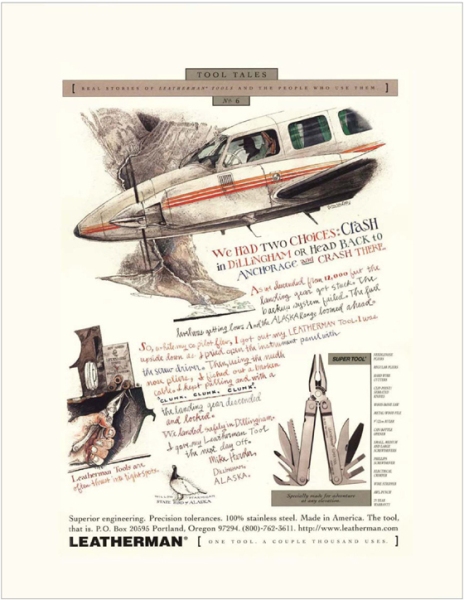
“TOOL TALES, NO. 6” MAGAZINE AD
Headline: We had two choices: crash in Dillingham or head back to Anchorage and crash there. Tagline: One tool. A couple thousand uses. Agency: Sasquatch Advertising, Portland, Oregon Creative Director/Art Director: Tim Parker Creative Director/Writer: Greg Eiden Client: Leatherman
DANNY GREGORY
MANAGING PARTNER/EXECUTIVE CREATIVE DIRECTOR, McGARRYBOWEN (NEW YORK, NEW YORK)


Danny Gregory had an international childhood. He was born in London and lived there until the age of four. His family moved to Pittsburgh and then to Australia; then, at age nine, Gregory went to live with his grandparents in Pakistan. He remembers only one television commercial from those days, but it made such an impression on him that he still recalls every word, all sung in Urdu. The spot was for Lipton Tea. Forty years later, Gregory still drinks Lipton Tea.
He's worked as an assistant at a slaughterhouse, and as an intern at the White House (he jokes that Jimmy Carter lusted for him only in his heart) and a half-dozen advertising agencies. Today, he's managing partner and executive creative director at mcgarrybowen in New York. He supervises the Chase account and has also worked on the Wall Street Journal, Crayola, Chevron and Verizon.
Gregory is also a fantastic illustrator trapped in the body of a copywriter. It shouldn't surprise anyone, therefore, that he's a believer in the power of artistic expression. He's written several books on the topic, including Everyday Matters, The Creative License and An Illustrated Life. Having led a life filled with fascinating and unusual experiences, he is a true Renaissance man.
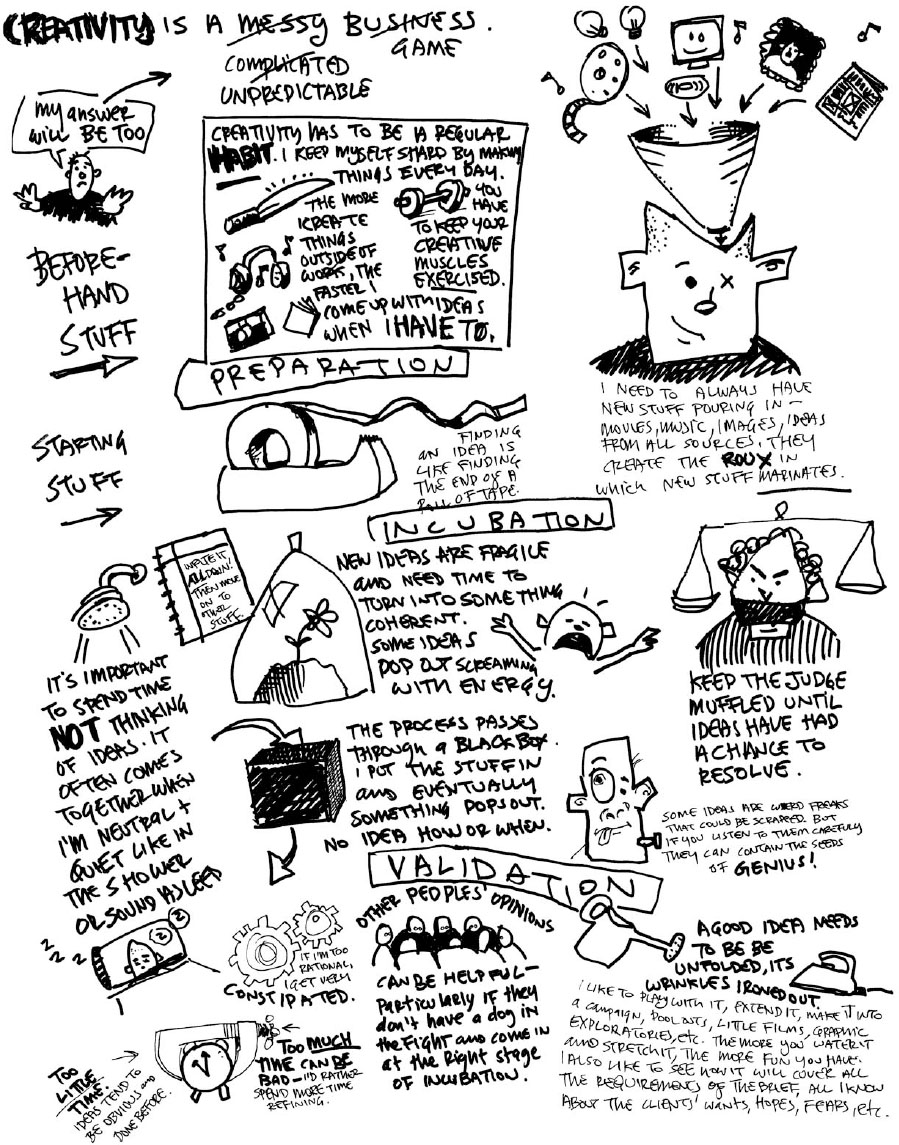
Process
“I am pretty good at coming up with ideas quickly — lots of them — some good, most bad. There are several reasons for this facility.
“First is practice: I've been a creative director for a while now. All that experience has given me confidence in my ability to come up with answers and helps stifle the Critic until I need him. My advice: Work on as many projects as possible, develop as many ideas as possible. Wait to polish until you have a rich pile of nuggets.
“Second is raw material: I have always been a voracious dabbler, and I am constantly looking for new sources of inspiration. I rarely read advertising trades or award annuals, but prefer to see what illustrators, street artists, independent filmmakers, small bands and graphic designers are up to. I visit my library every Saturday morning and return home with a half-dozen books (fiction and nonfiction, bios, how-to, history, art, experimental, pulp, etc.) and a dozen DVDs. I go to concerts, museums, galleries, dance performances, clubs, Broadway, opera, experimental theater, puppet shows and street performances. I listen to a lot of podcasts, from NPR, the TED [Technology, Entertainment, Design] conference, and various universities. All of this input can be useful as direct reference; I have it at my fingertips, fresh in my brain, ready to be pulled up and adapted, combined, and reformed into a fresh idea.
“Third is space: Not my office or studio, but mental distance and calm. I walk a lot, generally an hour or more a day, time in which I might listen to music or a podcast, but often just think, write in my head, kick ideas around. If something hits me, I scrawl it on a piece of paper or into my BlackBerry, then keep going. I also find that while I'm sleeping, my imagination is working on assignments. Sometimes I sit up at four A.M. with an idea (often only half-baked) and I tiptoe out to my desk and work on it a while, then e-mail it to myself.
“It's only when I have lots of ideas arrayed before me that I sharpen my knives and start to whittle them down to the very best.”
— Danny Gregory
Partner
DG: “How about… ?”
HM: [And he's off again with visionary gymnastics — the pommel horse champion takes to the rings, following a perfect 10.0on floor and high bar.]
DG: “What are you thinking?”
HM: “I'm thinking about breakfast; about a water bill my wife asked me to pay (three weeks ago); about my intention to leave early after arriving late. You know, ad man stuff. Shall we get a coffee?” [I hope my pleading isn't noticeable.]
DG: “Just tell me what you think first.”
HM: “Oh God, why first? Why not second? Mañana, man. Slow down.”
DG: “Ah!” [He says; I jump.] “Take a look at this…”
HM: [I grip the sides of my seat as the ride takes off. Oh no, what's this? He's written a strategy, searched out diverse video footage, spliced it together, found the right music, added his own voice-over, timed the whole thing and hand drawn the logo mnemonic. I'm wondering if he's already bought the airtime.
How is he doing it? More importantly, how is he doing it so early? He's clever of course — a Princeton man — but hell, my university has status, too. The difference is, I didn't finish, and by all accounts his thesis was dry by lunchtime. Why doesn't that surprise me? Nothing's changed. Already this morning he's thrust half a dozen ideas and I haven't parried, let alone touché-d.]
DG: “What do you think?”
HM: “What do I think? I think you're too smart, too fleet. Too cultured. Too inquisitive. Too interested in everything. Too interesting for Monday morning… for this business.
“I know the answer. He enjoys this. Throwing down the gauntlet, simultaneously raising the bar.
“My partner. Ads infinitum. Danny Gregory, ladies and gentlemen.”
— Haydn Morris, Executive Creative Director, mcgarrybowen, New York
INSIGHTS FROM THE PROCESS CANVAS
There's an appreciable certainty here about the nature of the creative process. Years of experience can bring a level of comfort and familiarity but doesn't have to spoil the fun.
Visuals and words work together to convey meaning. They can clarify and enrich each other. Great writers and art directors share this understanding.

“BLUE SKY” TV SPOT
Agency: mcgarrybowen, New York Executive Creative Director/Art Director: Haydn Morris Executive Creative Director/Writer: Danny Gregory Client: Chase Banking
©2009 JPMorgan Chase Bank, N.A. Reprinted with permission. All rights reserved.
ANDY HALL
FREELANCE WRITER/CREATIVE DIRECTOR (NEW YORK, NEW YORK)
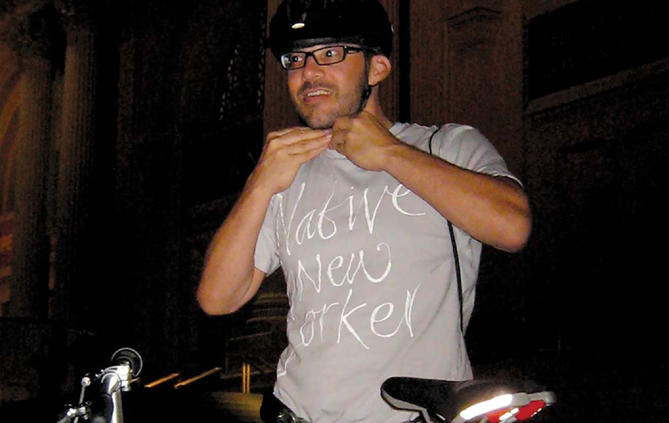
The list of clients Andy Hall handled as a New York agency veteran of more than a dozen years includes both the fashionable (Ray-Ban, Godiva, Calvin Klein, Bombay Sapphire, Cunard Cruise Line) and the functional (Domino's Pizza, IKEA and AT&T). Hall began his career as a writer at Young & Rubicam, where his big break came in the form of a national television spot for AT&T based on his sister's propensity for skidding off icy roads with small children in the car. He moved on to Deutsch, where his campaign for Domino's Pizza, featuring a fuzzy, mischievous creature and the tagline “Bad Andy. Good Pizza,” won the account. Adweek recognized his work for IKEA as a “Best Spot” in 1998.
Hall left Deutsch to join TBWA\Chiat\Day's New York office in 2000, where he helped win the Cunard Cruise Line and A&E network business. A 2002 graduate of the Absolut Akademi in Åhus, Sweden, he wrote the launch campaigns for Absolut Vanilia and Level Vodka, as well as the first long copy campaign for the brand, which was later featured in Lürzer's Archive.
In 2005, Hall was named associate creative director at Sugar-town Creative, a new boutique agency launched by ad veteran Fritz Westenberger. There, he worked on Bombay Sapphire and helped win the Godiva, Penthouse magazine and David Barton Gym accounts. For Procter & Gamble, he named a new product, Swash, and helped bring it to a laundry-adverse college market. Since 2008, Hall has been freelancing at Kirshenbaum Bond + Partners working on HomeGoods, Cablevision and Wendy's. He is an avid traveler and tennis geek, and is working on his first novel.
Process
“I went to an Eames exhibit once and there was this cabinet of tiny drawers filled with all these different buttons that they kept around for inspiration, size and shape reference, whatever. It struck me that if I kept a cabinet like that, I'd never know where to look. It's the same with memories — they're all in there somewhere, the experiences and people and little stories. But where? Which drawer? I drew the fish analogy because it seems like when I manage to find the quiet space in my thoughts, inspiration will surface and find me. A lot of it isn't very useful, feelings and images that don't really translate into scripts and headlines. But as raw material, they can lead to ideas that have the right spirit for the project at hand.”
— Andy Hall
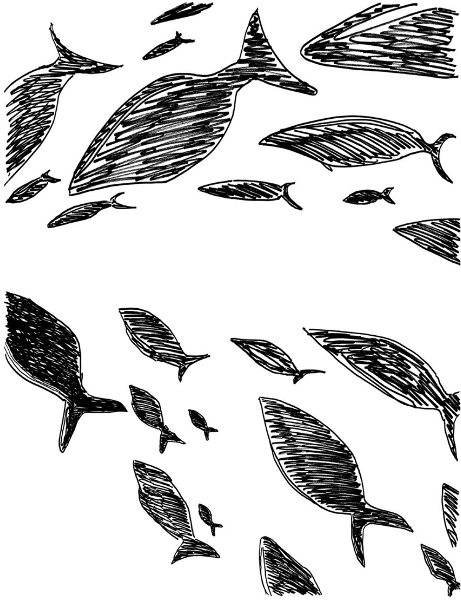

SELF-PROMOTIONAL T-SHIRT DESIGN
Agency: Sugartown Creative, New York Creative Director: Fritz Westenberger Writer: Andy Hall Designer: Joel Luna Client: Sugartown Creative
Partner
“Andy pretends there's some sort of magic to his creative process, that once he gets an assignment, bits of information floating about the air on his coffee runs and bicycle rides home just start presenting themselves, and he throws it all in his top hat and pulls out a rabbit. Ha! I have proof that it's all a calculated physiological process.
“Once we found him in the exit stair vestibule standing on his head. He said he just got this wild hair to try to break the Guinness World Record, but upon Googling we saw that a man in India did it for fourteen days, and there was no way Andy was going to miss the Williams sisters playing in the U.S. Open semis, much less the free muffins the photo rep was bringing later that day. So I knew he was trying to rush more type B to his cranium to corral all those ‘fishy’ ideas into one big bloodstream of consciousness. After three hours, he passed out, which wasn't pretty. When we revived him, his first words were ‘anvil catapult’ and he staggered to his sketchbook (yes he's a writer, but a writer who tries to draw is much less silly than an AD who tries to write). Anyway, he proceeded to draw up the brilliant idea that won us the Acme Gadgets pitch. Client marketing head Wile E. Coyote actually stood up and clapped in the meeting. From that point on, whenever I needed some of Andy's creative juice, I gladly took him to the vestibule and held his feet up for three hours.”
— Fritz Westenberger, Owner/Creative Director, Hazelwood, New York
INSIGHTS FROM THE PROCESS CANVAS
Every creative project has a start and a finish, but the journey between the two is the focus here. There is movement and convergence toward some destination.
The visual metaphor, the fish, communicates the life and energy that flourishes in relative silence, like an active brain in a quiet room.
JIM HAVEN
CO-FOUNDER/CREATIVE DIRECTOR, CREATURE (SEATTLE, WASHINGTON)


With fifteen years of copywriting experience in the creative enclaves of Portland, San Francisco, Seattle and Amsterdam, Jim Haven co-founded Creature in 2002 and serves as co-creative director of the agency. His role is to keep the Creature perspective on the work, and also to energize and enable the agency to think in new ways.
Working for the ad agencies Borders, Perrin & Norrander, Goodby, Silverstein & Partners and StrawberryFrog exposed Haven to virtually every brand category imaginable and contributed to an extensive client list. Over the years, he has lent his expertise and creativity to Pacifico Beer, Umpqua Bank, Palm, Google, Nike, Starbucks, Capgemini, HBO, the Wall Street Journal, E*Trade, Porsche, Isuzu, Sprint and more. His leadership in developing innovative campaigns has also garnered industry recognition in publications such as Adweek, Advertising Age, Communication Arts, One. A Magazine, Shoot, Shots and the New York Times have sought his input. Haven has been invited to speak at events around the world, including The One Club Workshop in Shanghai. He is also a member of Creative Social, an invitation-only group of international progressive and digital-focused creative leaders.
Not bad for a guy who, according to a 2005 interview with Adweek, is afraid of mayonnaise.
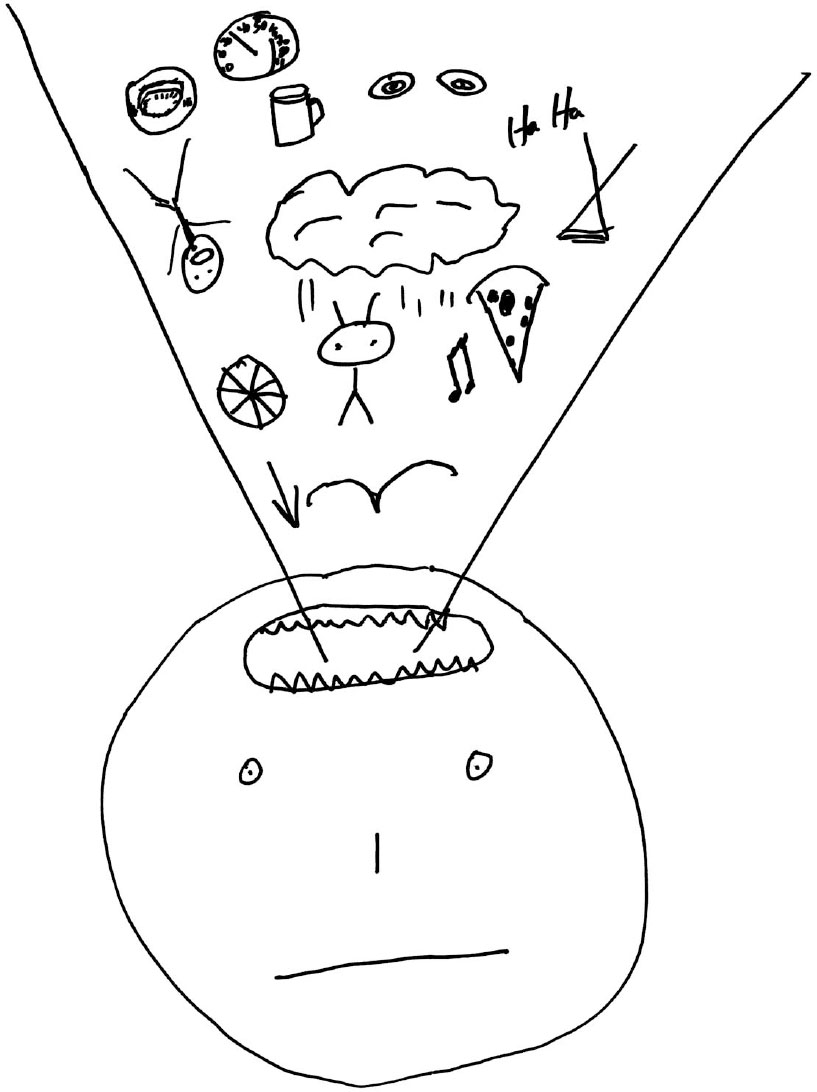
Process
“Creativity is rarely a linear process. If I knew how to channel my creativity on demand, life would be much easier and advertising would be a nine-to-five job and weekends would be just like you see in commercials. But, I do have a few personal theories. I feel that creativity usually happens on the side of your thoughts rather than the front or the back. It's a non-linear byproduct of thinking about something logically. You can't logic creativity. You really can't even make creativity. You can only hope to replicate the process in which creativity might develop, like a petri dish for your thoughts. To me, it's like flexing a muscle and relaxing. The relaxing is where the magic happens. Basically, I think or write furiously around a subject, not directly to it. Sometimes that subject is barely related to the problem I want to solve. And because I can't draw, the writing is often just a manifestation of visual thoughts. Then, in the middle of everything, I stop, get up to get a glass of water or something, and that's when my idea hits me. Over time, you get better at this process. And you don't physically have to move, you just need to switch your mind over to something else. Unfortunately, these switches usually come in the form of interruptions, which aren't quite the same.

“CLAÜS” TV SPOT
Agency: Creature, Seattle Creative Directors: Jim Haven, Matt Peterson Art Director: Adam Deer Writers: Peter Trueblood, Yutaka Tsujino Client: Palm, Inc.
“Early on, I was stymied by fear, yet at the same time it fueled me. Now, I think efficiency is my greatest motivation. Both create a sense of urgency. And I think that's the secret ingredient. Finally, you need to be okay with putting lots of bad ideas out there in order to select a good idea from the rubble.”
— Jim Haven
Partner
“My first encounter with Jim's unique view on the world was way back in college, when he left a message for my roommate on our answering machine. It was the lyrics to R.E.M.'s ‘Losing My Religion’ but the lyrics were changed to ‘Losing My Burrito.’ That song, to me, is forever now about pinto beans, too much filler rice and a missing burrito.
“Jim has always been about turning things on their head, always experimenting with improbable ‘what ifs.’ ‘What if a hermit crab wanted a more modern home?’ or, ‘What if you could wake up to a live rooster crow from Mexico, on your computer?’ When he gets excited about a new idea, he runs around the office sharing bits of it, gauging initial laughs and looking for people to add to the idea that has just been hatched. There are lots of these moments of spark. Jim doesn't have the longest attention span in the world, but it means the volume of new thoughts is always high.
“Jim has an unending drive to create the next great idea. He loves to make people laugh and join him on his often-bizarre scenarios, many of which lead to great advertising stories. Working with Jim is about constantly creating. He says he's in advertising because he couldn't actually do anything else. He's probably right, but his mind and gift for creating memorable stories that solve business problems couldn't be better suited for what we do here.”
— Matt Peterson, Co-Founder/Creative Director, Creature
INSIGHTS FROM THE PROCESS CANVAS
The expressionless face here offers a reminder that the brain is always working, regardless of how we look on the outside.
Out of apparent chaos, the mind can synthesize, organize and bring order in the form of a creative solution to a problem.

“MEXICO VIA PACIFICO” MAGAZINE AD
Agency: Creature, Seattle Creative Directors: Jim Haven, Matt Peterson Art Director: Lara Papadakis Writer: Peter Trueblood Client: Pacifico Beer, Crown Imports, LLC

“MEXICO VIA PACIFICO” BILLBOARD
Agency: Creature, Seattle Creative Directors: Jim Haven, Matt Peterson Art Director: Lara Papadakis Writer: Peter Trueblood Client: Pacifico Beer, Crown Imports, LLC
MIKE HEID
WRITER, PETER A. MAYER ADVERTISING (NEW ORLEANS, LOUISIANA)


As a graduate student, Mike Heid won a national Gold ADDY Award for a point-of-purchase display idea. He and a partner designed and built a giant, exact replica of an old-fashioned mousetrap for installation in grocery stores. The mousetrap was “baited” with boxes of cheese-flavored crackers and carried the tagline “Get Nipped.” Here's a guy whose best work is never understated.
Instead, Mike Heid is a funny (some would say “crazy”), smart man who knows how to get your attention. For the past several years, he's been a writer at Peter A. Mayer Advertising in New Orleans, working on Luzianne Iced Tea, the National World War II Museum, The Roosevelt New Orleans hotel and the New Orleans Saints, among others.
Heid's work has earned him an Effie Award and several ADDY Awards at the local, regional and national levels. His friends from back home in Erie, Pennsylvania, would have to agree that he's done quite well for himself in the Deep South. (But he'll always cheer for Penn State.)
Process
“As you can see from my drawing, much of my creative process comes down to fear (a.k.a. doubt, a.k.a. insecurity). The fear hits when I'm done procrastinating, the reality of an impending deadline is setting in and I'm staring at a blank page. But fear isn't such a bad thing. You can use it to make your work even better. If you know how to deal with your fear, you can use it to push yourself to find a better idea.

Eventually a good idea will come if I keep working at it. Sometimes that work takes a couple of hours. Sometimes it's a couple of days. Sometimes it's a couple of weeks. But in the end, the result is the same — a good idea.
“Moving past fear requires trusting your own personal process. I know that, no matter what I put down on paper — no matter how crappy that first idea may be. Eventually a good idea will come if I keep working at it. Sometimes that work takes a couple of hours. Sometimes it's a couple of days. Sometimes it's a couple of weeks. But in the end, the result is the same — a good idea. I'm not saying that I find genius every time (or ever), but 95 percent of the time, my partner and I will come up with an idea I feel good about.
“The only way you can let fear win is by not trusting your process; not believing in yourself and your ability to come up with a good idea. Believing that the fear is right — that you've already had your last good idea — that's when you've lost.”
— Mike Heid
Partner
“I guess all creatives can relate to the vicious cycle in Mike's drawing. But if you're going to be caught in that cycle, you may as well roll with it.
“Though I may know him well enough to know his fear exists, Mike does a pretty good job at disguising it. His number one veil would have to be humor, including anything that involves singing, voices or dance moves of an awkward or ridiculous nature. But more importantly, his positive attitude and passion for advertising are always evident from the start of the process. He is always thinking about what different media we could consider or what more creative approach could be taken. He seems to spend a good amount of time researching and familiarizing himself with relevant information. My guess is that this is one part procrastination, one part due diligence and one part just looking for that interesting nugget to get the conversation going.
“We take turns throwing out all the crazy, lame, irrelevant, awesome and/or unrealistic ideas. We both run them through filters and either of us can shoot them down. Ultimately, a few survive, and the pressure is off when we have something solid. But Mike will still try to one-up his best idea and come up with one more ‘I got it,’ even in the final stages of layout.
“Throughout the process, Mike always has a calm, collected way of challenging the strategy and selling his ideas, gracefully accepting and dishing out criticism, and if all else fails, making a fool of himself in the spirit of comic relief.”
— Jill Norman, Senior Art Director, Peter A. Mayer Advertising, New Orleans
INSIGHTS FROM THE PROCESS CANVAS
All creatives experience fear. Fear is volatile because it can motivate or paralyze. You decide how to handle it, channel it and live with it.
For writers, constant rewriting and revision is part of the process. It's also a viable strategy for dealing with fear and uncertainty: from quantity comes quality.

“GRANDFATHER'S MUSIC” POSTER
Agency: Peter A. Mayer Advertising, New Orleans Creative Director: Josh Mayer Art Director: Jill Norman Writer: Mike Heid Client: Louisiana Philharmonic Orchestra

“MIDWAY” BILLBOARD
Agency: Peter A. Mayer Advertising, New Orleans Creative Director: Josh Mayer Art Director: Missy Battle Avery Writer: Mike Heid Client: The National World War II Museum
DAVID HORRIDGE
FOUNDER/CREATIVE DIRECTOR, THIRTY-ONE CREATIVE (AUSTIN, TEXAS)
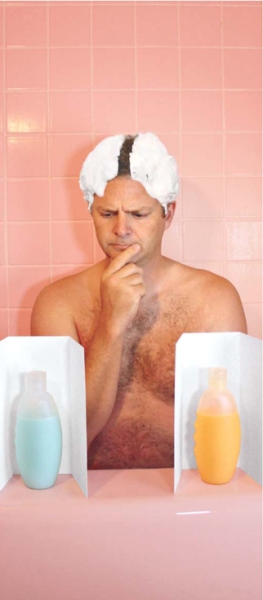

Creative Pitch Consultant. Interim Director of Marketing. Creative Director. Writer. Art Director. Designer. Naming Consultant. Keeper of the Brand and Human Experience. That's the long and eclectic list of titles held by David Horridge over the course of his career (so far). He started as an art director at McCann Erickson in New York and a couple of years later moved to T3 in Austin, Texas, the city where he put down roots and still works today.
Horridge has worked with a broad array of clients, including Dell, Coca-Cola, Mazda, Toys “R” Us, Motorola, AT&T, Nabisco, Toshiba and Black & Decker. He's won a pile of ADDY Awards and had his work recognized by The One Show and Print magazine. In 1997, he founded Thirty-One Creative, a successful freelance shop offering clients a wide range of creative development experience coupled with a deep understanding of strategy. He's also actively involved in the Austin creative community, serving as education director on the board of the local American Institute of Graphic Arts (AIGA) chapter.
And there's yet another title to David Horridge's credit: professor. He taught intermediate and advanced portfolio classes for six years at the University of Texas at Austin, his alma mater.
Process
“My creative process is an act of subtractive creativity.
“First, before I uncap my Sharpie, I make sure I'm fully informed. I wallow around in every scrap of information I can find. If it's related to the problem I'm being asked to solve, I dive into it.
“Once fully submerged, the subtraction begins.
“Over the years, I've learned that the blank page is only intimidating when I feel pressured to ‘add’ something to it. So I don't.
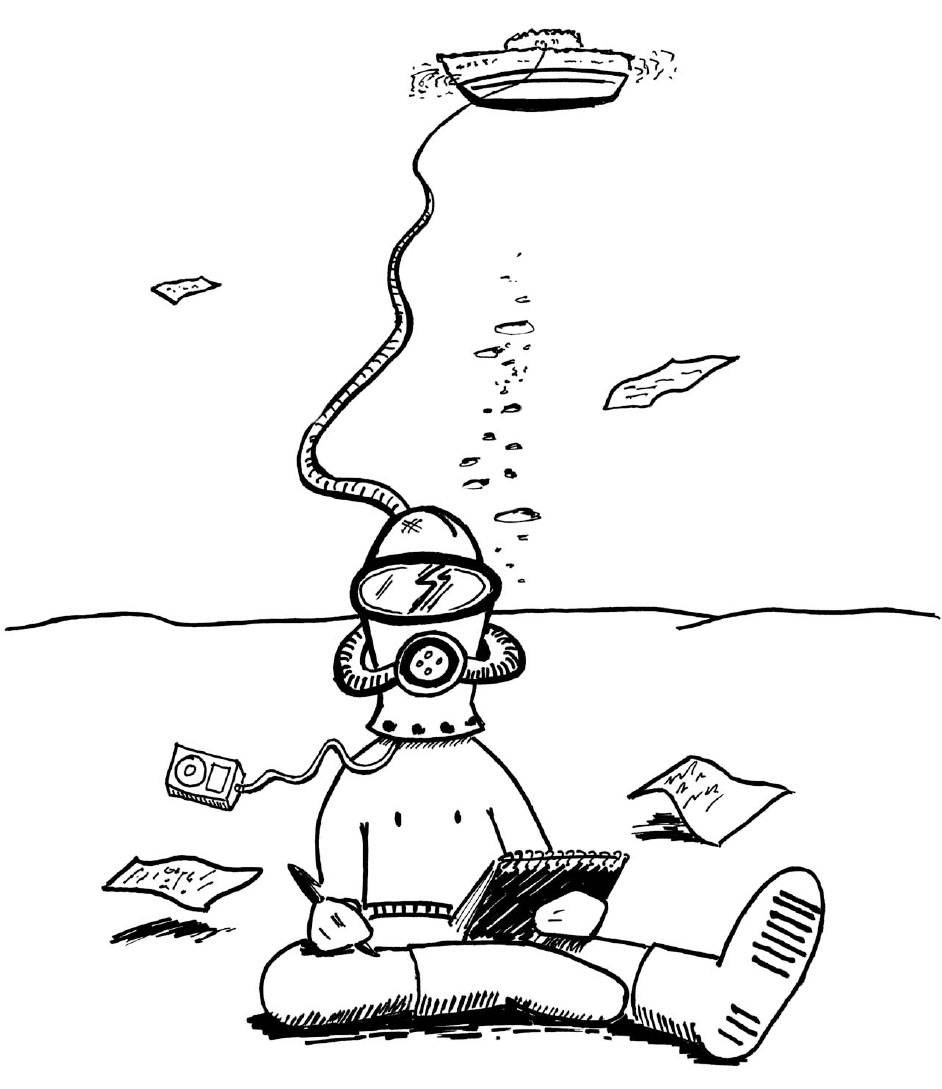
Ultimately, I'm left with polished ideas. But it's the calluses that make me most proud.
I don't view the blank page as an empty canvas nor feel the artist's tug to fill it. To me, the blank page is merely a shovel and my ideas are buried deep inside my mind, usually trapped under tons of rubble.
“Much like an archaeologist who expects nothing of the first several thousand shovelfuls of dirt, I expect nothing of my ideas as I excavate my head. I dig and create piles of dirt. Nothing else.
“I also try not to critique my ideas as I unearth them. That would slow me down. I'm better when I come back and sift through everything after I get a little distance.
“When I return to my piles, I return alone. My discovery process is more of a listening one than a thinking one. I pore over everything I've dredged up. One by one, I sense the potential of each nugget, each pot shard of an idea. Does it have promise? Is it garbage? Where did I find it? Are there more? I isolate myself and I listen.
“The answers come and serve as compass points. They mark where the rich veins lie. Where I'll dig further. And so my process continues. Dig, sift, listen, repeat.
“Ultimately, I'm left with polished ideas. But it's the calluses that make me most proud.”
— David Horridge
Partner
“Dave's creative process begins on the ‘human’ level. Although he always gains a comprehensive understanding of the product or service being offered, he quickly shifts his focus to the person he is trying to reach and attempts to relate to them on a deeper level. Who are they? What do they like to do? What makes them laugh, or cry? These questions are not answered through methodical demographic analysis, but rather through the sharing and exploration of Dave's own life experiences. Dave is very good at creating fun, organic ideation sessions that more closely resemble two friends chatting over coffee than ad creatives hard at work. His stories, humor and ideas, which might seem somewhat tangential to the exercise, frequently lead to identifying the key connections between what we are selling and the person who needs or wants it.
“For many, that might be the end of the creative exercise; find a compelling connection, write some headlines and move on. Not for Dave. The next step in his creative process is to deeply examine as many different ways to reflect those connections in the final work. He explores potential executions from every angle until one emerges that is undeniably ‘right.’ It's not surprising that these ideas consistently resonate with clients, consumers and award show judges alike.
“I feel lucky to have worked with someone whose creative process was as unique as it was effective. I learned a lot from Dave.”
— Jonathan Balser, Chief Executive Officer, Mooch, LLC, Atlanta
INSIGHTS FROM THE PROCESS CANVAS
Working as a freelancer affords a different perspective, a different lifestyle compared to a full-time agency role. Freelancers can set up shop wherever feels right.
For many, solitary work is essential for focus and exploration. Some prefer absolute silence while others drown out distractions with their iPod.
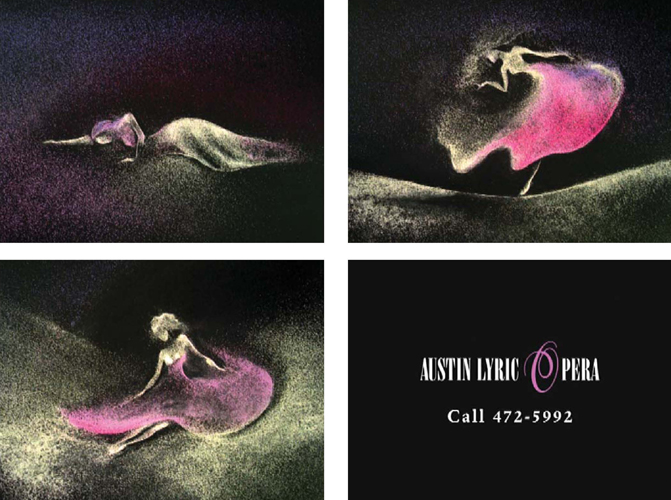
“DANCER” TV SPOT
Agency: T3, Austin, Texas Creative Director: Mike Bevil Art Director: David Horridge Writer: Jonathan Balser Client: Austin Lyric Opera
RACHEL HOWALD
SENIOR VICE PRESIDENT/GROUP CREATIVE DIRECTOR, McCANN ERICKSON (NEW YORK, NEW YORK)
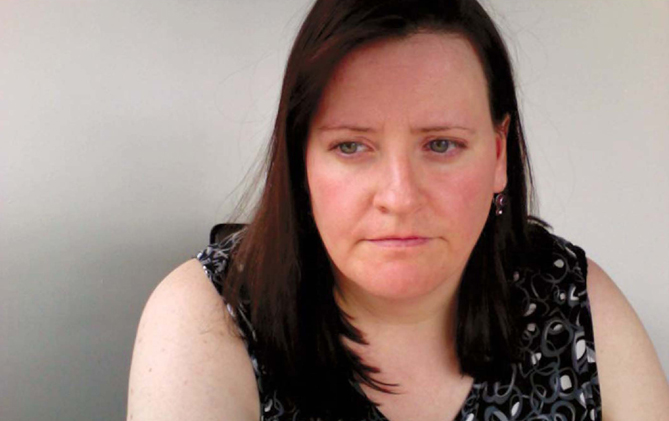

The string of awards and accolades started early in her career: Rachel Howald was named to Crain's Forty Under Forty at twenty-five, the youngest person ever to nab that honor. Since then, she's won just about every creative award in the profession, including having two of her commercials named as part of the Museum of Modern Art's permanent collection. She's also a lapsed member of Mensa, was nominated for an Emmy in 2002, was profiled in O, The Oprah Magazine, and has even worked with the likes of David Crosby, who crafted some sweet music for an AT&T campaign she worked on. But, quite possibly, the accolade that rings highest on her hit parade is the one she's heard from agency colleagues and client presidents to the custodial staff in her office: Rachel Howald is so real. Funny, strategic, and a helluva writer and creative director, Howald consistently shows how good advertising can be entertaining and memorable while it makes clients like Computer Associates, Nokia, Genworth Financial, AT&T and General Mills take notice. And all the while, she remains a happy camper and fun to be around. Howald and her partner, Jennifer, are the proud moms to two sons, Cal and Will, which qualifies her for a turn in the carpool and soccer mom status in her spare time.
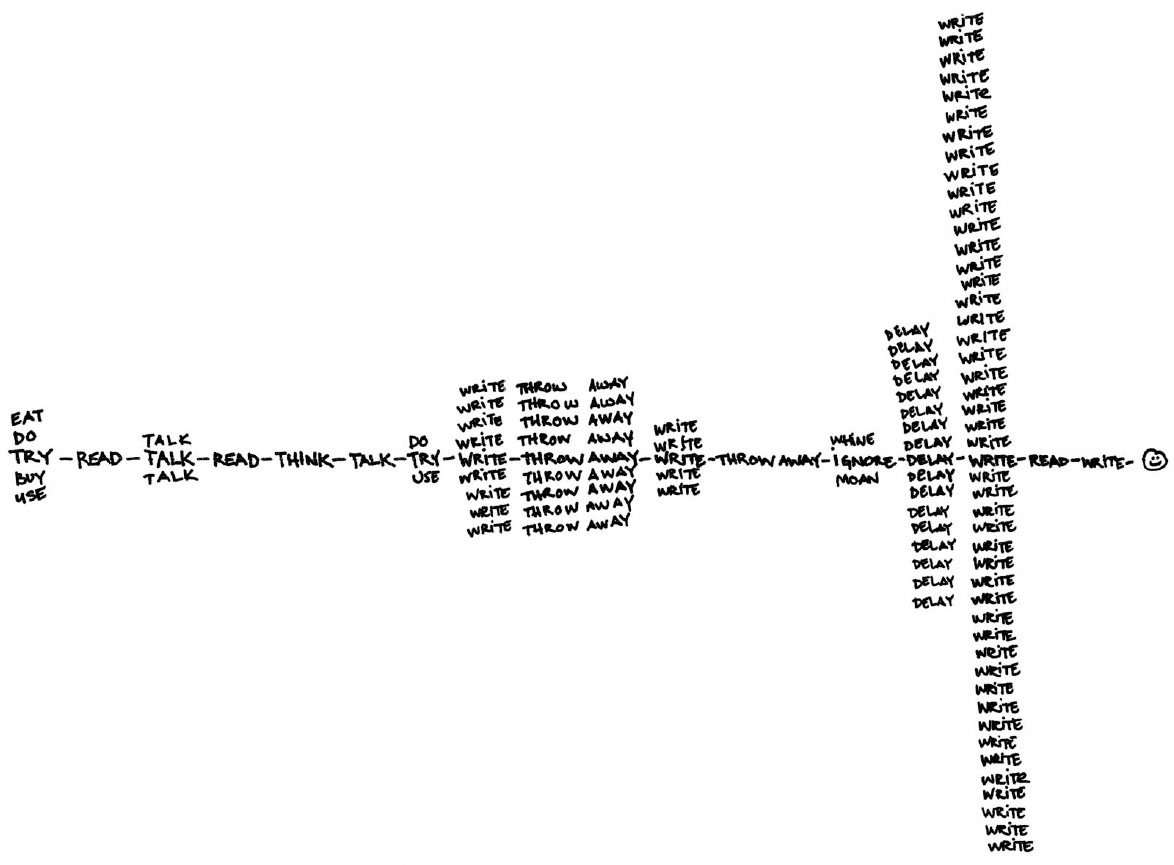
Well, inspiration comes from external stimuli which, when varied and rich, engages certain areas of the brain to fire synapses that correlate to electrical impulses and… I have no idea.
Process
“You know when someone asks you to explain something that you have no idea how it works but you know a little bit of terminology so you dance your way around the answer with vagaries until they eventually get tired of asking and go away? Well, inspiration comes from external stimuli which, when varied and rich, engages certain areas of the brain to fire synapses that correlate to electrical impulses and… I have no idea. I try to go to interesting places, read interesting things and talk to interesting people. Then somebody hands me a piece of paper and a deadline and I procrastinate until I eventually light candles and listen to the soundtrack to Titanic over and over again while I type without thinking. Et voilà… advertising!”
— Rachel Howald
Partner
“After twelve years of working together, here's what I can tell you about Rachel when she's working. She listens to music. Lots of it. Usually loudly. Sometimes it's Cher. Sometimes it's Klezmer. Sometimes it's jazz. And always lots of show tunes and Streisand. Oy vey, the Streisand.
“She takes notes constantly and sticks things up on the wall. She gets a giant stack of empty 4″ × 6″ note cards and a Sharpie and a roll of tape and goes to town, writing and sticking things up.
“When she's frustrated and we have a tight deadline, she suddenly becomes obsessed with moving around all the furniture in her office. She will spend two hours literally rearranging everything at midnight when we're supposed to be doing the final push before a big presentation. She'll move the couch, she'll clean out her desk, she'll make new playlists in her iTunes so she has a mix to move the couch to.
“On the average workday, she has a line of Starbucks cups and seltzer bottles on her desk that she works her way through as the day goes by. This leads to her other source of creative inspiration — frequent walks back and forth to the bathroom.
“Somehow it works for us. When we started our own company, she gave me a card with a Camus quote that said, ‘Don't walk in front of me; I may not follow. Don't walk behind me; I may not lead. Just walk beside me and be my friend.’ That's why we work together well. Neither one of us leads or follows. We just keep walking.”
— Ahmer Kalam, Senior Vice President/ Group Creative Director, McCann Erickson
INSIGHTS FROM THE PROCESS CANVAS
A writer uses preparation as an important tool; many things have to happen before she's actually ready to write.
It is notable that terrific energy is involved in some of the despondency. It's dark before the dawn of a new idea.
The smile at the end, the simple understanding that the entirety of the process is worthwhile, is a confident statement and the mark of a seasoned professional.
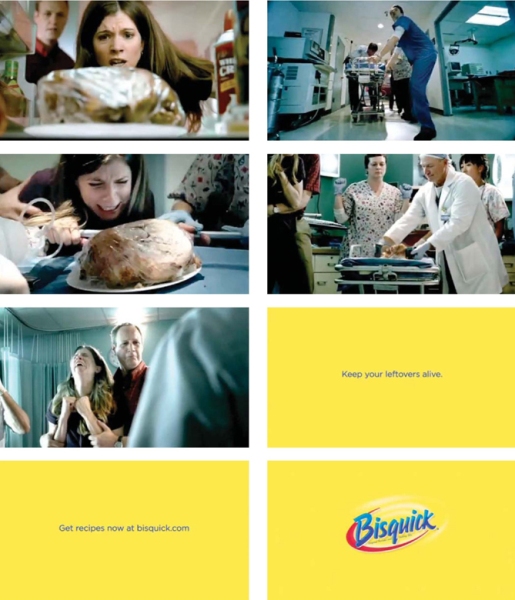
“KEEP YOUR LEFTOVERS ALIVE” TV SPOT
Agency: McCann Erickson, New York Chief Creative Officer: Joyce King Thomas Group Creative Director/Writer: Rachel Howald Group Creative Director/Art Director: Ahmer Kalam Agency Producer: Minnie Tran Director: Rocky Morton Client: Bisquick, General Mills, Inc.
DAVID T. JONES
CHIEF CREATIVE OFFICER, THIRD STREET; CARTOONIST, ADWEEK (CHICAGO, ILLINOIS)
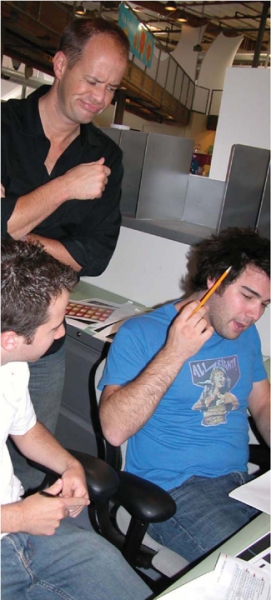
David T. Jones (standing) reacting to ideas.

A cartoonist's life is full of inspiration. A cartoonist/ conceptual artist/art director uses every piece of the day to get closer to the truth. David T. Jones — creator of Adweek's Ad Land and creative director at Third Street in Chicago — must be keeping notes in a couple of big journals just to keep up.
As creative director, then executive creative director of emerging platforms at Foote, Cone & Belding in Chicago for fifteen years, Jones took on all media and a long list of brands, including Gatorade, Kraft Foods, Coors, SC Johnson, and Boeing. With that, of course, came the awards — D&AD, ADDYs, Effies, and Art Directors Club honors — plus a Webby Award in 2007. His work even landed him in Contagious Magazine. Now at Third Street — the Attention Agency, as they refer to themselves — he and co-founder Sean Smith deliver work that, well, grabs attention.
In fact, you've seen Jones's work and admired it. But then you've also seen some of his work and copied it, sent it to your friends with a little Post-it attached with some clever comment. You've lived his work. For a handful of years, Jones's Ad Land cartoon has run each week in Adweek. As Jones notes: “Ad Land has mocked, lamented, spoofed, inspired, sold out and gone viral, making fun of just about everything in advertising, nothing more than its creator.”
By day, a guy doing advertising. By night, a guy dinging advertising. He does both well. Sean Smith likens it to an athlete in training. “His training — the cartoons, the humor — results in his unique ability to meet any creative opportunity,” Smith says. “You never know what play is coming next, and no two are alike. Yet he's prepared for anything. That's David in the creative realm.” There's probably a great cartoon idea in that statement.

The truth is that ideas don't come to me.
The cheeky little bastards always make me come to them.
Process
“The truth is that ideas don't come to me. The cheeky little bastards always make me come to them. Sometimes they're hiding under the stairs. Occasionally, they're on a short vacation to Wisconsin. Often they're hanging out at the neighbors'. But… I've found they're rarely where I look. To paraphrase John Lennon: ‘Ideas are what happen when you're busy thinking other things.’”
— David T. Jones
Partner
“The focus of our business is focus. In other words, trying to get our clients to be single-minded in their communication. As I look back at all of the people I've worked with who talk about focus, David is one of the few who practices it. Probably because David epitomizes focus. And it comes across in the form of ‘making you feel good about yourself.’ That is the single quality that I will always remember about David. No one who meets with him comes out of that meeting feeling bad about themselves or their work. He always finds something good to say about the worst situation. It's a rare and elusive quality in a creative director. He has it, and that makes him special.”
— Jonathan Harries, Vice Chairman and Global Chief Creative Officer, Draftfcb, Chicago
INSIGHTS FROM THE PROCESS CANVAS
“I don't have a process” feels like a contradiction when a creator takes the time to reflect on his habits.
Self-doubt happens to the most successful of idea people. The fear of hackdom seems to become more potent with every year of experience accumulated.
It can be tough enough to generate the idea. But it never really lives until the client buys it.
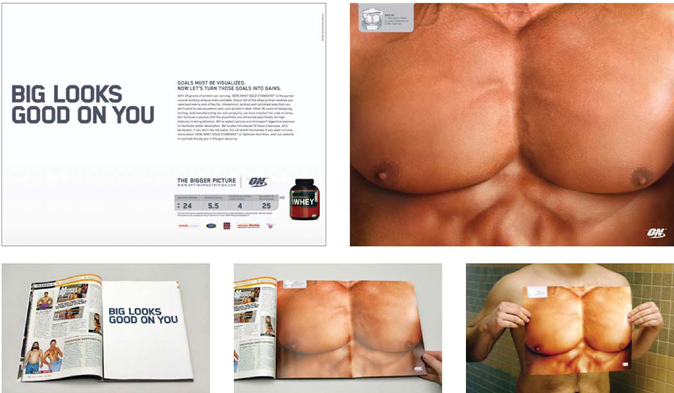
“GATEFOLD CHEST” MAGAZINE INSERT
Agency: Third Street, Chicago Group Creative Director: David T. Jones Art Director: Jim Haas Writer: David Littlejohn Client: Optimum Nutrition
DAVID KENNEDY
CO-FOUNDER/CREATIVE DIRECTOR, WIEDEN+KENNEDY (PORTLAND, OREGON)
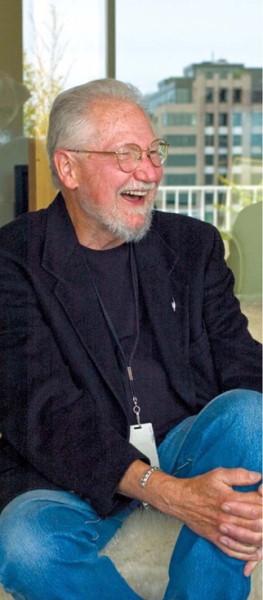
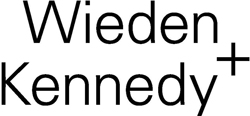
In the advertising business, Wieden+Kennedy is often referred to as W+K. But from time to time, agency co-founder David Kennedy likes to wear his own custom silk-screened, black T-shirt that reads “K+W.”
Founded in 1982, Wieden+Kennedy now has offices in Portland, New York, London, Amsterdam, Shanghai, Tokyo and New Delhi. Their client list includes Nike, Coca-Cola, Miller Brewing Company, Nokia, Starbucks, Honda, ESPN, Ivory, Old Spice and Target. But no matter how big and how successful the agency becomes, at its core is the inspiration and example of the wise, funny, irreverent and fundamentally kind David Kennedy.
David is one of the most famous and honored ad men in history. He is a hall of fame laureate at both the Art Directors Club of New York and The One Club for Art & Copy. He's won Gold, Silver and Bronze Lions at the Cannes Film Festival, and his work is in the permanent collection of the Museum of Modern Art.
For the past fifteen years, David has supervised work for W+K's primary pro bono account, the American Indian College Fund (AICF). The agency has created and placed many millions of dollars worth of public service print and television ads for the thirty-seven tribal colleges supported by AICF.


“ALL FEET” MAGAZINE AD
Agency: Wieden+Kennedy, Portland, Oregon Art Director: David Kennedy Writer: Dan Wieden Illustrator: Daniel Maffia Client: Nike
Process
“I did not have a formal education in design, graphics or advertising. I was a fine art student — metal sculpture and printmaking — very physical stuff. Design sort of bubbled to the surface for me. I began in this business as an unschooled, inexperienced apprentice/messenger boy. I was hired only because I could draw. But I learned through osmosis.
“I always was, and continue to be, influenced by my heroes. Probably the biggest design influence on me was Push Pin Studios: Milton Glaser, Seymour Chwast and Paul Davis. I will forever be in awe of their work. They changed the world of illustration at the same time Bill Bernbach was changing the world of advertising. These are the people that seduced me into this business. To paraphrase Helmut Krone, all of these men helped elevate advertising to an art, and our jobs to a profession.
“Once I had the responsibility of tending a Lakota Sundance fire (a sacred Native American ceremony) for four nights. It occurred to me that being a creative director is similar. You have to feed the team with information, background and enthusiasm. You have to fan the flames with encouragement, fear, indifference… whatever works. But you have to let them ruminate and discover their own solutions.
“A good creative partnership is much like a marriage. Wieden+ Kennedy's early success was largely due to the fact that Wieden and I were strong family men (Dan has four kids and I have five). We understand that people have to depend on and respect each other to live together successfully, whether in a home or at an office. Leo Burnett once said to me, ‘You know, David, my inventory goes down the elevator every day at five o'clock.’ I have never forgotten those words. At Wieden+Kennedy, our secret has been to hire people better than we are and to get the hell out of their way. We wanted to create a place where people could simply realize their potential.
“The one constant in my creative process is the hope, the prayer, the chance that I will feel the crack of the bat once more and watch the hide fly off the fucking ball as it heads for the right-field fence.
“However, if any of my own children had wanted to follow in my footsteps and become an advertising art director, I would have broken their thumbs.”
— David Kennedy
Partner
“David Kennedy stood there in my office doorway wearing a three-piece pin-striped suit. It was the first time I ever laid eyes on him and the last time I ever saw him in that suit. After we started working together, he must've burned it or given it to Goodwill, because for the rest of his working life, with only two or three minor exceptions, this man wore Levi's and a blue work shirt. Period.
“‘It simplifies things,’ he said.
“Simplifying the man is a bit more difficult. There are so many facets to Kennedy, arranged in no particular order, that you cannot get a complete picture of him even after twenty-five years' exposure.
“He is completely centered, yet a mass of contradictions. In that rat's nest he called an office, the space was filled with old photos, flags, buffalo skulls, woodblock letters and other artifacts.
“We were walking back from lunch one day, trying desperately to find our way out of a business crisis. I was doing my damnedest to articulate an issue, break it down. Along the way, Kennedy listened, challenged, took another line of attack and then abruptly yelled, ‘Jesus, Wieden, look!’
“There, under a tree growing out of the sidewalk, was a scrap of paper with an image I couldn't quite make out. He bent over, picked it up, brushed off the grime and flattened it out.
“‘Isn't that beautiful?’ He gave his classic half-laugh and looked at me with a raised eyebrow, bringing me back to the present moment and that piece of flotsam back to the office.
“He is addicted to beauty. He can't leave it alone. It is this obsession with craftsmanship — coupled with his startling conceptual talent — that has guided Wieden+Kennedy from the backwoods of Oregon out onto the international stage.
“I owe him everything.
“His Indian name is Wichasha Owayakepi Chunta, which is Lakota for He Who Sees the World With His Heart.
“He has contributed so much to this industry, so much to our agency. But of all the things he has given me, and they are many, the most enduring are those three simple words:
“‘Jesus, Wieden, look.’”
— Dan Wieden, Co-Founder/Creative Director, Wieden+Kennedy
INSIGHTS FROM THE PROCESS CANVAS
Even the most accomplished creative people have heroes, others whose work inspires and pushes them to be better.
The creative process is both highly serendipitous and fraught with the potential for mistakes and even failure. Understanding this and learning from it is key.

“THINK INDIAN” TV SPOT
Agency: Wieden+Kennedy, Portland, Oregon Creative Directors: Dan Wieden, David Kennedy Executive Creative Directors: Mark Fitzloff, Susan Hoffman Art Director: Patty Fogarty Writers: Justin “Scrappers” Morrison, Patty Fogarty Client: American Indian College Fund
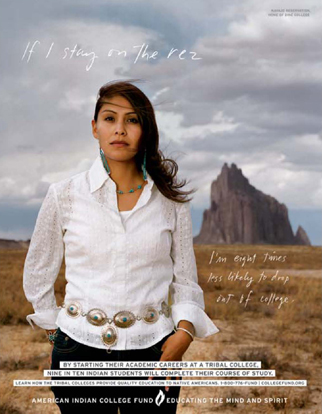
“ON THE REZ” MAGAZINE AD
Tagline: Educating the mind and spirit. Agency: Wieden+Kennedy, Portland, Oregon Executive Creative Director: Dan Wieden Creative Director: David Kennedy Art Director: Patty Fogarty Writer: Will Ulbricht Client: American Indian College Fund
JANET KESTIN/NANCY VONK
CO-CHIEF CREATIVE OFFICERS, OGILVY & MATHER (TORONTO, CANADA)

© 2009 Farokh Monajem

What happens when two women in advertising challenge everything that's wrong with advertising that targets women? Ask Janet Kestin and Nancy Vonk. In 2007, they took the beauty industry to task and promoted the power of self-esteem in the “Campaign for Real Beauty” for Dove. Newsweek, Time and the Wall Street Journal took notice, all listing their work among the top ten ads of the year. Now that's how to sell some soap.
Kestin and Vonk, two of the most powerful and accomplished women in advertising, started working together in 1991. Since then, they've won Cannes Grand Prix awards, One Show Pencils, Clios — just about every honor in the industry. Creativity magazine ranked them among the Top 50 Creative People in 2008, and in 2007 they were named advertising's women of the year by both the Women's Image Network (WIN) in Los Angeles and the Advertising Women of New York (AWNY).
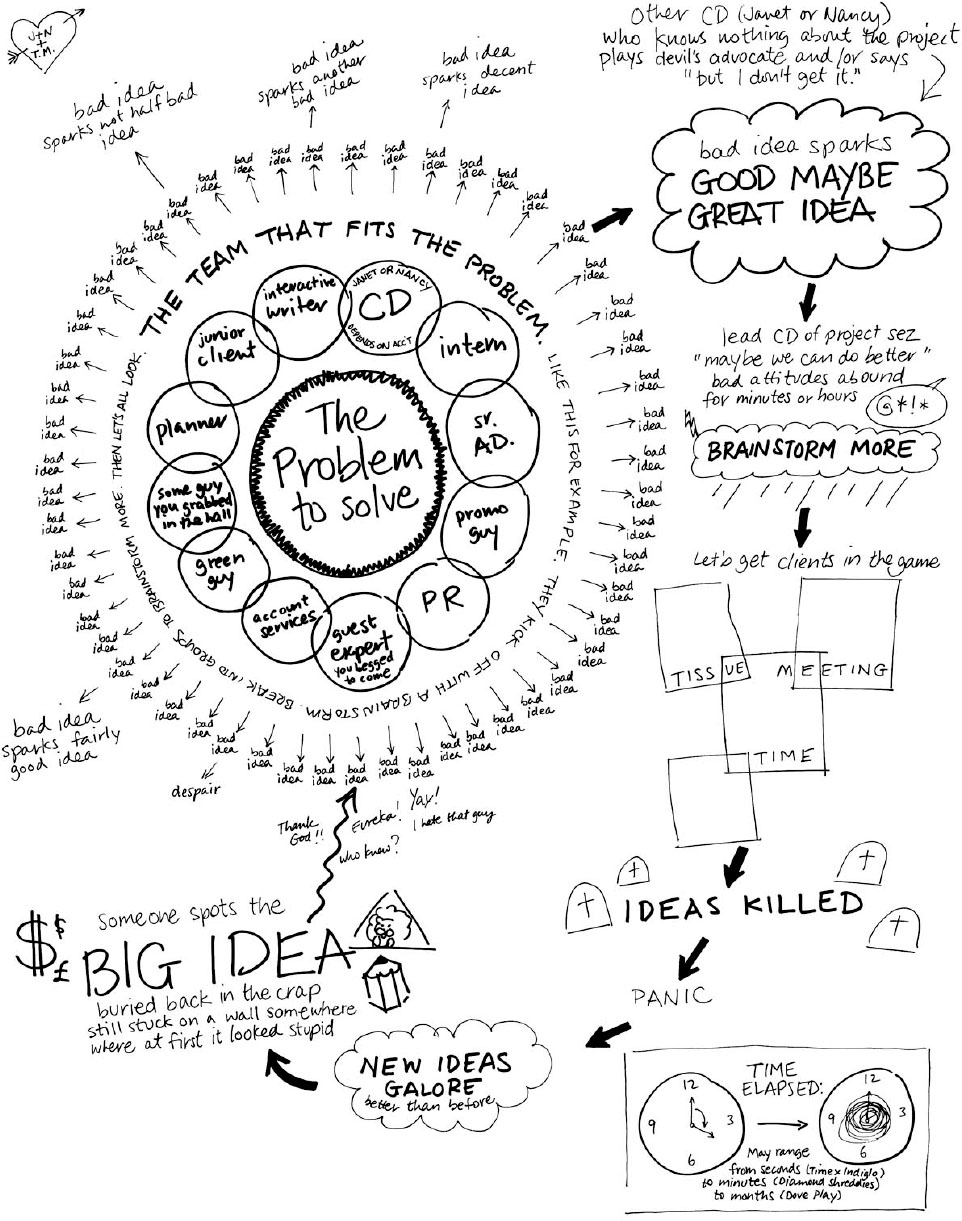
They've been busy. But never too busy to mentor young people and help them find a place in the business. For years now, Kestin and Vonk have written the popular advice column, “Ask Jancy” on the website IHAVEANIDEA (ihaveanidea.org). They also wrote a book, Pick Me, in 2005, sharing their insights about building portfolios and job hunting.
They are role models for women entering this business. But all you guys should be taking notes, too.
Process
“Quantity leads to quality. This observation had a huge impact on Janet and me. Generate a huge pile of (mostly) crappy ideas, as fast as possible. This makes it impossible for your brain to edit or pass judgment (that unfortunate, built-in idea-killer we all have in our hard drives). The law of averages means in a pile of one hundred ideas, spit out in minutes, there will be at least one thought-starter that will get you somewhere. And often, reviewing the pile, some god-awful ideas can trigger great ideas. Nothing is more terrifying than the blank page, at the beginning of any project. Now we leap-frog past the paralysis stage.
“The other fundamental difference in the way I look at getting to big ideas is a media-neutral starting point. The lens you put on chasing a good television spot, for instance, (‘so I'll need a tight little story that works well in thirty seconds’) is entirely different from thinking, ‘What will solve the problem?’ Hunting for a solution to the fundamental business problem leads to a big idea that can then inform many media.

“EVOLUTION” TV SPOT
Agency: Ogilvy & Mather, Toronto, Canada Chief Creative Officers: Janet Kestin, Nancy Vonk Art Directors: Tim Piper, Mike Kirkland Writer: Tim Piper Client: Dove, Unilever Canada
Unilever Canada, a division of Unilever Canada, Inc.
“Another big leg up on the search for great ideas is perspective from many corners. Getting brain cells from not only the core team but also outsiders with experience in other disciplines (and industries, when possible), plus brand-new, non-jaded brains packed with creativity (right out of school) is ideal. I try to get the team together at the outset, as soon as I know the business challenge/opportunity — even before there's a formal briefing document. There never seems to be enough time on a work-back schedule for creative development. Even if the strategy or conditions change in the meantime, this is rarely wasted energy.”
— Nancy Vonk
Partner
“I love Janet's partnership in looking for answers. Environment is always important, and her house is ideal: have a tea, have this home made something I just made, get comfortable on my vintage couch. Let's get some breeze going and start gabbing. Get the gossip out of the way. Then: Charge. (We encourage people to work where they think best. Often that's outside an office full of distractions.)
“Janet is non-judgmental, staring at ideas. She's so good at the delicate back and forth — if she doesn't like something, it doesn't feel like a moment of failure, just a chance to keep going and get to something smarter, more fun, better. She's relentlessly truthful, encouraging, kind. Unlike me, Miss Cut-to-the-Chase. We are yin-yang on the hunt. We often start with Tom Monahan's 100 mph thinking exercise. From there, I count on Janet's creativity, intuition and intelligence to help get to something really interesting. Watching, you'd see talking talking talking silence while we scribble, then more talking, more scribbling, energy levels ranging over the hours from wound up to catatonic. And although she's the copywriter, me the art director, her pad is full of images, mine with words. I can trust her with my fragile ego, bad ideas and potential solutions. The best moment in this business is the one where you recognize a big idea. It might have popped out right at the start, or weeks into the search. I'll always remember Janet blurting out the big idea for one of our best campaigns right at the client briefing. There's no one I'd rather be in the trenches with to figure out the puzzle.”
— Nancy Vonk
INSIGHTS FROM THE PROCESS CANVAS
From one of the most famous teams in the business, a tribute to teamwork.
Never discount the bad ideas. Sometimes good ones are hiding inside them.
A moment of silence, please, for the ideas that get killed.
They are casualties of every project.

“DIAMOND SHREDDIES” OUTDOOR AND PACKAGE REDESIGN
Agency: Ogilvy & Mather, Toronto, Canada Chief Creative Officers: Janet Kestin, Nancy Vonk Art Director: Ivan Pols Writers: Hunter Somerville, Tim Piper Client: Shreddies, Post Cereals
MIKE LESCARBEAU
CHIEF EXECUTIVE OFFICER, CARMICHAEL LYNCH (MINNEAPOLIS, MINNESOTA)


Mike Lescarbeau is known as the guy who can revamp complex organizational systems, write copy that breathes life into brands, and still offer a lopsided grin as part of his executive duties. Few others in the business multitask so well from the executive suite.
Lescarbeau was an early advocate of campaigns that employ new media. In 2001, he launched One and All in Minneapolis as a fully integrated creative resource. The agency won the 4A's O'Toole Award, which recognizes creative excellence across all media, in its first year of eligibility.
Lescarbeau joined Carmichael Lynch as president and chief creative officer from Ogilvy & Mather in New York. Prior to that, he held creative and management positions at Fallon Worldwide, Leagas Delaney and Hill Holiday, where he won Cannes Lions, Effies and One Show Pencils galore.
At Carmichael Lynch, he has reorganized workflow to include media and production insights at the conceptual stage of creative development, resulting in first-time recognition for the agency's online product from the Favourite Website Awards and Creativity. He is responsible for creative work on behalf of all of the agency's clients, which include Harley-Davidson, Jack Link's Beef Jerky and Subaru. In coming to the venerable Carmichael Lynch, Lescarbeau reminded the advertising world that the Minneapolis school of advertising continues to do incredible work with one of its own leading the way.

My drawing falls way short of being an accurate depiction of my creative process, mainly because procrastination is a difficult concept to visualize.
Process
“There isn't an iPhone application for ideas, but if we ever really do map the route to great big thoughts, I'm sure iDea won't be far behind. Given the way Carmichael Lynch makes its money, then, why would I even participate in this exercise? Because I was sure it was hopeless, that's why.
“But then, as my drawing took shape, it started to remind me of something: the models used in network science, that scary new discipline that codifies what were once seen as random associations.
“My drawing falls way short of being an accurate depiction of my creative process, mainly because procrastination is a difficult concept to visualize. But assuming some of the connecting lines between thoughts (the circles) are actually me going to the movies or looking at completely off-topic websites, I guess this about sums it up. One thought leads to another, which can lead to several others, and so on, until I arrive at a useful idea.
“Or not. Sometimes the process just keeps me busy while my partner thinks of something great. I stopped mid-effort, fearful of providing a nugget to some enterprising software developer. Then I started phoning my colleagues, begging them to self-censor.”
— Mike Lescarbeau
Partner
“How to work with Mike Lescarbeau:
Don't expect to sit in an office and grind out concepts. Mike is too ADD for that.
Listen carefully to his stream-of-consciousness ramblings. You may think he's just walking down the hall and talking, but he's actually concepting. Interspersed in his rambling are headlines and storylines. Keep an ear open for them.
Don't expect him to tell you how great his ideas are. Mike is too humble to hand you a single piece of paper and say, ‘Here's the solution.’ I've seen him deliver a brilliant idea with a scribble and a shrug.
Don't expect the expected. He will question the brief, question the media, question everything except the need to deliver the proposition to the audience in a way that makes them take notice.
Even though Mike practically invented the ‘stupid factor’ in copywriting humor, don't expect funny concepts if funny isn't the appropriate voice for the campaign. Some of his best work has more poignancy than humor.
Despite his ‘don't gimme none of that book learnin'’ persona, Mike is a well-read, worldly gentleman. So he's a quick study when it comes to relating and talking to just about any audience.
Don't tinker with his writing too much or you'll wreck it. I know, because I've done it and regretted it.
Do expect to have fun.
“Working with Mike was like playing tennis with someone better than me who has the grace not to pummel me, but patiently brings me up to their level. While some smart people use their smarts to elevate themselves, Mike uses his smarts to elevate everyone in the room.”
— Tom Lichtenheld, Art Director, Artist and Author, Geneva, Illinois
INSIGHTS FROM THE PROCESS CANVAS
Associative thinking is a powerful tool that links one idea to another; this process canvas shows its possibilities.
Sometimes the slightest change of perspective offers a new set of conceptual opportunities.
A simple drawing shows us the bare bones skeleton of a great idea. What a wonderful 3-D hologram this would make.

SUBARU “LOVE” TV SPOT
Agency: Carmichael Lynch, Minneapolis Creative Directors: Randy Hughes, Mike Lescarbeau, Jim Nelson Director of Integrated Production: Joe Grundhoefer Senior Executive Integrated Producer: Brynn Hausmann Director: Scott Hicks, Independent Media Director of Photography: Wally Pfister Executive Producer: Susanne Preissler Client: Subaru
KATE LUMMUS
WRITER, PUBLICIS MODEM (NEW YORK, NEW YORK)


The first thing you need to know about Kate Lummus is that she's from Texas. This is important for a few reasons; it explains her excessive use of “y'all” and her polite yet rebellious nature. And she's quick to explain: She's not a Katherine, Katie or Kaitlyn. Just Kate.
Having started her career in New York City, she's been lucky enough to get experience with both integrated and digital advertising and the opportunity to work on many global brands and well-known campaigns. At Atmosphere BBDO, Lummus helped establish FedEx online, with an interactive video site, simple brand banners and out-of-home installations. She also helped pitch and win the Lay's account, worked on the branding merger of Cingular and AT&T, and dabbled in the Citi business. At Publicis Modem, Lummus works on everything from packaged goods to luxury brands.
Lummus is adventurous. She worked on Capitol Hill as a junior in college, interning for Hillary Clinton. She grew up overseas, living on six continents before the age of fourteen, and loves to travel. That character and spirit shows up in her work.
Process
“I'm not entirely sure how it all comes together.


“COP A FEEL” MAGAZINE AD
Agency: Publicis Modem, New York Executive Creative Director: Patrick Clarke Creative Director: Roald van Wyk Art Director: Katie Kuni Writer: Kate Lummus Client: Yoplait, General Mills, Inc.
©2009 Yoplait USA, Inc.
“All I know is that I trust my brain.
“I know this may sound egotistic, but it works. If I believe I will have the idea, it will come. A sort of mind-field of dreams. Because once that failure pressure is gone, my brain is free to do its thing.
“So I fill it with all the little pieces it might need to put an idea together. I try the product, I read catalogs and blogs and online product reviews. I go to movies I wouldn't normally see, or car shows, or concerts. I just keep going over it in my head. It's all there. It just hasn't been rearranged, revised, rewritten yet.
“Briefs will try to put it together for you, analyze it and tell you what it means. But I already know the idea isn't in the brief. Because the idea is in my head. Somewhere.
“So I rip it up, rearrange it, undo it, decode it and unwind it until I'm out of material.
“Then I get the tape.”
— Kate Lummus
Partner
“I have been working with Kate for almost four years. Even though we have been working together for a while, I cannot say exactly what her creative process is, since I am not inside her head.
“But from the outside, her creative process seems like this:
“While the ideas do come from her brain, they are seriously triggered by so many things around her. Not just product research, or staring at walls. I've seen her come up with ideas about a yogurt supporting breast cancer by watching an MTV show about douchebag boyfriends. They may not seem at first like they are a logical pair, but the angle at which she pieced them together formed a really great idea. She takes all these environmental factors and tries them out with the idea, piecing them all together. It's as if she looks at every idea in a 360-degree mirror all at once, combining it with every related concept. Someone may interpret the idea from one angle, and she attacks all angles. This all combines to form very unique, singular ideas.”
— Katie Kuni, Art Director, Publicis Modem
INSIGHTS FROM THE PROCESS CANVAS
The youngest professional in this book ripped the process canvas to shreds. That's bold. It's a nice quality in a writer, too.
The deconstruction here, both literal and figurative, challenges the preconceived and asserts the need for developing one's own perspective on the problem.

“KNOW YOUR GIRLS” VIRAL ONLINE AD
Agency: Publicis Modem, New York Executive Creative Director: Patrick Clarke Creative Director: Roald van Wyk Art Director: Katie Kuni Writer: Kate Lummus Client: Yoplait, General Mills, Inc.
©2009 Yoplait USA, Inc.
SIMON MAINWARING
CREATIVE DIRECTOR/WRITER, FREELANCE AND CONSULTANCY (LOS ANGELES, CALIFORNIA)
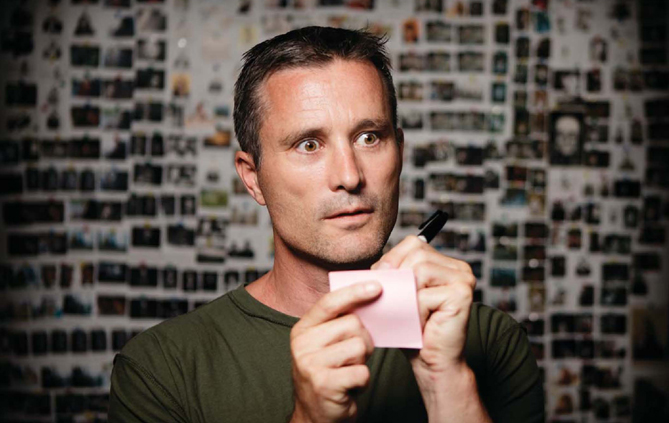

Simon Mainwaring believes in staying ahead of the curve. His work over the last twenty years proves it: Besides Nike and Motorola, he's been the creative brand leader on News Corporation's Global Energy Initiative, Las Vegas's carbon-neutral “Zero City” Project, as well as the launch of all three generations of the Toyota Prius. Along the way, he's worked at Ogilvy & Mather, Wieden+Kennedy, Saatchi & Saatchi, TBWA\Chiat\Day, Leagas Delaney, and Goodby, Silverstein & Partners, and has picked up more than eighty international awards at Cannes Lions, The One Show, and D&AD. A colleague tells us: “Simon is the guy who reminds us we really can do something of value for the world if we fight for it. He demands that we own our integrity.”
Today, through his brand consultancy firm, Mainwaring is broadening his influence. His social media clients include TED Prize, ONE, Clinton Global Initiative and the X PRIZE Foundation, while his philanthropic work includes the Environmental Protection Authority in Australia, the Multiple Sclerosis Society in London, the Robin Hood Foundation's Uncommon Schools project and the American Diabetes Association. Mainwaring writes for the online sites PSFK, Brain Pickings and Social Media Today, while his own blog focuses on how the intersection between branding, technology and social media is changing our lives. His upcoming book will forecast how social media can transform our world.

My only wish is that I would have learned earlier that I do not need to prove anything to others or myself.
Mainwaring studied law and fine arts at the University of Sydney, theater with Larry Moss in New York and voice with Patsy Rodenburg at London's Royal National Theater. He's a dad and an Australian, and he believes you can only see what's coming if you stay out front. So, that's where you'll find him, ahead of the curve and urging us all to follow.
Process
“It took me a long time to learn that good ideas are simple, emotional and human. It's an easy thing to say, but it takes training and a lot of mistakes to get to the point where you instinctively think that way.
“That means I have a reckless but hard-won trust of my first thought, ‘gut’ reactions; a solid commitment not to over-think; a profound respect for the work the brain does when it's not thinking about something. And a core belief that if you want to create anything new, you must always look outside your own work or industry for inspiration.
“The moment when an idea reveals itself is as much a thrill today as it was twenty years ago. My only wish is that I would have learned earlier that I do not need to prove anything to others or myself. That pressure only gets in the way of us doing justice to our creative potential.
“No matter how we approach creative work, it should be fun. The arts are an enormous playroom where we get to behave like children, never looking for answers where we are told to, but instead heading off in unknown directions. The joy comes in the surprise of finding what we didn't know was there. There is great power in approaching life this way, leaving us free to discover the answers only creativity can find and, in so doing, revealing our shared humanity.”
— Simon Mainwaring
Partner
“As I write this note in honor of Simon's ‘singular’ creative prowess, I am reminded that one simple, honest — perhaps even dull — idea (when one has a good partner) will always lead to the next ‘slightly better’ idea, which then leads to the next and so forth and so on.
“They are stories told to each other. Napkins sketched and scribbled on. They are hours and days (usually hours, given the state of advertising today) searching and then finding.
“It is my understanding and witness that Simon excels in this team dynamic. This quality, again, in my opinion, is Simon's first and best compliment, to be sure.
“It is his absolute adherence to pop culture that inspires. This is the nucleus of his idea generating.
“As we start down the creative path, he and I, we adhere to a strict ‘blank-stare policy’ — not knowing what, if anything, will come to mind or, worse, worrying if we are finally that one beer past our limit on creative brain cell depletion.
“And then, as we always do, we course-correct and restart the process:
“Simon: What's happening right now in culture? How can we — right now — affect positive change? Is the brand's core belief valid and living in real time? Is their brand behavior bold enough? How can we insert our client into the very center of change sweeping the cultural landscape? What do they have to offer? What conversations are taking place? How can we be a part of those conversations? Where are those conver-sations intersecting? Should our client follow pop culture or lead pop culture?
“Joe: Should we order lunch?
“And then, as we always do, we tell a great story.”
— Joe Shands, Creative Director, TBWA\ Chiat\Day, Los Angeles
INSIGHTS FROM THE PROCESS CANVAS
Here's an impressive decision tree covering all contingencies. That's a mark of experience.
A Janusian awareness of paradox is clear: Simplicity affords complexity; everything unrelated is relevant; always begin at the end.
Culling and editing involves both self-doubt and self-confidence.
CAL McALLISTER
CO-FOUNDER/CREATIVE DIRECTOR, WEXLEY SCHOOL FOR GIRLS (SEATTLE, WASHINGTON)
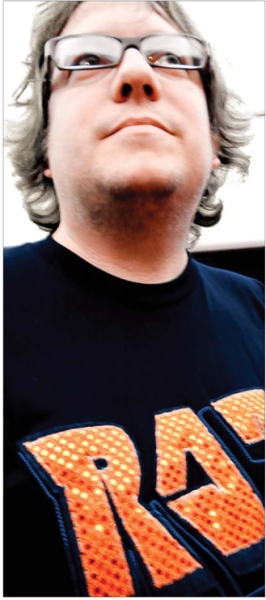
© 2010 Karen Kuehn. www.karenkuehn.com
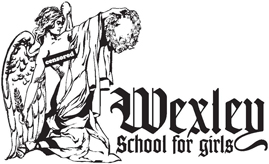
Cal McAllister is a proud Detroit native who cut his teeth as a beat writer for Chicago Tribune. After getting in a lot of trouble for making things up, he switched to advertising.
Before co-founding Wexley School for Girls with Ian Cohen in 2003, he worked on regional, national and international business at small shops such as WONGDOODY and global agencies such as Foote, Cone & Belding and Publicis Worldwide. He's worked on the brands Nike, ESPN, Microsoft, Xbox, T-Mobile, Mothers Against Drunk Driving (MADD), Coca-Cola, the Amer-ican Red Cross, Amstel Light and NASCAR, to name a few.
His work has been recognized by almost every international advertising award show and journal, including the Cannes Lions, the Clios, Communication Arts, the Art Directors Club and The One Show. As a screenwriter, his films have been selected by and screened at the Seattle International Film Festival, Slamdance, the Chicago Short Film Festival, AtomFilms and the RESFEST International Film Festival, among others.
Cal's six-year-old niece, Louisa, offers this: “Uncle Cow is a man, and he is nice! He is a joyfle man. He has 2 neeses, and 1 nefuwe. He likes chikins. He has soft scruffy hair. He has a nice wife named Amanda who takes showers 100 times a day. He has a verey good tast. He is a strong man. He is a writer at Wexley School for girls. His favorite house anamle is a dog. And he is a verey good prson.”

I like to hear little stories, little truths, and see how they tie together. Then I'll make something up to keep it interesting.
Process
“I am happiest with too much information. Some folks feel that contaminates their thinking, gets them too close to the product. I'm the other way around. I have a journalism degree and was a Chicago Tribune reporter when I first graduated from Ohio State, so maybe it was the training.
“Go get lots and lots of material and sculpt and sandblast and whittle it down to relevancy. Then do it again.
“I don't consider myself a great creator. I like to hear little stories, little truths, and see how they tie together. Then I'll make something up to keep it interesting. But I need to start somewhere.”
— Cal McAllister
Partner
“Cal and I think pretty similarly. We tend to approach our work in short creative bursts. It seems to me that he likes to put just enough time pressure on himself so that the creative will explode from that pressure. He also wants enough time to edit and think through ideas. He likes the little details. He likes to fire off a lot of random ideas and approach every single problem, no matter how small, like he can create something amazing for it. So, in that sense, to use a football analogy, he rarely takes a play off.”
— Ian Cohen, Co-Founder/Creative Director, Wexley School for Girls
INSIGHTS FROM THE PROCESS CANVAS
Creative pros must know how to multitask (think: octopus). Multiple projects for multiple clients are always in play, each at different stages with their own demands for the mind's attention.
The world around us offers context. Everything we experience informs and influences creative thinking, whether or not it has anything to do with advertising.

“PARKING SPACE” AMBIENT AD
Agency: Wexley School for Girls, Seattle Art Director: Kohl Norville Writer: Cal McAllister Client: Mothers Against Drunk Driving (MADD)
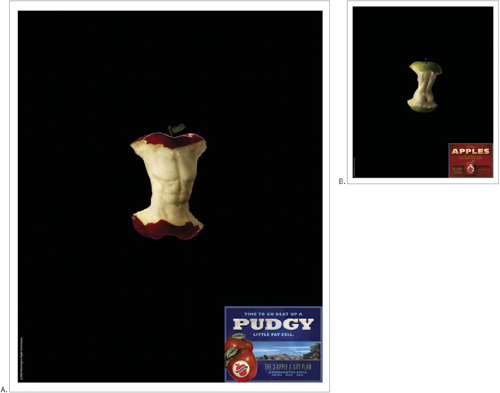
“THE 3-APPLE A DAY PLAN” MAGAZINE ADS
A. Headline: Time to go beat up a pudgy little fat cell. B. Headline: A few apples a day keeps the lipo doctor away. Agency: Wexley School for Girls, Seattle Art Director: Rob Rich Writer: Cal McAllister Client: Washington Apple Commission
JIM MOUNTJOY
FOUNDING PARTNER/EXECUTIVE VICE PRESIDENT/CREATIVE DIRECTOR, LOEFFLER KETCHUM MOUNTJOY (CHARLOTTE, NORTH CAROLINA)

Jim Mountjoy (second from left) enjoying the great outdoors.

North Carolina owes a debt to Jim Mountjoy. His thirty-plus-year career has been spent in Charlotte at the agency that bears his name, Loeffler Ketchum Mountjoy, started with a couple of friends and a couple of clients before he had graduated college. He's kept talent and vision at home — even as he took national and international honors in The One Show, the Art Directors Club, Communication Arts, Graphis and other shows — and was named twice by Adweek as the Southeast's top creative director. He is also a three-time finalist for the MPA Kelly Award for the best magazine ad campaign in America. It's not hard to figure out why the University of North Carolina named Jim to its hall of fame.
His breathtaking work for North Carolina Travel and Tourism Division and Outward Bound show his investment in the state: LKM's tourism ads teach us all how visualizations of natural beauty can help drive an economy. His careful creative mentorship of some of the country's best thinkers over the years inspires young creatives, many of them thinking, “It's either New York or Charlotte, North Carolina, for me.” That's power.

Creative leadership is expected of you and you have the responsibility to take bolder steps that are needed to transcend rote thinking and answers.
Mountjoy has built a reputation as a gracious and generous teacher, mentor and industry leader. He served on the board of directors for The One Club and currently serves on the board of advisors for Creative Circus, an Atlanta portfolio school for advertising and design. He's now teaching and building creative curriculum at Queens University of Charlotte, another lasting gift to his home state.
Process
“Creativity is about building trust. First, you prove to people and yourself you are disciplined enough to cross your t's and dot your i's in all the basics as well as being responsible to others. From there, you move to a more intimate and deeper knowledge of the needs, expectations and goals of others and synthesize this into original insights that are valued. Next, it's usually at this stage others begin to not only trust you, but place a measure of faith in your ideas and actions. Now creative leadership is expected of you and you have the responsibility to take bolder steps that are needed to transcend rote thinking and answers. Sounds a bit scientific, but the art is in doing it every day with passion.”
— Jim Mountjoy
Partner
“Every time I've gotten an assignment from Jim Mountjoy, it was serious. Meaning I never got the ad-world run around. The ideas I was asked to execute were as clear as a bell on a Sunday morning in an Italian village.
“I always loved and respected his solution to a communication brief from his clients, be it tourism, flooring or handmade windows. He has a wonderful way with words, and I wished I had recorded the telephonic briefs I've gotten over the years. I was allowed to be my best at all times and never expected to second-guess what someone else may think of my interpretation of his ideas. The atmosphere that created was sublime. He would always bring something extra to the table while on a shoot, as his mind was constantly working at keeping the thought process alive: Here's another ball — run with it, dude. What a privilege.
“Not to mention his ‘Southern’ humor. Every shoot had a huge quota of belly laughs, day and night, be it driving through the North Carolina landscape or walking in the freezing cold in Manhattan. Jim Mountjoy is a Southern gentleman who has graced the American advertising community with his wit and brilliant thinking.”
— Harry De Zitter, Photographer, Naples, Florida
INSIGHTS FROM THE PROCESS CANVAS
Many creatives don't respect creative briefs. Here's one who does. Look at how he uses it.
Ideas evolve. Finding simplicity leads to elegance.


“HAND” AND “ROPE” MAGAZINE ADS
Agency: Loeffler Ketchum Mountjoy, Charlotte, North Carolina Creative Director: Jim Mountjoy Art Director: Doug Pedersen Writer: Curtis Smith Client: Outward Bound
DOUG PEDERSEN
ASSOCIATE CREATIVE DIRECTOR/ART DIRECTOR, CARMICHAEL LYNCH (MINNEAPOLIS, MINNESOTA)


Sometimes it pays to be a regular guy with remarkable talent. It makes other talented people want to work with you. It builds your career. It lets you make choices about where you want to live and how you want that life to be.
Doug Pedersen is living proof of this. Courted by many agencies because of his remarkable junior book, Pedersen landed at Loeffler Ketchum Mountjoy in North Carolina, a wonderland of talented people in a small, designerly agency with mentors like Jim Mountjoy to guide him. In his first two years, he won more awards — Gold Pencils, Cannes Lions — than he might have ever dreamed.
Pedersen stayed at LKM for nine years and worked on the Outward Bound and North Carolina tourism projects to the benefit of the agency's clients and his own career. From there, he headed to Crispin Porter + Bogusky in Miami, and later, Carmichael Lynch in Minneapolis.


“PEACE AND QUIET” MAGAZINE AD
Headline: The extended forecast calls for periods of peace followed by quiet. Agency: Carmichael Lynch, Minneapolis Creative Director: Mike Haeg Art Director: Doug Pedersen Creative Director/Writer: Heath Pochucha Client: Bell Canoe Works
Over the course of his career, he has helped produce advertising campaigns for Volkswagen, Harley-Davidson, Subaru, Burger King, Miller Lite and a long list of others.
Maybe the best part of the story is that he remains a grounded, good guy. “Nicest guy, I know,” they say. “And with all that talent. What a package.”
Process
“The Big Stuff:
“To do truly great work, you have to see your work as more than just work. You have an almost unhealthy obsession with creating great ideas and crafting them.
“But you have to have someone in your life who helps you bring at least some balance back to it. For me, it's my wife. She's always understood my passion, but at the same time she's helped me remember that there are other important things in life that you'll regret overlooking if you don't turn work off every now and then.
“Find great mentors. I've been lucky to have several over the years. My professors. My first creative director, Jim Mountjoy. My mother. My wife. For me, the best mentors have always shown you not just how to be better at your work but they've also stressed the importance of being a good person and keeping your ego in check.
“The Little Stuff:
“I get into work super early most days so that I have a couple hours to think before the chaos starts. I'm far more of a morning person than a night person.
“I spend at least half my time feeling like a hack. This way I stay driven to create better and better solutions for clients.
“I let the details bother me. There's nothing worse than creating something and then cringing when you look back at it a few months or years later because you overlooked some of the little things that could have made the work even better.
“Realize that the best solutions can come at the beginning or the end of the concepting process. Regardless of where they happen along the way, its important to keep pushing yourself to keep coming up with more work since you never know if you'll beat the ideas you already have.”
— Doug Pedersen
Partner
“Like other insanely talented fine artists who find themselves in advertising, Doug Pedersen seems to process ad briefs visually, turning spoken thoughts into pictures even as he hears them. I suspect he does this without really thinking about it, which may be the secret to his success. Doug feels an advertising brief by translating it into a visual language that's meaningful to him personally. I think that's why his work makes such a strong connection with people who see it.
“One example is a series Doug did for Bell Canoe Works with his partner, the brilliant copywriter Heath Pochucha. Doug created the illustrations himself, and in them, he literally shows us what being on the water feels like. And he manages to nail just the right energy across the whole line of Bell products — from the serenity and solitude of Bell's touring canoes to the manic, swirling adrenaline of their class-five kayaks.
“Doug Pedersen's talent is that he constructs more than just an intellectual case for a brand. He uses his gift for art to make a motorcycle or a canoe into something much, much more than that. Something you might not have imagined yourself, but something you're real glad he did.”
— Mike Lescarbeau, Chief Executive Officer, Carmichael Lynch
INSIGHTS FROM THE PROCESS CANVAS
Modesty yields a bit of shorthand. High-quality work belies the timeline presented here.
The ways creatives visualize time and space, particularly as parameters for a project, are fascinating.
Note the proportions of time here. Incubation and experimentation happen for as long as we'll allow. Deadlines demand an answer!
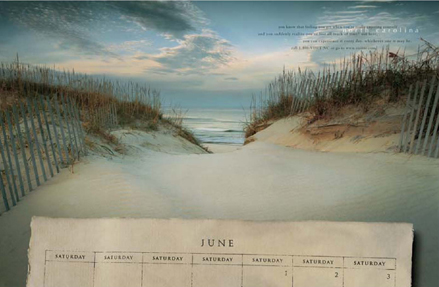
“CALENDAR” MAGAZINE AD
Agency: Loeffler Ketchum Mountjoy, Charlotte, North Carolina Creative Director: Jim Mountjoy Art Director: Doug Pedersen Creative Director/Writer: Curtis Smith Client: North Carolina Travel and Tourism Division
NANCY RICE
FOUNDING PARTNER, FALLON McELLIGOTT RICE (MINNEAPOLIS, MINNESOTA)

Nancy Rice working with her students at the Minneapolis College of Art and Design (MCAD).
© 2009 Star Tribune, Minneapolis-St. Paul.

Nancy Rice is a living legend and one of the most accomplished women in advertising history. She has held senior creative posts with agencies DDB Needham, Ogilvy & Mather and BBDO, among others. In 1981, she was a founding partner of Fallon McElligott Rice (now Fallon Worldwide), which was named Agency of the Year by Advertising Age only three years later.
In 1986, Rice was named Art Director of the Year by the Art Directors Club, and in 1989, her “Perception/Reality” campaign for Rolling Stone magazine was recognized as one of the ten best of the decade by Adweek and The One Club. In 1997, she became one of only six Americans to have her work documented in the British Design and Art Direction Annual. In 2006, she was inducted into the Art Directors Club Hall of Fame. Her work appears in countless award annuals. Did we mention she raised two children along the way?
Rice's focus turned to education as she was named worldwide creative director of Miami Ad School in 2001. Most recently, Rice served as coordinator of the advertising program at her alma mater, the Minneapolis College of Art and Design (MCAD).
Her long and productive career continues to inspire both students and professionals. Her secret? She likes to quote actress Ruth Gordon, who once said, “To be somebody, you must last.”
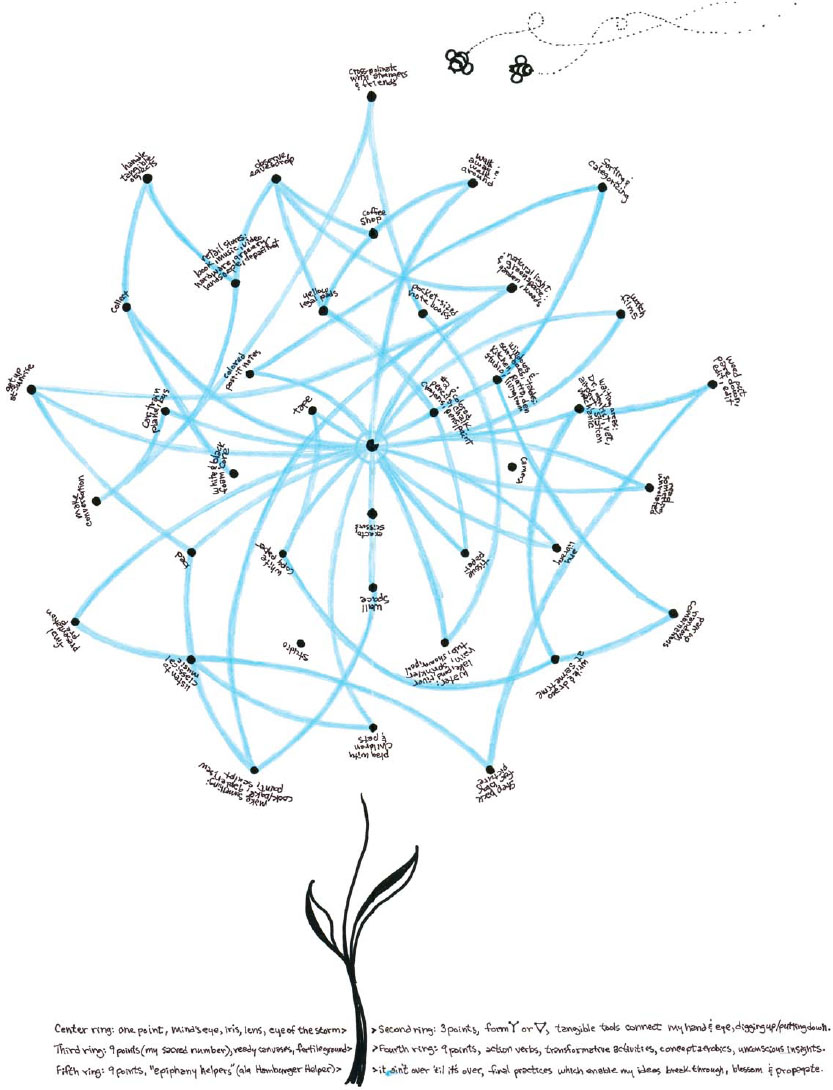
The ability to both engage and disengage without fear at the appropriate moment is also tantamount to my creativity and outcome.
Process
“My creative process has always been fluid, physical, instinctual, non-linear, varied each time. How do you draw that? Many elements come to play (with my muse and me) each time: actions, interactions, tangible tools, intervals of calm and chaos, all five senses, nature and geometry. The ability to both engage and disengage without fear at the appropriate moment is also tantamount to my creativity and outcome.
“The image that emerges from my process is circular (sacred to me) and is influenced, no doubt, by my Celtic roots! The plot points within the circle could have spoken to my mind's eye as fireworks, a wheel, a snowflake, a constellation, a pinwheel, a fountain or an airline route map — even the icing atop an elaborate dessert. But when I connected them, the geometry revealed a beautiful abstract flower. I gather inspiration from everywhere, so who was I to argue? I love the vigor, surprise and geometry of organizing, arranging and delivering an aromatic bouquet.
“It's both intimidating and inspiring to think about my personal creativity — my favorite combination!”
— Nancy Rice
Partner
“There's a story about a copywriter who once slammed his fist through Nancy Rice's office wall in a fit of frustration. The story is true. The writer in question had just learned a painful lesson: When working with Nancy, it's best to check your ego at the door. As everyone discovers sooner or later, she will not be intimidated, cajoled, coerced, threatened, lambasted, bribed, begged, bored or even complimented into accepting an idea — hers or yours — unless and until she's convinced of its rightness and originality.
“That's not to suggest that she was ever one to lose her temper or behave with anything less than grace and aplomb. On the contrary, when confronted with a bad idea, she had a simple and effective solution. Nancy would sit back from her drawing board and patiently wait until her sometimes exasperated creative partner was ready to return to the hard work and, yes, fun of making great advertising.
“Nancy has always had a way of keeping people honest, of getting the best from both herself and others. Sometimes when it meant serious sacrifice on her part. Sometimes, in fact, when it would have been far, far easier for pretty good rather than great. Compromise was just never part of her vocabulary.”
— Tom McElligott, Founding Partner, Fallon McElligott Rice
INSIGHTS FROM THE PROCESS CANVAS
Work environment contributes to process. “Natural light” and “wall space” can be key to an individual's productivity.
The visual metaphor here, a flower, connects to the idea that process is organic and must be nurtured in order to grow and blossom.
The tools creators use are beloved, specific and essential: The “yellow legal pad” might be perfect for one, while another might insist upon a journal with white, unlined pages.
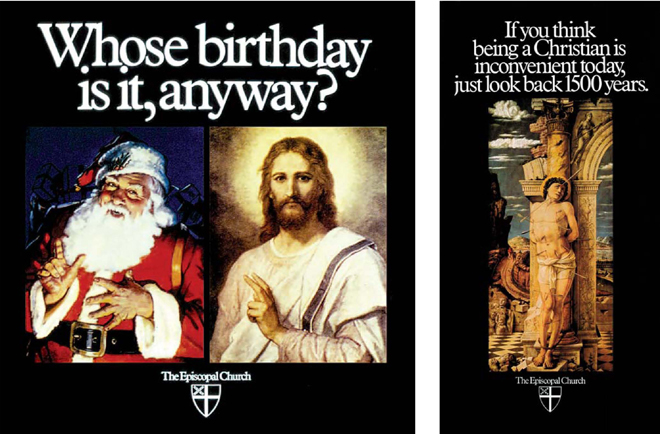
“WHOSE BIRTHDAY” AND “IF YOU THINK” PRINT ADS
Agency: Fallon McElligott Rice, Minneapolis Creative Director/Art Director: Nancy Rice Creative Director/Writer: Tom McElligott Client: The Episcopal Church
©1983 Church Ad Project
KEVIN RODDY
CHIEF CREATIVE OFFICER, BBH (NEW YORK, NEW YORK)


After graduating from the University of Oregon, Kevin Roddy took a somewhat different path to a job in advertising copywriting. He avoided art school, ignored creative writing classes and, instead, jumped headfirst into account management. But after years of writing nothing more creative than the occasional memo, Roddy made the transition to the creative department and never looked back. As a writer, he worked at several agencies on his way to BBH, including Fallon Worldwide and Cliff Freeman & Partners on a client roster that any creative would love... Little Caesars, Staples, Volvo, Coca-Cola, Electronic Arts, Timber-land, Time and Sports Illustrated magazines, FOX Sports, FX Network. The big names.
In 2004, Roddy began his role as the executive creative director of BBH New York and, in that time, has helped the agency undergo a transformation. With Roddy's creative leadership, the agency has forged into new and broader creative territories, including, for starters, a television series on MTV for Axe called The Gamekillers; a YouTube sensation for Smirnoff Raw Tea called Tea Partay; and, most recently, the innovative launch of the new Oasis album, Dig Out Your Soul, via street musicians on the streets of New York City. As testimony to all this success, BBH New York recently named Roddy its Chief Creative Officer.
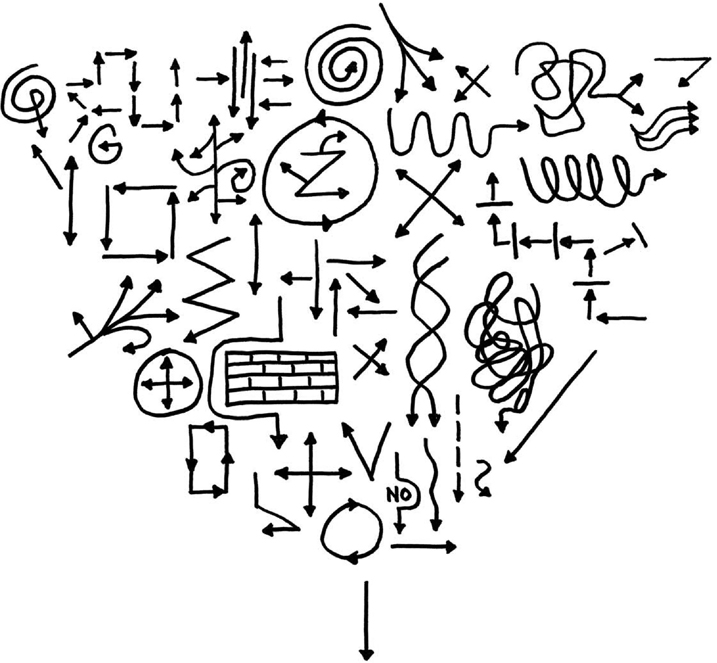
For me, creativity is messy. It's random and unstructured and unpredictable. It's a lot of stopping and starting, experimenting and failing. It has tunnels, bridges, deep holes and high walls.
Boards magazine has twice ranked Roddy among the top three of its Top Ten Copywriters worldwide list, and he has won every major creative award in the world several times over. In fact, he's the only person in advertising ever to have won The One Show's Best of Show award twice. Roddy is also chairman of The One Club, one of the world's leading organizations to champion and promote creative excellence in advertising and design in all its forms. After all the awards and accolades, Roddy is still a writer, loving the start of another big idea.
Process
“For me, creativity is messy. It's random and unstructured and unpredictable. It's a lot of stopping and starting, experimenting and failing. It has tunnels, bridges, deep holes and high walls. Did I mention holes and walls? It involves an incredible amount of questioning things and myself, and feeling ridiculously insecure. And I like it that way. I know there are people who want to control it because, at least in advertising, it has a defined purpose. But I always fight the urge those people have to understand and compartmentalize the creative process. I find comfort in not knowing where it's going. I need that time and space. I need to avoid structure to eventually find it. There are a lot of people who have intelligence and good sense, and I try to avoid those people because, in my creative process, they are not my friends. There is a time and place in advertising for creativity and good sense to connect but, for me, the two should never travel together on the same path.”
— Kevin Roddy
Partner
“Kevin is an unusual creative director. He didn't start his advertising career in the creative department. He started out in management. He was an account handler.
“You could argue his late conversion to creativity should work against him.

AXE DEODORANT'S “THE GAMEKILLERS”
Agency: BBH, New York Executive Creative Director: Kevin Roddy Creative Director: William Gelner Art Director: Jon Randazzo Client: Axe
“The Gamekillers” campaign played out in ads, ambient projects and on MTV. The Axe brand is positioned as more than a personal care product — it's a tool in the art of seduction. “The Gamekillers” concept offered young guys advice and insights for improving their “game” with girls by avoiding the archetypes that might stand in their way.
“I actually think the opposite.
“His varied journey to the role of chief creative officer is partly what makes him great. It gives him perspective. It has made him a better creative thinker and leader.
“Experience is the foundation of creativity. Nothing can be created in a vacuum. It's impossible. Of course, experience doesn't make creative people great, but it does make it more likely.
“Also, to be a great creative leader, you have to have the respect of other creatives. And you have to know how to encourage people to fail. They have to have permission to get it wrong. And to let them know, whatever, they'll be supported. It's these qualities that make Kevin an outstanding creative leader.
“Which is great, because it certainly isn't his dress sense. I've never seen Kevin in anything but an oversized shirt, worn outside his blue jeans and always with an old pair of Timberland boots.
“What Kevin lacks in dress sense he makes up for in creative intuition.”
— Sir John Hegarty, Co-Founder, Bartle Bogle Hegarty, London
INSIGHTS FROM THE PROCESS CANVAS
The energy evident in this drawing is spectacular, a marvelous review of how people and ideas are in dynamic movement during process.
There's a story in each line. Seasoned professionals can look at this and know the nuance of making stuff happen.
Beauty, chaos, wit. There's the kind of arc you'd find in a movie script here, with a culminating moment that we know resulted in something big.

DIG OUT YOUR SOUL ALBUM LAUNCH
Agency: BBH, New York Chief Creative Officer: Kevin Roddy Creative Directors: Pelle Sjönell, Calle Sjönell Account Supervisor: Chris Wollen Producer: Julian Katz; The Molloys, HSI Productions Client: Warner Music Group Performers: Meghan McGeary and Jim Bauer of DAGMAR
BBH teamed with Warner Music Group and New York City to reinvent the album launch for Oasis's seventh studio album, Dig Out Your Soul. The ambient campaign introduced new music on the streets of New York City, where band members taught street musicians — all members of the Metropolitan Transportation Authority's Music Under New York program — to play their songs for two weeks leading up to the album release in 2008.
RYAN ROMERO
SENIOR INTERACTIVE COPYWRITER, PUBLICIS IN THE WEST (SEATTLE, WASHINGTON)
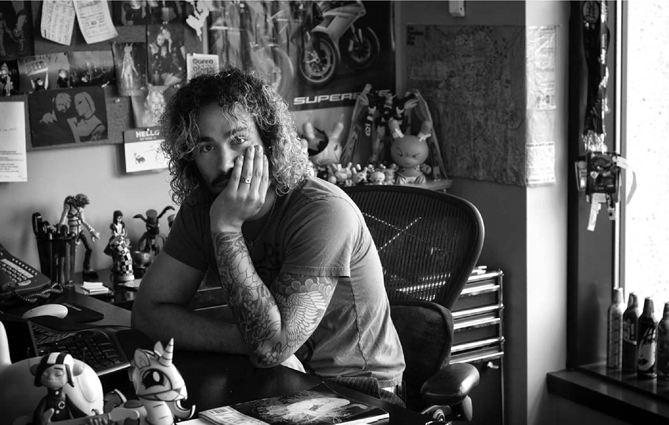

Ryan Romero always wanted to be in advertising. As an eight-year-old, he thought the dialogue in the G.I. Joe commercials could be better.
His career began in Dallas, at a small traditional shop where he was the sole copywriter on accounts such as Taco Bueno and Community Coffee. His passion, however, lay in interactive. So, he made a bold move, and a short trip, across the building to the offices of Tribal DDB in 2006. While there, he helped produce effervescent online work for Pepsi and Mountain Dew and learned to spell and pronounce Wojciechowski (his creative director's last name).
In 2008, Romero moved to Seattle, taking a job at Publicis in the West. His stated mission is “to deliver ideas that integrate traditional and digital advertising.”
Romero lives with his beautiful wife, two dogs and a rapidly expanding collection of Dunny vinyl figures, flat stock posters and pop art. Romero is a Ducati motorcycle rider, disc golf player, tattoo canvas, citizen of Black Rock City and pretend grown up.
Process
“My creative process is constantly evolving, hard to pin down and, often, not a process at all. Sometimes it involves sitting in a small room with my partner drawing on white boards. Sometimes it's a headphones-on solo exercise in forced focus. Occasionally, an idea will make itself known while I'm walking to lunch, causing me to frantically type cryptic notes into my phone only to later wonder what the hell they mean.
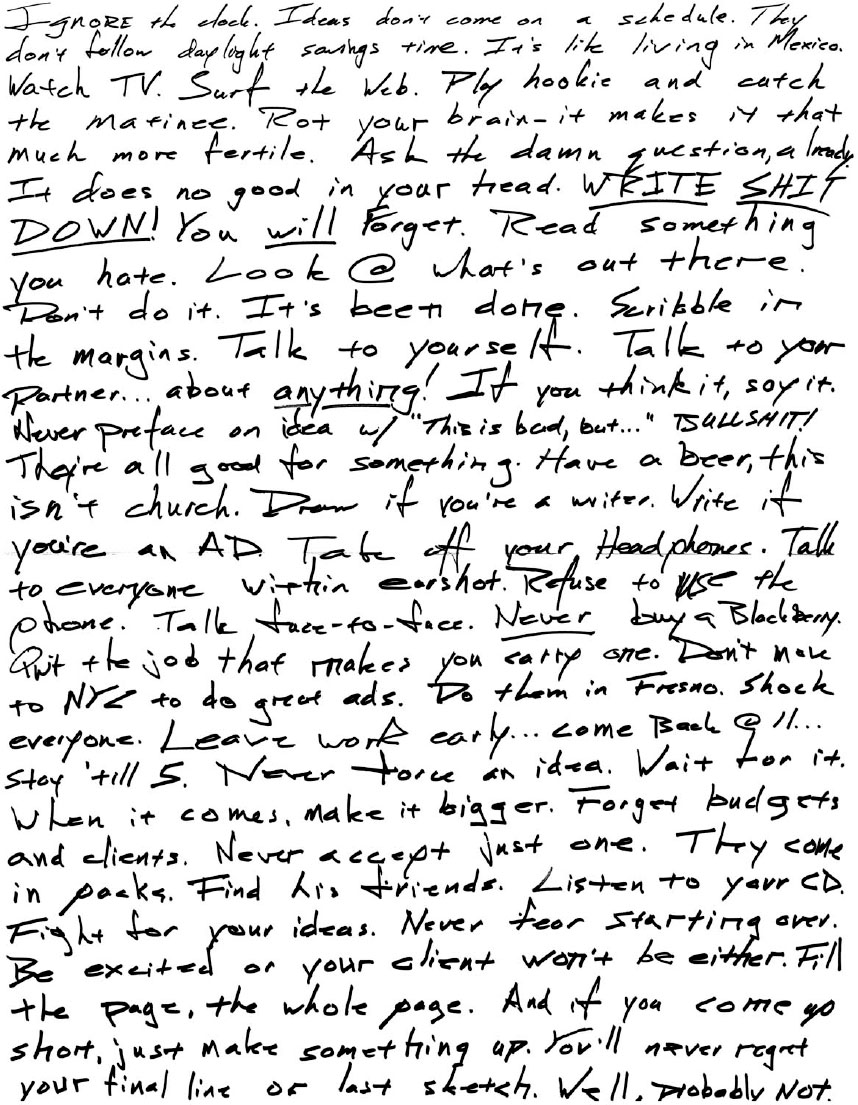
Logic doesn't work for me. Logic is what I come up with after the big idea is formed to explain to clients why it all makes sense.
“I've been told I should be more disciplined. That I should form a routine, write more lists or somehow better organize my thought process. But logic doesn't work for me. Logic is what I come up with after the big idea is formed to explain to clients why it all makes sense. ‘Because it works,’ doesn't convince as many people as you'd think.
“I've never been the type to throw out tons of ideas. My internal editor is impossible to turn off. Which means I need a partner who doesn't shut up. Bad ideas, random thoughts, strange music and anything outside my comfort zone are all necessary evils in my process. Make me hate something and I'll come back with a better idea. Give me a halfway acceptable thought and I get lazy. Maybe I'm just confrontational.
“In the end, I believe. I have to.
“I come in every day and work for the big idea, but it shows up on its own schedule. So, I have to have faith it will emerge eventually and hope to hell it's not too late when it does.”
— Ryan Romero
Partner
“I can't imagine putting the mind of Ryan Romero on paper. You really have to experience it. For me, being his partner was easy, although his process was to go against a process.
“Anytime we'd sit and concept, we'd never let the day-to-day bullshit hold us up, whether it was agency politics or personal matters. We had a vibe: sitting in front of each other, starting to think and flow. This was our starting point: What is the problem or main objective? Then, from there, we came up with solutions using whatever approach felt right. There was not a predictable pattern. But we did always try to generate as many ideas as possible, because one was never good enough.
“The great thing about working with Ryan was our dynamic. When we had great ideas, we let each other know. And when we had awful ideas, we let each other know that, too. That is what makes a great team. I think Ryan pushes people to get the best out of them. He makes them think and explore parts of their mind they might not have on their own. And when you see Ryan, you will always catch him carrying his black book full of ideas.”
— Brandy Cole, Senior Art Director, Tribal DDB, Dallas
INSIGHTS FROM THE PROCESS CANVAS
The imperative statements here are marks of conviction. Every sentence is based on a lesson learned firsthand.
Mentoring is an agency ritual. Always listen. Never stop being a student.
LUKE SULLIVAN
GROUP CREATIVE DIRECTOR, GSD&M (AUSTIN, TEXAS)


Luke Sullivan is a rock star. Students of the craft know him from his beloved book, Hey Whipple, Squeeze This, dog-eared copies of which can be found at every ad school around the world. When he speaks to classes, he insists that language and words mean something. “Writers have to love the act of writing,” he says. To illustrate that point: Journals that he has filled over the years line the walls of his home study, a testament to his love for the craft.
He began his career as the understudy to the famed Tom McElligott at Bozell & Jacobs in Minneapolis, where, he says, McElligott “helped teach me to write, to build friction into your work so that your message doesn't just lie there, but requires something of you.”
A ten-year stint at the Minneapolis agency Fallon McElligott Rice propelled him to industry fame. He also served as vice president of The Martin Agency in Richmond, Virginia, working alongside agency lead Mike Hughes. Hughes, according to Sullivan, “taught me how important it is to be a nice person in this business. He is a kind-hearted soul, and you work your tail off for him because you love him so much.”

Then I stare at that little white space. I just stare. And I try to fill it with something interesting.
In the 1990s, Sullivan was named chief creative officer of Atlanta's WestWayne. After four years there, he moved to Aus-tin. Today, he is group creative head at GSD&M.
The quality of Sullivan's work makes the Whipple book worth reading and has earned him credibility among young people and the industry. He's been named to Adweek's list of the top ten copywriters in America twice. He's won dozens of top-flight awards from The One Show, Cannes Lions, Communication Arts, and London's D&AD show. The brands that bear his mark — among them AT&T, Miller Lite, United Airlines, Lee Jeans and Ralston Purina, as well as Porsche, BMW and Maserati — offer a cross-section of American life.
Process
(Reprinted from “How to Write a Newspaper Ad,” Newspaper Association of America, www.nna.org.)
“I draw a little blank white square. About one inch wide, two inches deep. I figure if I can't get my idea inside of that small space, it must not be a very big idea and it's only going to look worse filling up a 13″ × 21″ newspaper page.
“Then I stare at that little white space. I just stare. And I try to fill it with something interesting. Unfailingly, the first one hundred ideas that I draw inside that little white square are awful little things.
“That's when it starts: a special sort of chest-splitting panic known only to people whose work is produced on a deadline and appears in forums as public as the newspaper.
“To deal with this horror, mature writers pour another cup of coffee and buckle in. I, however, remember that the movie Memento just opened and sneak out of the agency leaving a Post-it note (‘at focus group, have cell phone’) stuck on the desk, next to my cell phone.
“After I come back from the movie, Idea #101 comes along. It's not great, but it's ‘pretty good.’ Braced with this small victory, I change gears. If I've been thinking verbally, I switch to visual.
“Finally, my pen starts moving. But upon review, Ideas #102 through #130 all stink, and I go home in despair. The next day or maybe the next week I discover Idea #101 clicks like a Lego into Idea #131.
“‘Wow,’ I think. ‘It's not bad.’ And the anvil that has been on my chest since the day I started writing, slides off.”
— Luke Sullivan
Partner
“Luke and I worked together as partners quite early in our careers, and I was impressed by his early ability to do it all: strategic thinking, copywriting, art direction, planning (before it was called planning), media thinking and, of course, writing best-selling advertising novels on company time. Luke is the consummate writer in that he has learned to think visually before thinking verbally.”
— Bob Barrie, Co-Founder/Art Director, Barrie D'Rozario Murphy, Minneapolis
INSIGHTS FROM THE PROCESS CANVAS
The case study is a powerful way to illustrate how process unfolds. The professional, the author, the teacher shares what he knows.

“HOW TO WRITE A NEWSPAPER AD”
Creative Director/Art Director: Luke Sullivan Creative Director/Writer: Luke Sullivan Client: Newspaper Advertising Association
DAVID SWOPE
SENIOR ART DIRECTOR, McCANN ERICKSON; CREATIVE DIRECTOR/ART DIRECTOR, SWOPE CREATIVE (SAN FRANCISCO, CALIFORNIA)
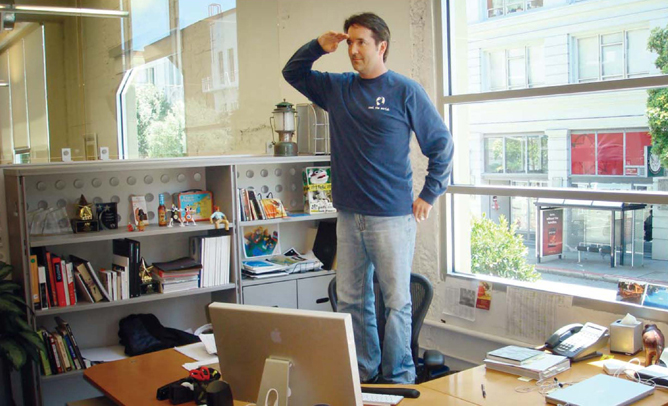

David Swope is the busiest guy on the West Coast. He's enjoyed a bright career with just about every agency in San Francisco. He's turned Swope Creative into a go-to boutique that produces work for a range of clients and causes. And his day job happens to be senior art director at McCann Erickson, where he brings a strategic, media-agnostic view of advertising to the agency table.
Swope has worked with a range of clients from California Cheese to Hewlett-Packard, from FOX Sports to Star Wars. He's had plenty of clients whose names ended in “.com.” He's had to sell “infrastructure management solutions.” Three times. Despite this, his work has been recognized by the Clios, Cannes Lions, Graphis, Communciation Arts, the OBIEs, the Emmys, the Tellys, the ADDYs, the San Francisco Show, Lürzer's Archive, Creativity and Print.

I usually start by asking: Why is the brief wrong?
In 2006, Swope took on global warming with CooltheWorld. org. In 2009, he helped La Leche League of Marin get the message out to support breastfeeding acceptance. His other socially-responsible client experience includes “Flex Your Power” for California Energy Efficiency and Conservation, ZAP Electric Vehicles, Goodwill, the Long Now Foundation, Marin farmers' markets, Coral Reef Alliance and World War II Research & Preservation Society. He believes not all advertising is evil. And he drives a hybrid.
Process
“I usually start by asking: Why is the brief wrong? Because it almost always is. Most creative briefs cannot lead to good advertising unless they are developed with input from creatives — or at least a planner with some creative bones (a British accent is helpful). A fresh brief will lead to fresh ideas. As long as you have enough time to do it right.
“It's like the old story about cows that are let out of a barn. The ones who stop at the first grass they come across end up chewing well-trod bits of weeds and muddy tufts. The more adventurous cows who make it past the first (or second) pastures find the good, deep, tasty stuff. Just don't go too far and become roadkill.
“Of course, obstacles are everywhere. No budget. Weak coffee. A creative partner who's been beaten down. Focus groups. The client's wife. They all form a virtually impenetrable wall separating you from success. And then there's the problem that Crispin already did whatever you're thinking of doing.
“The painful reality is that this business is not just about finding the Big Idea. It's just as important to sell the Big Idea. So, unless you have the right attitude, advertising will kill you. For every one hundred ideas you have, it's just a fact of life that ninety-nine of your babies will die. You have to be completely okay with rejection from your partner, the creative director, the account team and the client. And if somehow your idea gets produced? Well, congratulations. Now you can be rejected by the consumer.
“The bottom line: Be Teflon. Don't let failure stick — smile and roll with it. Because when it comes to getting to the Big Idea, if you don't enjoy the journey, you'll never make it to the destination.”
— David Swope
Partner
“I have worked with David on more than thirty projects.
“Some have been small, quick shoots. Others have been major campaigns for some of the largest companies in the world.
“Regardless of the size of the job, David always has enthusiasm and an ‘anything is possible’ attitude. His positive energy is contagious. His method centers around being open-minded, tenacious, focused and having a healthy amount of curiosity.
“As the photographer, I am usually consulted once an idea has been developed and sold to the client. Generally, David or the ad agency's art buyer tells me the concept or message of the photos. However, David always leaves room for us to go beyond the comp/layout while still honoring the original message. The basic guideline is, do what will make the strongest ad. He is driven by this credo. The reality is, making mediocre work is a soul (and business) killer.
“On set or location, David makes certain we get the original assignment photographed and we go further to capture the best of the other possibilities. Sometimes, this may require David doing a quick sketch (on set) to show me yet a new idea that just developed through watching me shoot. This sketch may create other ideas from me that he didn't consider. It's part of the creative process and how an original ‘idea’ gets to a healthy, engaging visual.
“Most of the time, the newer ideas are what get produced and win awards.”
— Curtis Myers, Photographer, San Francisco
INSIGHTS FROM THE PROCESS CANVAS
That brick wall is big and bad. It keeps getting in the way before it's finally overcome.
Some personalities may be obstacles within the creative feedback loop: the client's wife, the jaded writer, other pros.
“Learn” is an important term. Do your research, yes, but don't forget to learn.

“FLOOD” POSTER
Agencies: McGuire & Co.; Brainchild Creative, San Francisco Campaign Director: Walter McGuire Concept and Copy: Jef Loeb Art Director: David Swope Photographer: Curtis Myers Client: Flex Your Power
RANDY TATUM
VICE PRESIDENT/GROUP CREATIVE DIRECTOR, MARTIN | WILLIAMS (MINNEAPOLIS, MINNESOTA)

© 2010 Sean Kennedy Santos

Randy Tatum feels lucky. He spent a couple of years in Chicago and a nice ten-year run at Carmichael Lynch in Minneapolis before making the switch to a Martin|Williams vice-presidency and creative director post. Over his career, he's created work for brands including Harley-Davidson Motorcycles and MotorClothes, IKEA, Coca-Cola, Target, Tractor Supply Company, A.G. Edwards, Northwest Airlines and Bolla Wines, to name a few.
He's won a few awards, too: Cannes Lions, Effies, Communications Arts, The One Show, D&AD, the MPA Kellys, Clios, Adweek's Best and his personal favorite, ESPN's inclusion of his TV spot “Chevy Snowstorm” as one of the top ten Michael Jordan TV commercials ever produced.
If lucky means more than a decade of hard work, magic with light and photos, a way with clients and partners and colleagues, and a surefire designer's eye, then Tatum's been so. For now, let's just say he's earned his corner office.

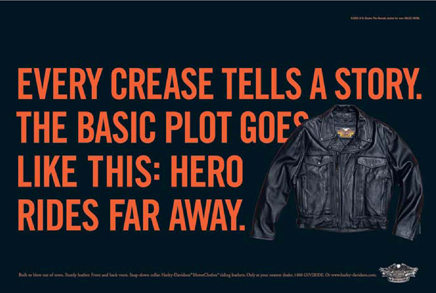
“EVERY CREASE” MAGAZINE AD
Agency: Martin | Williams, Minneapolis Creative Director: Jim Nelson Art Director: Randy Tatum Writer: Tom Camp Photographer: Shawn Michienzi Client: Harley-Davidson MotorClothes
Process
“Here's how it happens:
“It starts off with a few ideas that you know are children that have ten fingers and ten toes but possess no real motor skills. But ‘Hey, no worries, we just got going,’ you say. ‘We'll come up with something tomorrow. Let's play pool.’ Then it all goes dark. And the terrifying realization that it's finally, officially over — you're done, you've got nothing, all the ideas are gone, and you'll be turning in your club membership card — firmly takes hold in the insect portion of your brain. That lasts anywhere from forty-eight to seventy-two hours. It's horrible. The worst. Then something happens. You see something. Your partner says something. Somebody thinks something. And the beautiful chase begins again for the Idea.
“And that's what it is all about.”
— Randy Tatum
Partner
“The secret of creative genius is that it really isn't genius — it's perseverance. Most people think it's the ‘aha’ moments that hit you in the shower that turn into Gold Lions at Cannes. If that were true, we'd have a world full of better smelling creatives.
“Randy Tatum is part of the shortlist I've come across who can conjure up and then capture the creative process over and over. Watching Randy continually bag the big idea throughout his career has motivated me and the teams around him to keep pushing, to never settle, to peek under every rock — until you find a gem.
“The process is organic, frenetic, layered and unpredictable. It takes throwing hundreds of ideas up on the wall to find one or two good enough to pursue. It takes a rare discipline to let go of good, to continue the search for gold.
“Simply put, Randy is a maniac. I've seen him kill more good ideas then the average art director sees in his life. And that level of crazy — or passion — is what it takes. It's a labor of love. Hacking away at good ideas until only the great remain.
“Nurturing those solid ideas is where the fun of creating comes in. You have these little idea sprouts… now how do you grow them into sustainable, self-sufficient concepts? What personality do you give them? What kind of voice will it have? Only by trial and error, risk and reward, do the best ideas become great ads. That ability to keep pushing through the clutter separates the Randys from the rest.”
— Kathy Umland, Vice President/Director of Creative Operations, Martin | Williams, Minneapolis
INSIGHTS FROM THE PROCESS CANVAS
“Go” is where it starts. Why is that sometimes the hard part?
The complexity of the process is complete with obstacles and multiple paths to a solution.
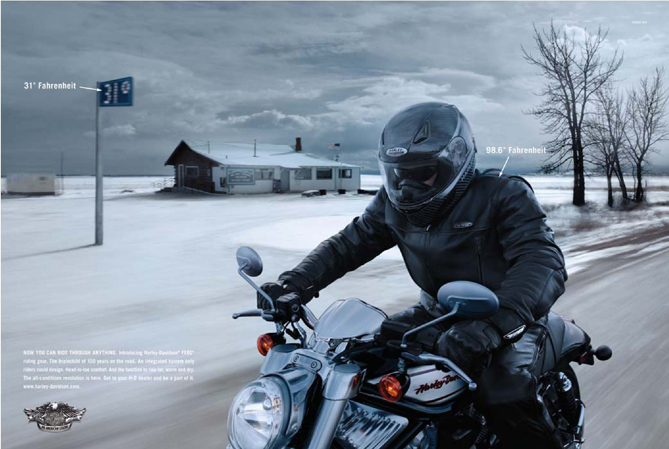
“FAHRENHEIT” MAGAZINE AD
Agency: Martin | Williams, Minneapolis Creative Director/Art Director: Randy Tatum Writer: Eric Sorensen Client: Harley-Davidson MotorClothes
DEACON WEBSTER
FOUNDER/CHIEF CREATIVE OFFICER, WALRUS (NEW YORK, NEW YORK)
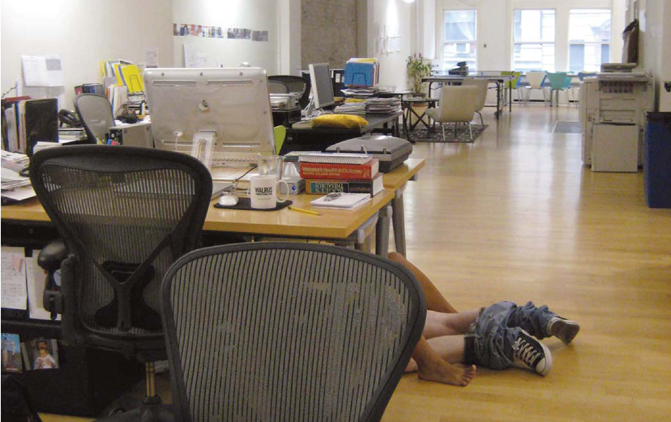

A great name that will help fans and clients follow your progress? Check. Small, hot-shop creative experience that earns you a reputation for the offbeat? Check. A hip Union Square office (that you own) with built-in sense of humor and brave clients? Check. In the creative world, Deacon Webster pretty much has it made.
After graduating from college in 1995, Webster began his career as a writer at Mad Dogs & Englishmen in New York doing award-winning work for accounts such as Moviefone, Yoo-Hoo, Road Runner High Speed Online and Friends of Animals. He was a quick study. He founded the Mad Dogs San Francisco office in 2000 before bouncing back to the New York office to become executive creative director two years later.
Walrus, a nimble agency Webster founded five years ago after Mad Dogs shuttered, does a little of everything. Its clients include Howard Stern On Demand, The Economist, Major League Baseball, Grand Marnier, Lucky Brand Jeans and Liz Claiborne. Clients have come to expect the unexpected from Walrus.
To date, Webster's work has been recognized by The One Show, D&AD, the Art Directors Club, Communication Arts and the Clios. A stack of awards and honors to validate a unique portfolio of work? Check.

When a campaign finally goes live, I get really anxious, but in a good way. It's kind of like when you get all excited about giving somebody a present and you can't wait for them to open it.
Process
“Each new assignment is like a big, complex puzzle that has to be solved in its own way, but basically it always boils down to the same thing: ‘How do we say this without making people think we're just some annoying ad?’ When a campaign finally goes live, I get really anxious, but in a good way. It's kind of like when you get all excited about giving somebody a present and you can't wait for them to open it. Rationally, I'm highly confident that it's going to be great, but there's always this glimmer of doubt. It's as if there's this cranky, little, naysayer gnome that lives in my head and says stuff like, ‘That is the STUPIDEST thing I've ever heard,’ and ‘Now you've done it, they're FINALLY going to figure out that you're really just a janitor.’ Then, of course, it all goes well and the gnome goes into hiding for a day or two until the next campaign comes around.”
— Deacon Webster

“SQUIRRELS” AMBIENT MEDIA
Agency: Mad Dogs & Englishmen, New York Creative Director: Dave Cook Art Director: Darren Lim Writer: Deacon Webster Client: Friends of Animals
Partner
“Deacon. What goes on in that mind of his? He sits staring at a layout pad, Sharpie in hand… rarely in front of a computer, if I remember correctly. His expression always seems quite serious… deeply concerned… like something profound is bothering him… niggling him. At this point he could be thinking anything. The meaning of life? How a gourd can grow so large? What is wrong with the New York Jets' offense? Every few minutes he may spontaneously begin nodding, then the long sigh, and silence again. He's supposedly a writer, but he never seems to write much. He just draws strange caricatures, oddities, doodles… pages and pages of these, one after the other. He mutters… he scratches an ear. An hour passes. His mind is now journeying, he's in transit, somewhere in the middle of India, or wandering around inside his mother's uterus… then... all of a sudden… a broad satisfied grin slowly stretches its way across his weathered, gentle face, like he just solved the New York Times' Friday crossword puzzle. It's over. He has it. He's done it. It? What is it? Who is this madman? What kind of a name is Deacon anyway?”
— Nick Cohen, Executive Creative Director, Wieden+Kennedy, Shanghai, China
INSIGHTS FROM THE PROCESS CANVAS
Details, notes in margins: a description of a favorite pen, the curve of beautiful bottles, funny lists. The little things are big.
Presentation of an idea is an opportunity to learn and to refine. Reactions and feedback are valuable.